YEALINK T46G IP Phone User Manual SIP T46G 1 User Guide V70x
YEALINK (XIAMEN ) NETWORK TECHNOLOGY CO., LTD. IP Phone SIP T46G 1 User Guide V70x
YEALINK >
Users Manual

About This Guide
i
About This Guide
Thank you for choosing this Gigabit Color IP Phone which is especially designed for
power users in the office environment. This unit provides business telephony features
such as Call Hold, Call Transfer, Busy Lamp Field, Shared Line, Hot Desking and
Conference over an IP network.
This guide provides everything you need to quickly use your new phone. Be sure to
verify with your system administrator that your network is prepared for configuring your
IP phone. As well, be sure to read the Packing List and Regulatory Notices sections in
this guide before you set up and use the SIP-T46G IP phone.
If this is your first time using the SIP-T46G IP phone, we recommend that you first refer to
the Quick Installation Guide and Quick Reference Guide.
In This Guide
This guide is based on firmware version 70. The topics provided in this guide include:
z Chapter 1 Overview
z Chapter 2 Getting Started
z Chapter 3 Customizing Your Phone
z Chapter 4 Basic Call Features
z Chapter 5 Advanced Phone Features

Any Changes or modifications not expressly approved by the party responsible for compliance could
void the user's authority to operate the equipment.
User Guide SIP-T46G IP Phone
ii
Declaration of Conformity
This phone is in conformity with the essential requirements and other relevant provisions of
the CE, FCC.
CE Mark Warning
This device is marked with the CE mark in compliance with EC Directives 2006/95/EC and 2004/108/EC.
Part 15 FCC Rules
This device is compliant with Part 15 of the FCC Rules. Operation is subject to the following two conditions:
1. This device may not cause harmful interference. and
2. This device must accept any interference received, including interference that may cause undesired
operation.
Class B Digital Device or Peripheral
Note: This device is tested and complies with the limits for a Class B digital device, pursuant to Part 15 of the
FCC Rules. These limits are designed to provide reasonable protection against harmful interference in a
residential installation. This equipment generates, uses, and can radiate radio frequency energy and, if not
installed and used in accordance with the instructions, may cause harmful interference to radio
communications. However, there is no guarantee that interference will not occur in a particular installation.
If this equipment does cause harmful interference to radio or television reception, which can be
determined by turning the equipment off and on, the user is encouraged to try to correct the interference
by one or more of the following measures:
1. Reorient or relocate the receiving antenna.
2. Increase the separation between the equipment and receiver.
3. Connect the equipment into an outlet on a circuit different from that to which the receiver is connected.
4. Consult the dealer or an experience radio/TV technician for help.
WEEE Warning
To avoid the potential effects on the environment and human health as a result of the
presence of hazardous substances in electrical and electronic equipment, end users of
electrical and electronic equipment should understand the meaning of the crossed-out
wheeled bin symbol. Do not dispose of WEEE as unsorted municipal waste and have to
collect such WEEE separately.

Table of Contents
iii
Table of Contents
About This Guide ........................................................................... i
In This Guide............................................................................................................................... i
Table of Contents ........................................................................ iii
Overview ....................................................................................... 1
Hardware Component Instructions ..................................................................................... 1
Icon Instructions ...................................................................................................................... 3
LED Instructions ........................................................................................................................ 5
User Interfaces ......................................................................................................................... 6
Phone User Interface .......................................................................................................... 6
Web User Interface ............................................................................................................. 6
Documentations ..................................................................................................................... 9
Getting Started ........................................................................... 11
Packing List ............................................................................................................................ 11
Phone Installation ................................................................................................................. 13
Phone Initialization ................................................................................................................ 15
Phone Status .......................................................................................................................... 16
Basic Network Settings ......................................................................................................... 17
Registration ............................................................................................................................ 18
Idle Screen ............................................................................................................................. 18
Customizing Your Phone............................................................ 21
General Settings ................................................................................................................... 21
Wallpaper ........................................................................................................................... 21
Screensaver ........................................................................................................................ 22
Theme ................................................................................................................................. 23
Backlight ............................................................................................................................. 24
Contrast .............................................................................................................................. 25
Language ........................................................................................................................... 26
Time and Date ................................................................................................................... 27
Administrator Password .................................................................................................... 29
Key as Send ........................................................................................................................ 30

User Guide SIP-T46G IP Phone
iv
Keypad Lock ...................................................................................................................... 30
Audio Settings ....................................................................................................................... 34
Volu me ................................................................................................................................ 34
Ring Tones ........................................................................................................................... 34
Contact Management ........................................................................................................ 35
Local Directory .................................................................................................................. 36
Bla cklist ................................................................................................................................ 41
Remote Phonebook ......................................................................................................... 42
BroadSoft Phonebook ...................................................................................................... 43
Call History Management ................................................................................................... 45
BroadSoft Call Log ................................................................................................................ 46
System Customizations ......................................................................................................... 49
Headset Use ....................................................................................................................... 49
DSS Keys .............................................................................................................................. 49
Account Management .................................................................................................... 60
Dial Plan .............................................................................................................................. 61
Emergency Number ......................................................................................................... 65
Live Dialpad ....................................................................................................................... 65
Hotline ................................................................................................................................. 66
Basic Call Features ..................................................................... 68
Placing Calls .......................................................................................................................... 68
Answering Calls ..................................................................................................................... 70
Ending Calls ........................................................................................................................... 71
Redialing Numbers ............................................................................................................... 72
Auto Answer .......................................................................................................................... 72
Auto Redial ............................................................................................................................ 73
Call Completion.................................................................................................................... 74
Call Return ............................................................................................................................. 76
Call Mute ............................................................................................................................... 76
Call Hold/Resume ................................................................................................................. 77
Do Not Disturb (DND) ........................................................................................................... 78
Call Forward .......................................................................................................................... 79
Call Transfer ........................................................................................................................... 81
Call Waiting ........................................................................................................................... 82
Conference ........................................................................................................................... 83
Local Conference ............................................................................................................. 83
Network Conference ........................................................................................................ 84
Call Park ................................................................................................................................. 85
Call Pickup ............................................................................................................................. 86
Anonymous Call .................................................................................................................... 90
Anonymous Call Rejection .................................................................................................. 91
Advanced Phone Features ....................................................... 92

Table of Contents
v
Busy Lamp Field (BLF) ........................................................................................................... 92
BLF List ..................................................................................................................................... 95
Shared Line ............................................................................................................................ 96
Call Recording ...................................................................................................................... 97
Hot Desking ............................................................................................................................ 99
Inte rcom ............................................................................................................................... 101
Outgoing Intercom Calls ................................................................................................ 101
Incoming Intercom Calls ................................................................................................ 102
Automatic Call Distribution (ACD) ................................................................................... 103
Messages ............................................................................................................................. 105
Short Message Service (SMS) ......................................................................................... 105
Voice Mail ........................................................................................................................ 107
Message Waiting Indicator (MWI) ................................................................................ 109
Troubleshooting ........................................................................ 112
Regulatory Notices ................................................................... 118
Service Agreements ........................................................................................................... 118
Limitations of Liability .......................................................................................................... 118
Safety Instructions ............................................................................................................... 118
Appendix A - Time Zones ........................................................ 120
Index .......................................................................................... 122
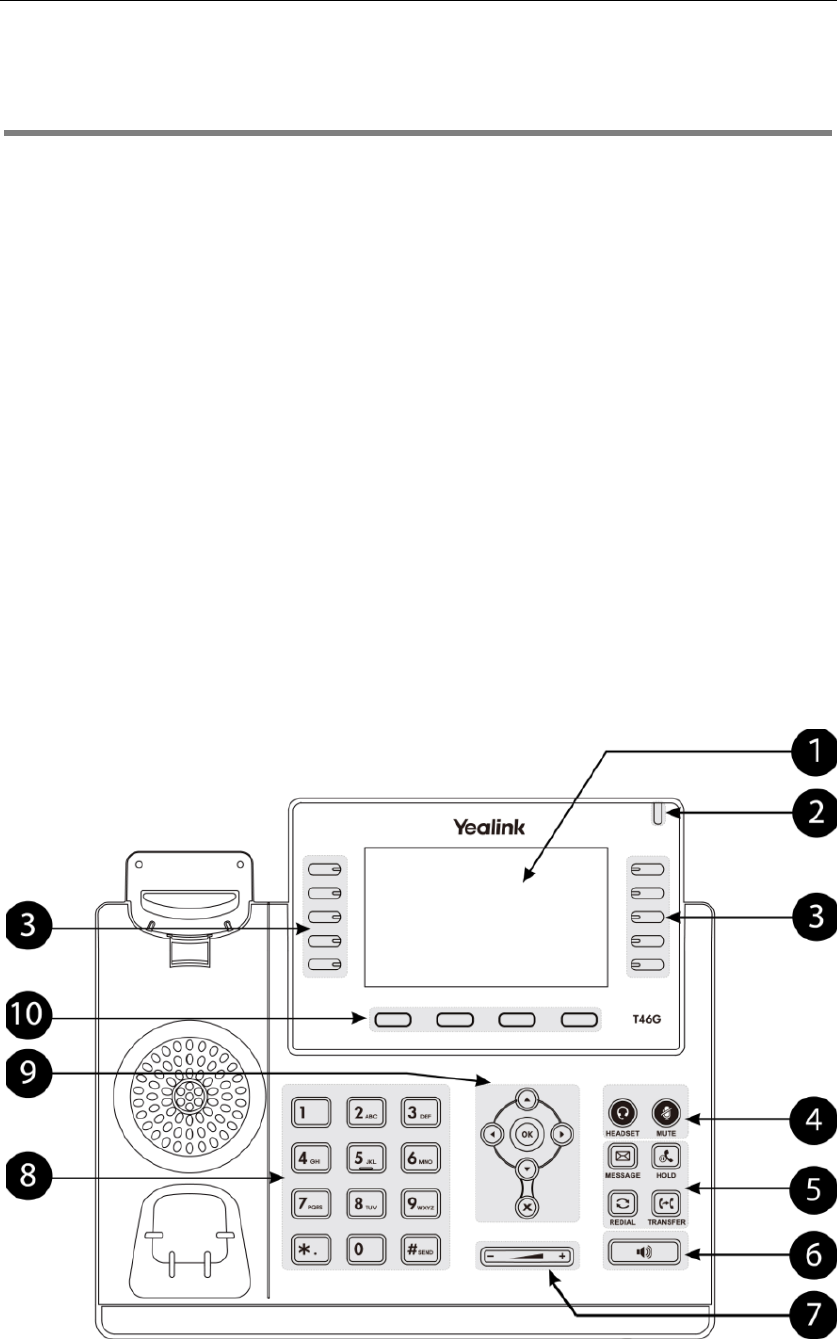
Overview
1
Overview
This chapter provides the overview of the SIP-T46G IP phone. The topics include:
z Hardware Component Instructions
z Icon Instructions
z LED Instructions
z User Interfaces
z Documentations
If you require additional information or assistance with your new phone, contact your
system administrator.
Hardware Component Instructions
The main hardware components of the SIP-T46G IP phone are the LCD screen and the
keypad.
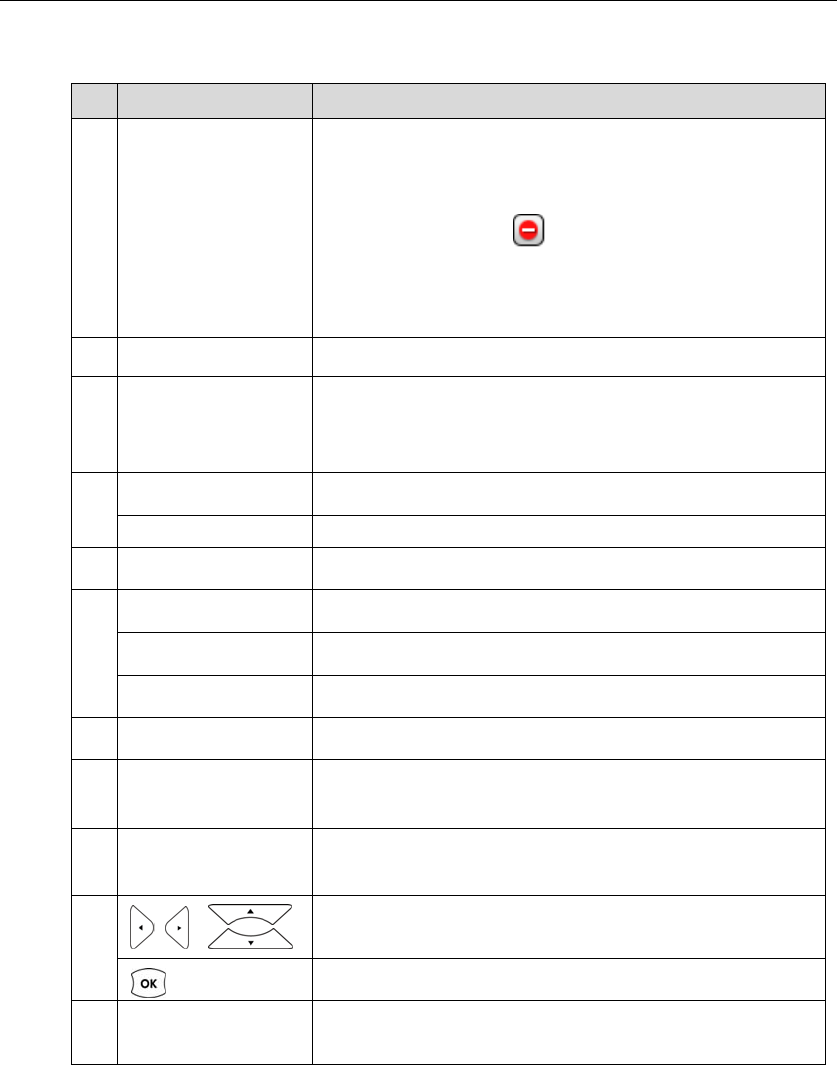
User Guide SIP-T46G IP Phone
2
Hardware component instructions of the SIP-T46G IP phone are:
Item Description
① LCD Screen
Shows information about calls, messages, soft keys, time,
date and other relevant data:
• Call information—caller ID, call duration
• Icons (for example, )
• Missed call text or second incoming caller information
• Prompt text (for example, "Saving files! Please wait…")
• Time and date
② Power Indicator LED Indicates phone power status.
③ Line Keys
Use these keys to activate up to six accounts and assign
various features. The key LED will light up when the
assigned feature is enabled.
④ MUTE Key Toggles and indicates the Mute feature on or off.
HEADSET Key Toggles and indicates the headset mode.
⑤ MESSAGE Key Indicates and accesses voice messages.
⑤
TRANSFER Key Transfers a call to another party.
HOLD Key Places a call on hold or resumes a held call.
REDIAL Key Redials a previously dialed number.
⑥ Speakerphone Key Toggles and indicates the hands-free speakerphone
d
⑦ Volume Key
Adjusts the volume of the handset, headset, speaker,
and ringer.
⑧ Keypad
Provides the digits, letters, and special characters in
context-sensitive applications.
⑨
Scroll through the displayed information.
Confirms actions or answers an incoming call.
⑩ Soft Keys Labels automatically to identity their context-sensitive
features.
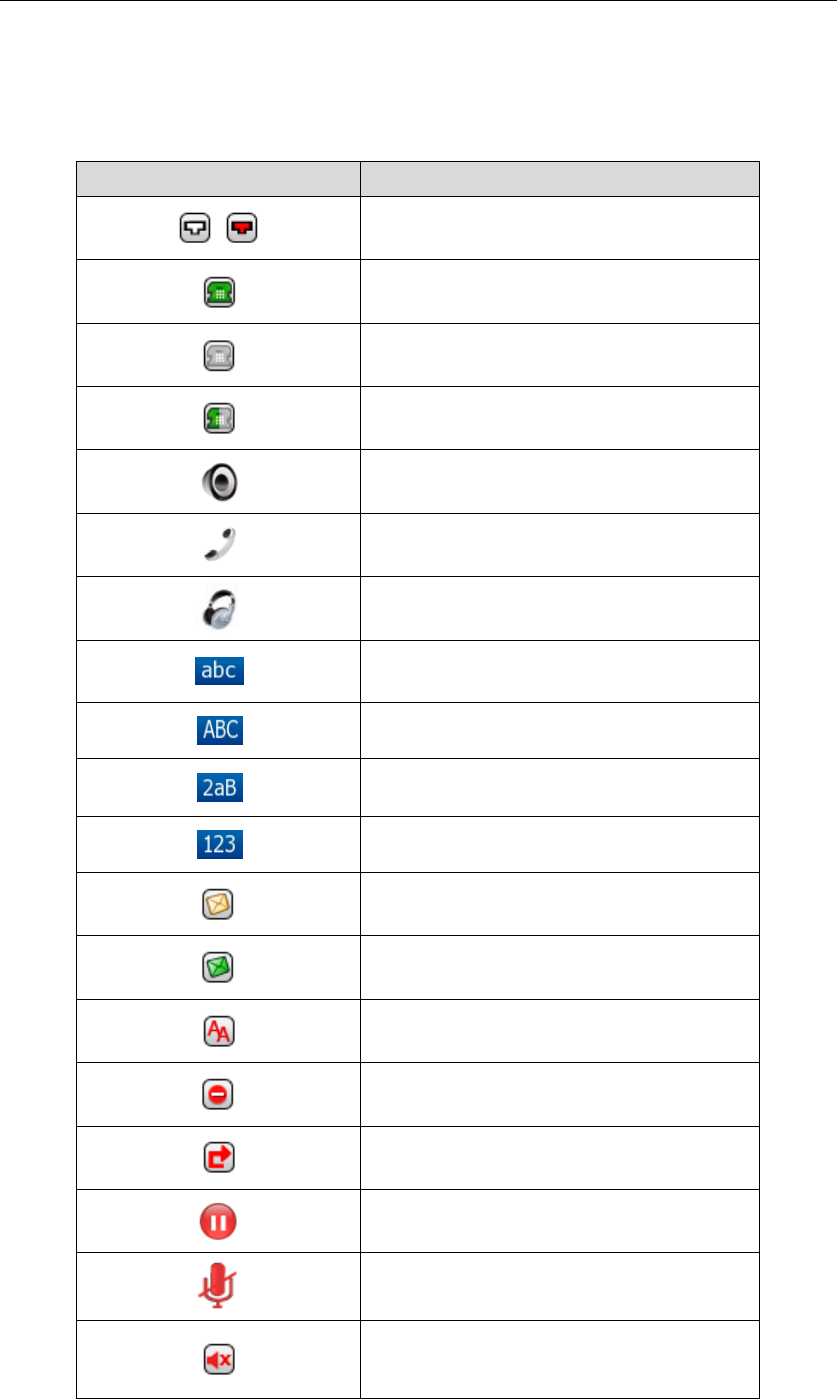
Overview
3
Icon Instructions
Icons appear on the phone LCD screen are described in the following table:
Icons Description
Network is unavailable
Registered successfully
Registered fail
Registering
Hands-free speakerphone mode
Handset mode
Headset mode
Multi-lingual lowercase letters input mode
Multi-lingual uppercase letters input mode
Alphanumeric input mode
Numeric input mode
Voice Mail
Text Message
Auto Answer
Do Not Disturb
Call Forward
Call Hold
Call Mute
Ringer volume is 0
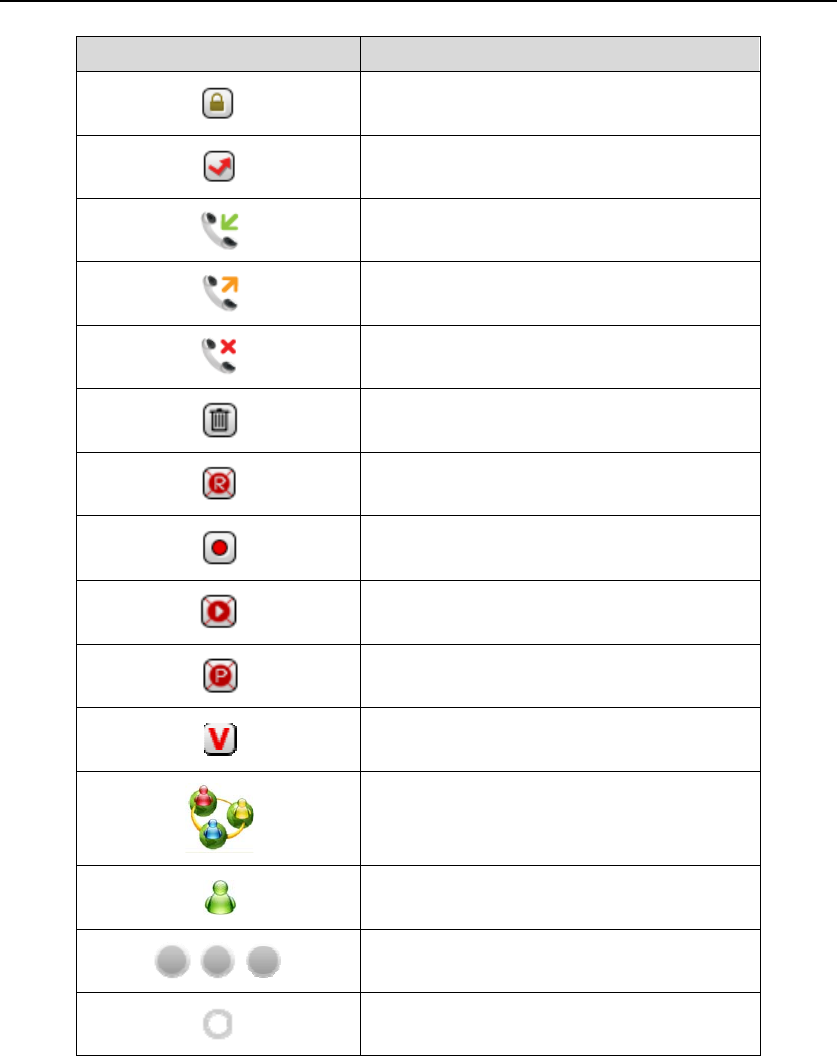
User
4
Guide SIP-T4
6
6
G IP Phone
Icons
1
2
3
Keypad Lo
c
Missed Call
Received
C
Dialed Call
s
Missed Call
Recordin
g
b
A call can
n
Recordin
g
s
Recording
c
Recording
c
Open VPN
Conferenc
e
The defaul
t
The current
The non-cu
Descri
p
ck
s
C
alls
s
s
b
ox is full
n
ot be recor
d
s
tarts succes
s
c
annot be s
t
c
annot be s
t
e
t
contact ph
o
pa
g
e of th
e
rrent pa
g
e
o
p
tion
d
ed
s
fully
t
arted
t
opped
o
to
e
line keys.
o
f the line ke
y
y
s.
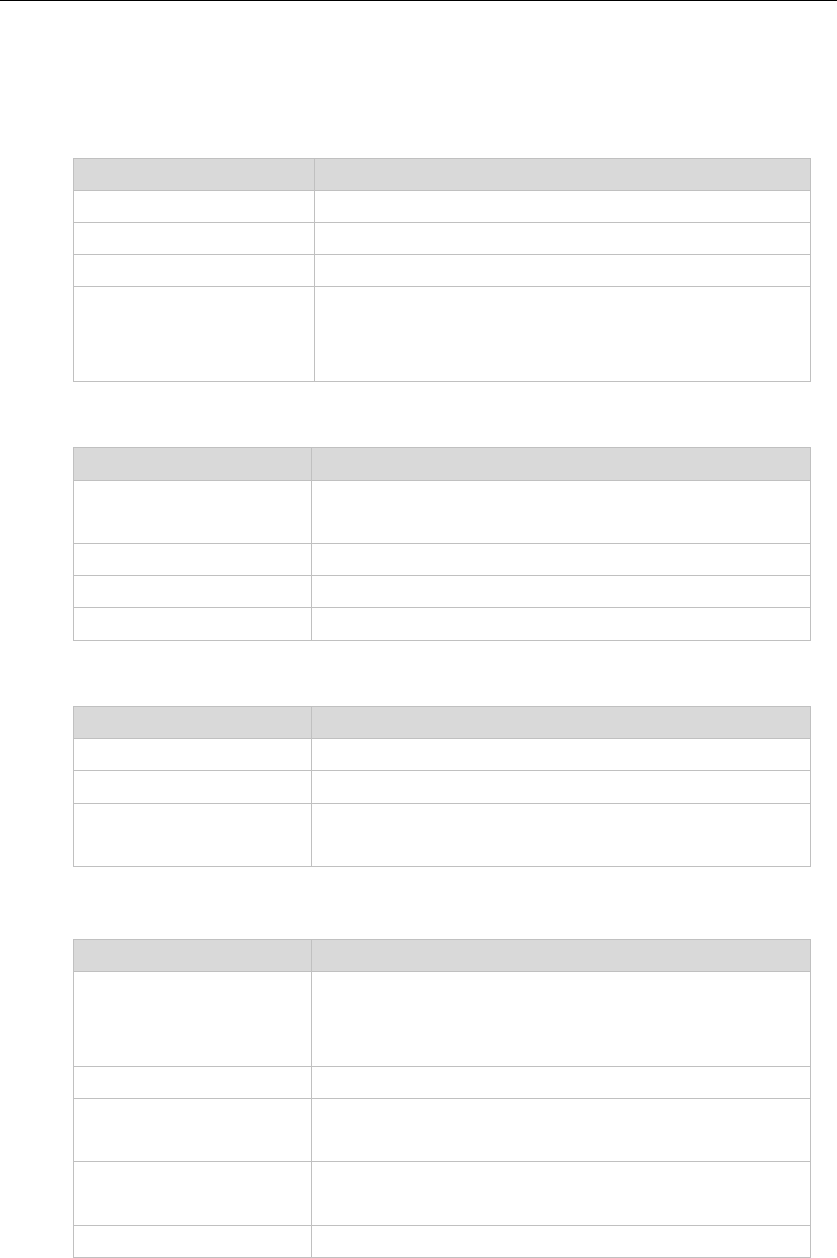
Overview
5
LED Instructions
Power Indicator LED
LED Status Description
Solid red The phone is initializing.
Fast flashing red The phone is ringing.
Slow flashing red The phone receives a text message or voice mail.
Off
The phone is powered on.
The phone is powered off.
The phone is idle.
Line key LED
LED Status Description
Solid green The line is seized.
The line is in conversation.
Fast flashing green The line receives an incoming call, the phone is ringing.
Slow flashing green The call is placed on hold.
Off The line is inactive.
Line key LED (configured as BLF key)
LED Status Description
Solid red The monitored user is busy.
Fast flashing red The monitored user receives an incoming call.
Off The monitored user is idle.
The monitored user does not exist.
Line key LED (configured as shared line key)
LED Status Description
Solid red
The shared line is seized.
Some party receives the ringback.
The shared line is in conversation.
Fast flashing green The shared line receives an incoming call.
Slow flashing red The shared line conversation is placed on public hold.
The shared line conversation is placed on private hold.
Slow flashing orange For multi-party call, all the parties place the shared line
conversation on hold.
Off All the parties are idle.

User Guide SIP-T46G IP Phone
6
User Interfaces
There are two ways to customize specific configurations on your SIP-T46G IP phone:
z Using the user interface on the IP phone.
z Using the user interface in an internet browser window from your PC.
The hardware components keypad and LCD screen constitute the phone user
interface, which allows the user to execute all call operation tasks and basic
configuration changes directly on the phone. In addition, you can use the web user
interface to access all configuration settings. In many instances, it is possible to use both
the phone user interface and the web user interface to operate the phone and
change settings. However, in some instances, it is only possible to use the phone or the
web user interface.
Phone User Interface
You can customize your phone by pressing the Menu soft key to access the phone user
interface. The "Advanced Settings" options are administrator level features only, the
default password is admin (case-sensitive). For more information on customizing your
phone using the available options from the phone user interface, refer to Customizing
Your Phone on page 21.
Web User Interface
In addition to the phone user interface, you can also customize your phone via web
user interface. In order to access the web user interface, you need to know the IP
address of your new phone. To obtain the IP address, press the OK key on the phone.
Enter the IP address (e.g. http://192.168.0.10 or 192.168.0.10) in the address bar of web
browser on your PC. The default user name is admin (case-sensitive) and the password
is admin (case-sensitive).
The options you can use to customize the IP phone via phone user interface and/or via
web user interface are listed in the following table:
Options Phone User Interface
Web User Interface
Status
--IP
--MAC
--Firmware
--Network
--Phone
--Accounts
√ √

Overview
7
Options Phone User Interface
Web User Interface
Basic Call Features
--Auto Answer
--Auto Redial
--Call Completion
--Call Forward
--Call Waiting
--Call Park
--Call Pickup
--Call Return
--Call Waiting
--Conference
--Anonymous Call
--Anonymous Call Rejection
--DND
√
√
√
√
√
√
√
√
√
√
√
√
√
Basic Phone Settings
--Language
--Time & Date
--Administrator Password
--Ring Tones
--Contrast
--Backlight
--Wallpaper
--Screensaver
--Theme
--Call Waiting
--Keypad Lock
--Phone Volume
--Call History Management
--BroadSoft Call Log
--Contact Management
--Local Directory
--Blacklist
--Remote Phonebook
--BroadSoft Phonebook
--Dial Plan
--DSS Keys
--Key as Send
--Hotline
--Live Dialpad
--Emergency
√
√
√
√
√
√
√
√
√
√
√
√
√
√
√
√
√
√
√
√
√

User Guide SIP-T46G IP Phone
8
Options Phone User Interface
Web User Interface
Advanced Phone Features
--BLF
--BLF List
--Shared Line
--Intercom
--Call Recording
--Hot Desking
--ACD
--Messages
√
√
√
√
√
√
√
SIP Account
--User Options
--Register Status
--Activation
--Label
--Display Name
--Register Name
--User Name
--Password
--SIP Server
--Server Option
--Registrar Port
--Outbound Status
--Outbound Proxy
--Backup Outbound Proxy
--NAT Traversal
--STUN Status
--STUN Server
√
√
√
√
√
√
√
√
√
√
√
√
√
√
Note
The table above lists most of the feature options. Please refer to the relevant sections for
more information.

Overview
9
Documentations
The following table shows documentations available for the SIP-T46G IP phone.
Name Contents Where found Format/ Language
Quick Installation
Guide
Basic set up of the
phone
In the
package PDF/English
Quick Reference
Guide
Basic call features
and phone
customizations
In the
package PDF/English
User Guide
Phone/Web user
interface settings
Basic call features
and advanced
phone features
CD attached
in the package
PDF/English
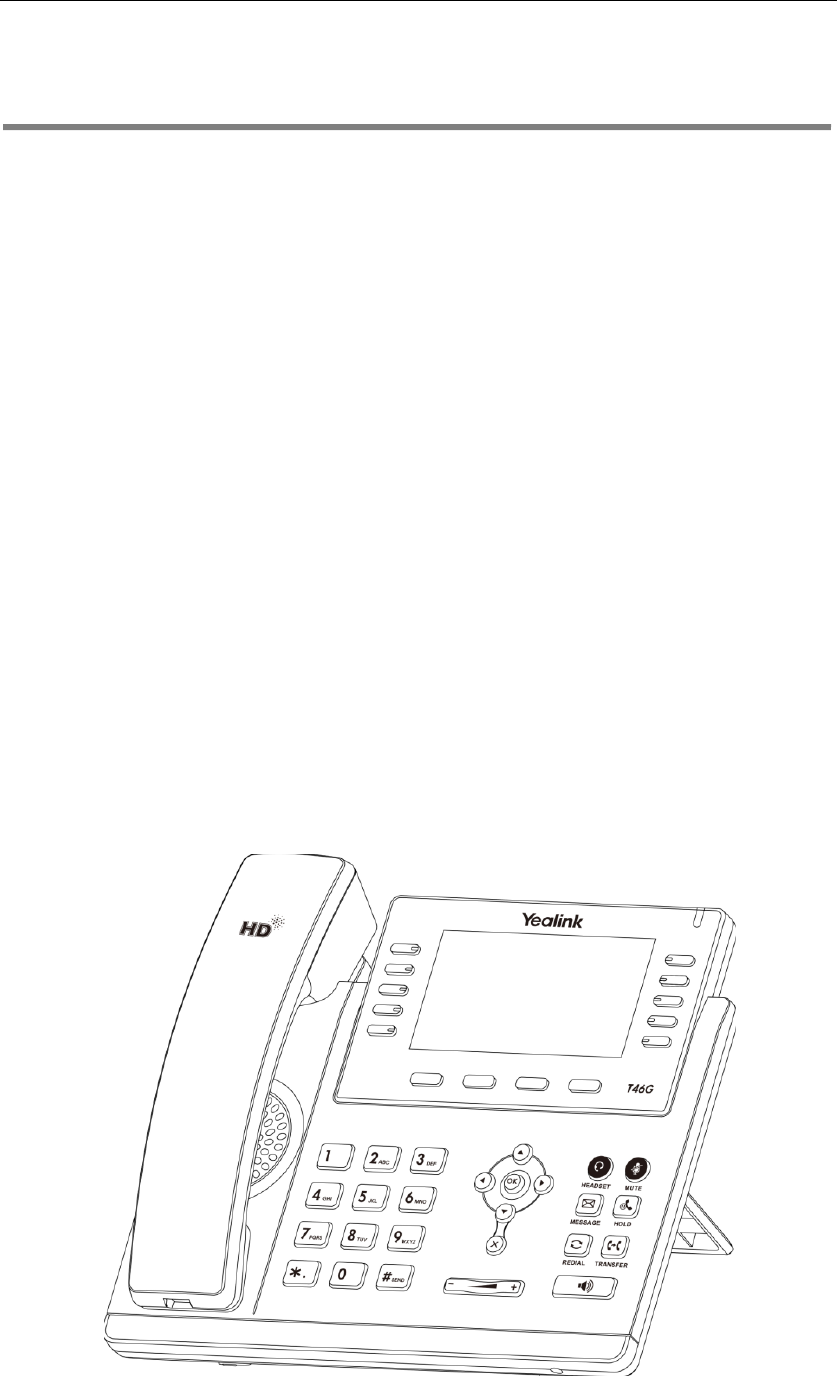
Getting Started
11
Getting Started
This chapter provides basic installation instructions and information for obtaining the
best performance with the SIP-T46G IP phone. The topics include:
z Packing List
z Phone Installation
z Phone Initialization
z Phone Status
z Basic Network Settings
z Registration
z Idle Screen
If you require additional information or assistance with your new phone, contact your
system administrator.
Packing List
The following components are included in your SIP-T46G IP phone package:
z SIP-T46G IP phone
z Phone Stand
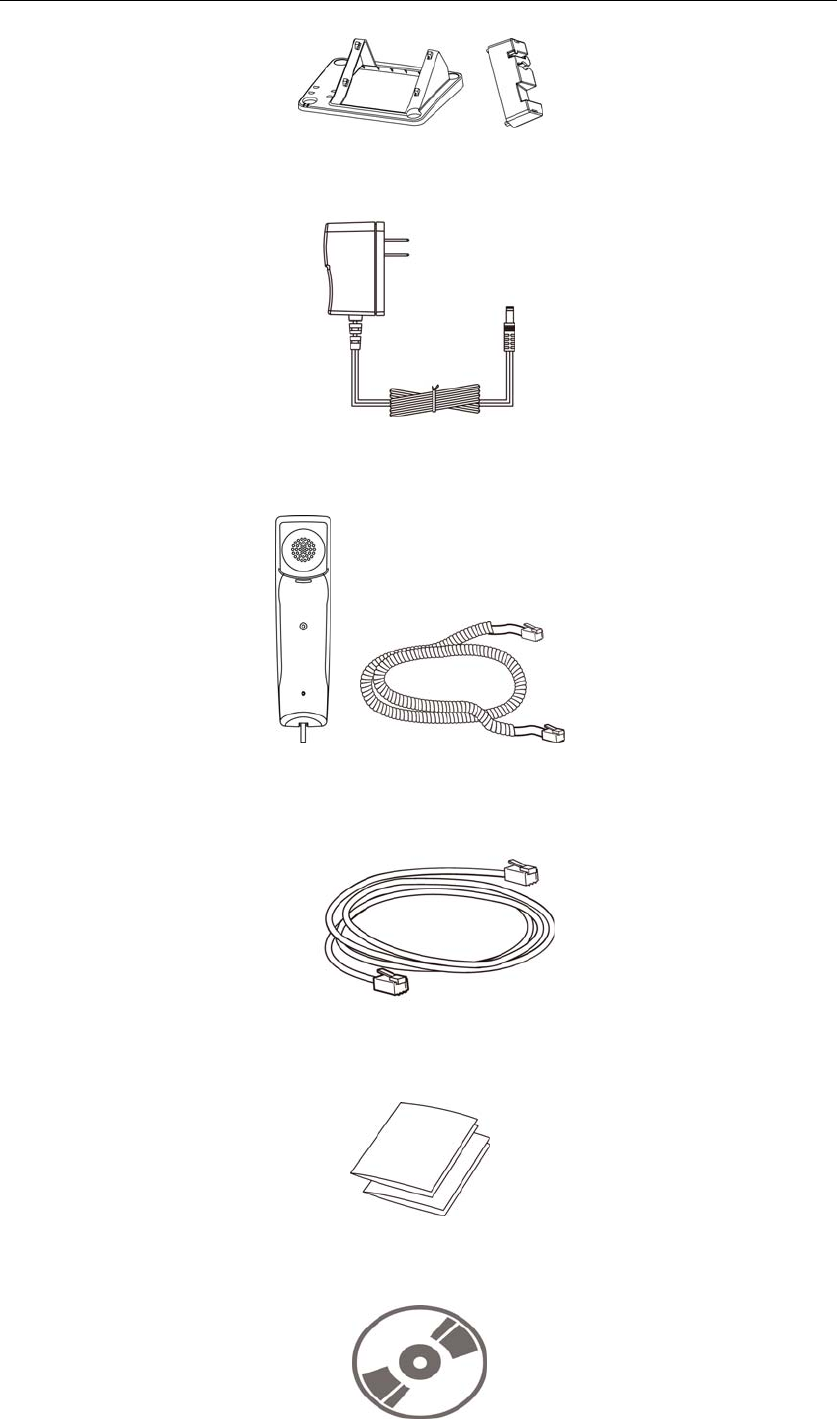
User Guide SIP-T46G IP Phone
12
z Power Adapter
z Handset & Handset Cord
z Ethernet Cable
z Quick Installation Guide & Quick Reference Guide
z CD-ROM
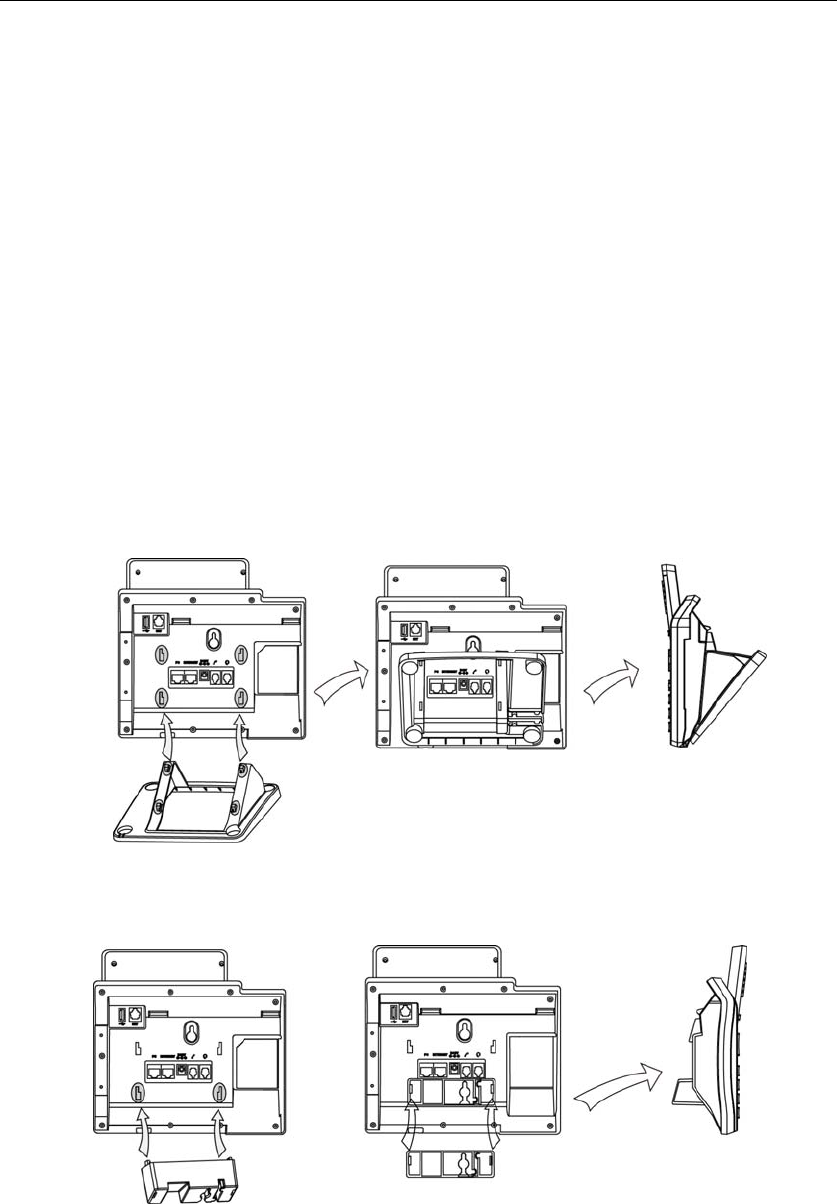
Getting Started
13
Check the list before installation. If you find anything missing, contact your system
administrator.
Phone Installation
If your phone is already installed, proceed to Phone Initialization on page 15.
This section introduces how to install the phone with the components in the packing list:
z Attach the Stand
z Connect the Handset and optional Headset
z Connect the Network and Power
1) Attach the Stand:
a. Deskmount Method:
b. Wallmount Method:
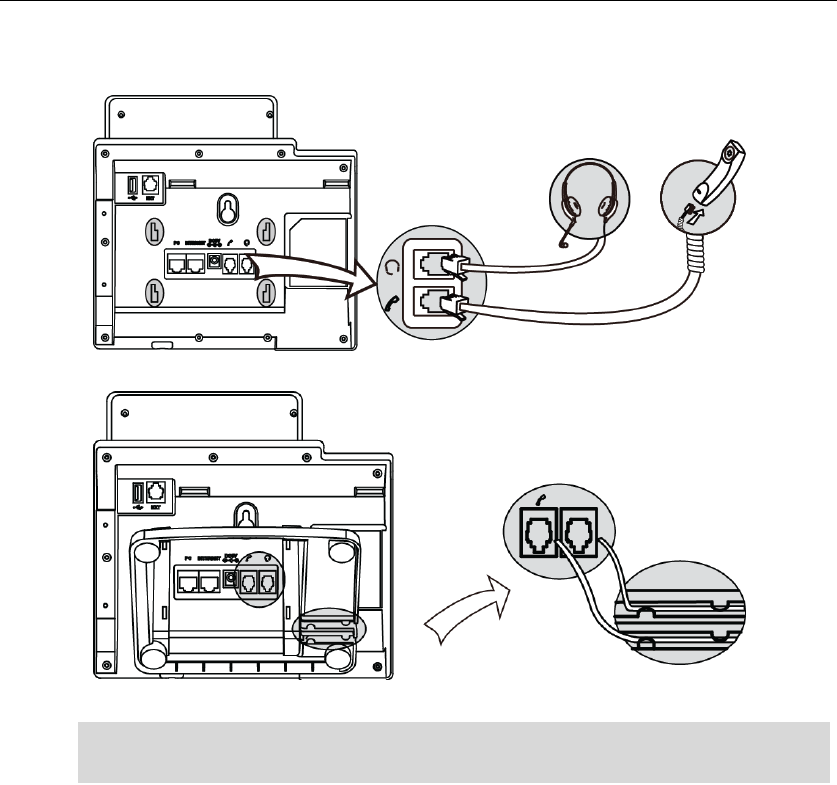
User Guide SIP-T46G IP Phone
14
2) Connect the Handset and optional Headset:
Note
3) Connect the Network and Power:
You have two options for power and network connections. Your system administrator
will advise you which one to use.
z AC power
z Power over Ethernet (PoE)
AC Power
To connect the AC power:
1. Connect the DC plug on the power adapter to the DC5V port on the phone and
connect the other end of the power adapter into an electrical power outlet.
A headset is not provided in the packing list. Contact your system administrator for more
information.
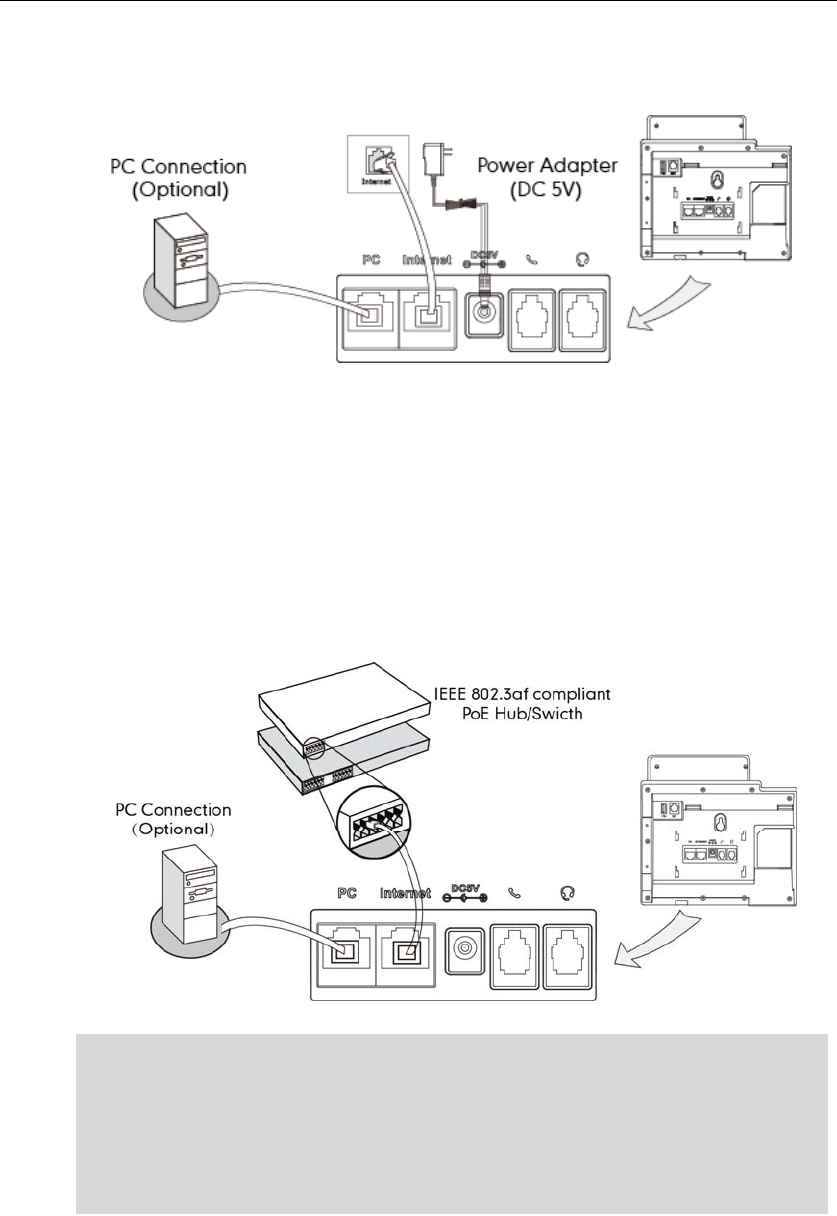
Getting Started
15
2. Connect the supplied Ethernet cable between the Internet port on the phone and
the Internet port in your network or switch/hub device port.
Power over Ethernet
Using a regular Ethernet cable, the SIP-T46G IP phone can be powered from a PoE (IEEE
802.3af) compliant switch or hub.
To connect the PoE:
1. Connect the Ethernet cable between the Internet port on the phone and an
available port on the in-line power switch/hub.
Note
Phone Initialization
After your phone has been powered up, the system boots up and performs the
following steps:
If in-line power is provided, you don’t need to connect the AC adapter. Make sure the
Ethernet cable and switch/hub is PoE compliant.
The phone can also share the network with other network device such as a PC (personal
computer). It is an optional connection.
Important! Do not unplug or remove power to the phone while it is updating firmware
and configurations.
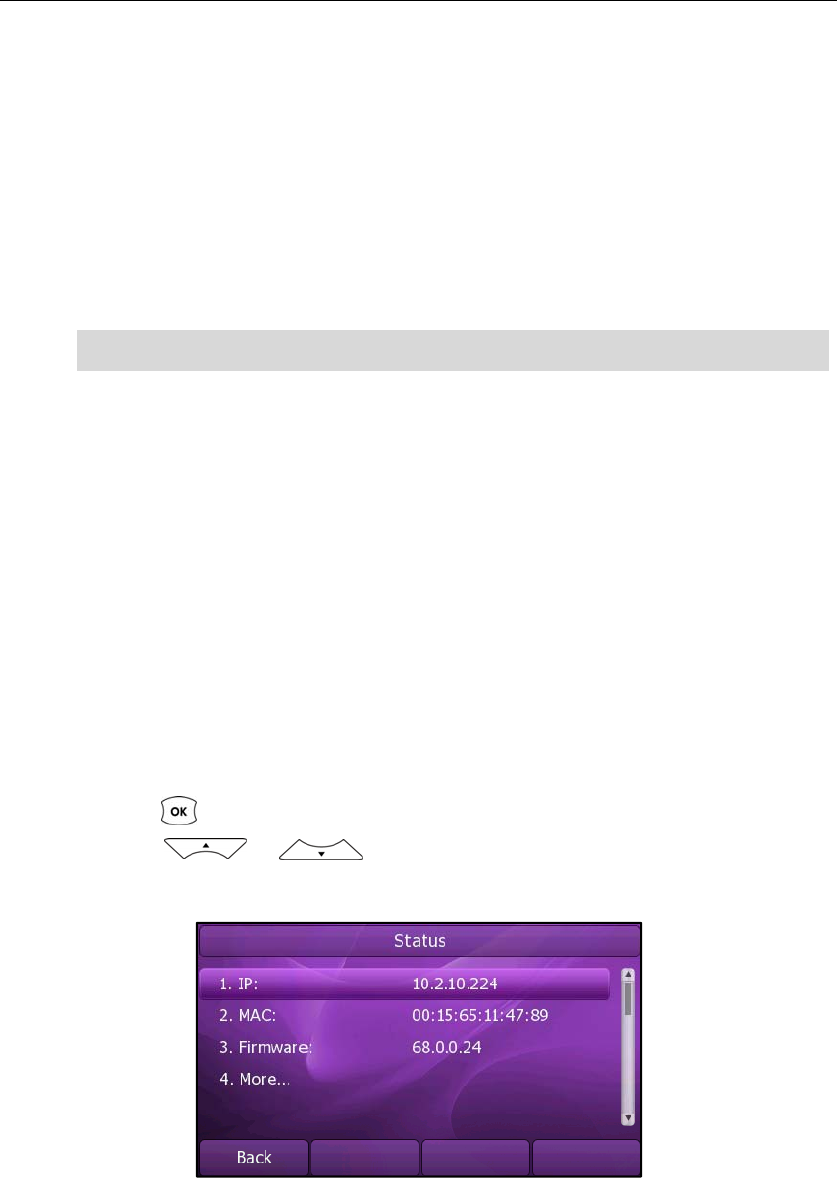
User Guide SIP-T46G IP Phone
16
Automatic Phone Initialization
The phone finishes the initialization process by loading the saved configuration. The
phone LCD screen will display "Initializing…Please wait" during the initialization.
DHCP (Dynamic Host Configuration Protocol)
By default the phone attempts to contact a DHCP server in your network in order to
obtain its valid network settings, e.g. IP address, subnet mask, default gateway, DNS
server.
Note
Phone Status
You can view the system status of your phone via phone user interface or web user
interface.
Available information of phone status includes:
z Network status including WAN port and LAN port information.
z Phone status including device model, firmware version and MAC address.
z Account status indicating the register status of sip accounts.
To view the phone status via phone user interface:
1. Press , or press Menu->Status.
2. Press or to scroll through the list and view the specific
information.
To view the phone status via web user interface:
1. Open the web browser of your computer.
2. Enter the IP address in the browser’s address bar, and then click Enter.
3. Enter the User Name (admin) and Password (admin) in the pop-up dialogue box.
4. Click OK to login.
If your network does not use DHCP, proceed to Basic Network Settings on page17.
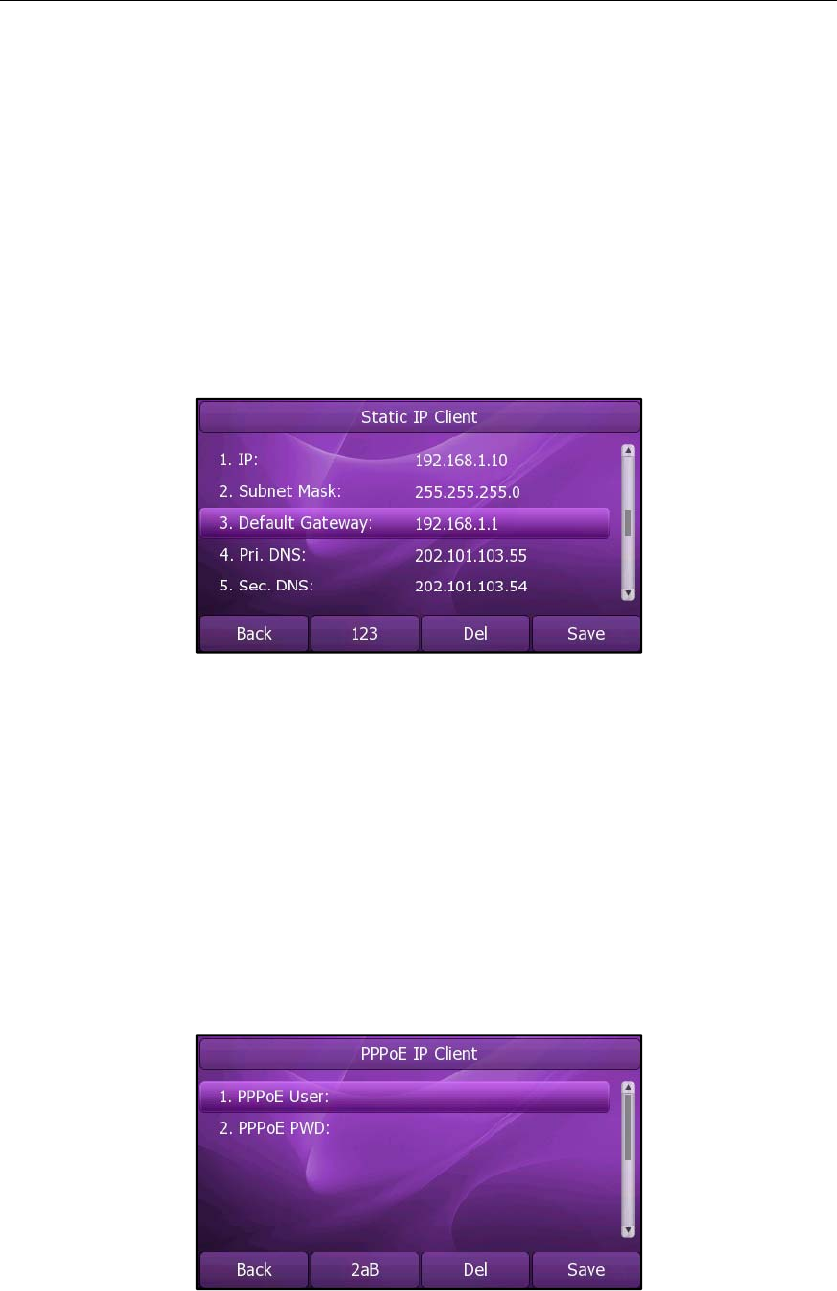
Getting Started
17
Basic Network Settings
If your phone cannot contact a DHCP server for any reason, you need to configure a
static IP address manually.
To configure a static IP address via phone user interface:
1. Press Menu->Setting->Advanced Settings (password: admin) ->Network->WAN
Port->Static IP Client.
2. Enter the parameters: IP, subnet mask, default gateway, primary DNS, second DNS
in the corresponding fields.
3. Press the Save soft key to accept the change or the Back soft key to cancel.
If you are using an xDSL modem, you can connect your phone to the Internet via PPPoE
mode. You can set a WAN port to be a PPPoE port. The PPPoE port will perform a PPP
negotiation to obtain the IP address. Contact your system administrator for the PPPoE
username and password.
To configure PPPoE via phone user interface:
1. Press Menu->Setting->Advanced Settings (password: admin) ->Network->WAN
Port->PPPoE IP Client.
2. Enter the username and password in the corresponding fields.
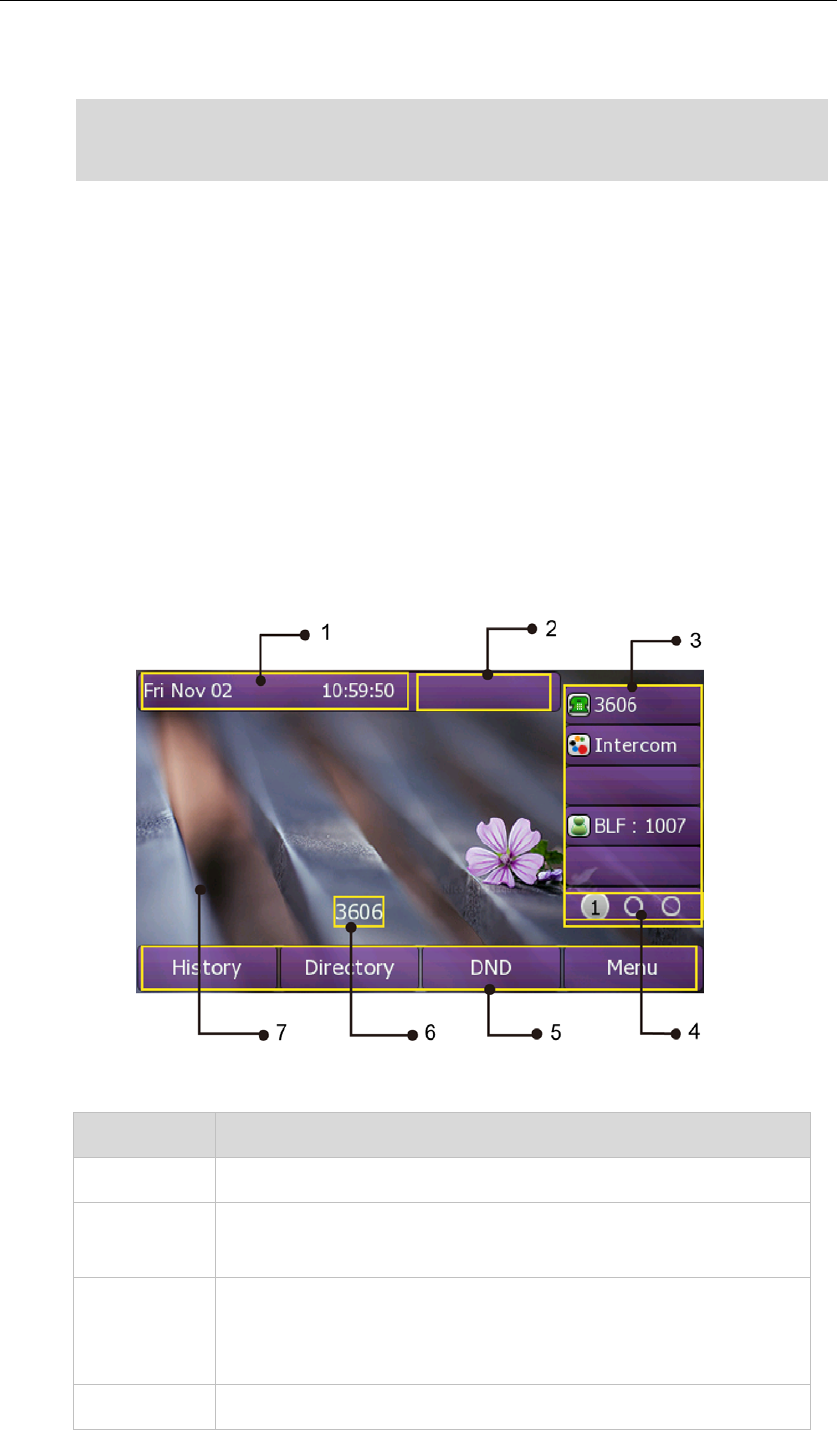
User Guide SIP-T46G IP Phone
18
3. Press the Save soft key to accept the change or the Back soft key to cancel.
Note
Registration
Generally, your phone will be deployed with multiple other phones. In this case, your
system administrator will configure the phone parameters beforehand, so that after you
start up your phone, the phone will be registered and ready to use. If your phone is not
registered, you may have to register it. For more information on how to register your
phone, refer to Account Management on page 60.
Idle Screen
If the phone has successfully started up, the idle LCD screen is shown as below:
Idle Screen description:
No. Description
1 This area shows the phone’s time & date.
2 This area shows the phone feature status. For more information
you can refer to Icon Instructions on page 3.
3
This area shows the six line key labels. You can also custom the line
key as other function. For more information you can refer to DSS
Keys on page 49.
4 This area shows three page icons.
Using the wrong network parameters may result in inaccessibility of your phone and may
also have an impact on your network performance. For more information about these
parameters, contact your system administrator.

Getting Started
19
5 This area shows the soft key labels. The default soft key labels are
“History”, “Directory”, “DND” and “Menu”.
6 This area shows the current account. User can use or to
choose the available account.
7 This area shows the backgrounds picture. You can also change it.
For more information you can refer to Wallpaper on page 21.

Customizing Your Phone
21
Customizing Your Phone
You can customize your SIP-T46G IP phone by configuring the setting for time and date,
display contrast, and ring tones, for example. You can add contacts to the phone’s
local directory manually or from call history. You can also handle incoming calls from
different contacts in different ways.
This chapter provides basic operating instructions for customizing your phone. The
topics include:
z General Settings
z Audio Settings
z Contact Management
z Call History Management
z BroadSoft Call Log
z System Customizations
If you require additional information or assistance with your new phone, contact your
system administrator.
General Settings
Wallpaper
You can customize the wallpaper of the SIP-T46G IP phone. You can change the
wallpaper image via phone user interface or web user interface. You can also upload
custom wallpaper images via web user interface. The file format of wallpaper image
must be .jpg, .png or .bmp. Contact your system administrator for the detailed
requirement of the file format.
To change the wallpaper via phone user interface:
1. Press Menu->Display->Wallpaper.
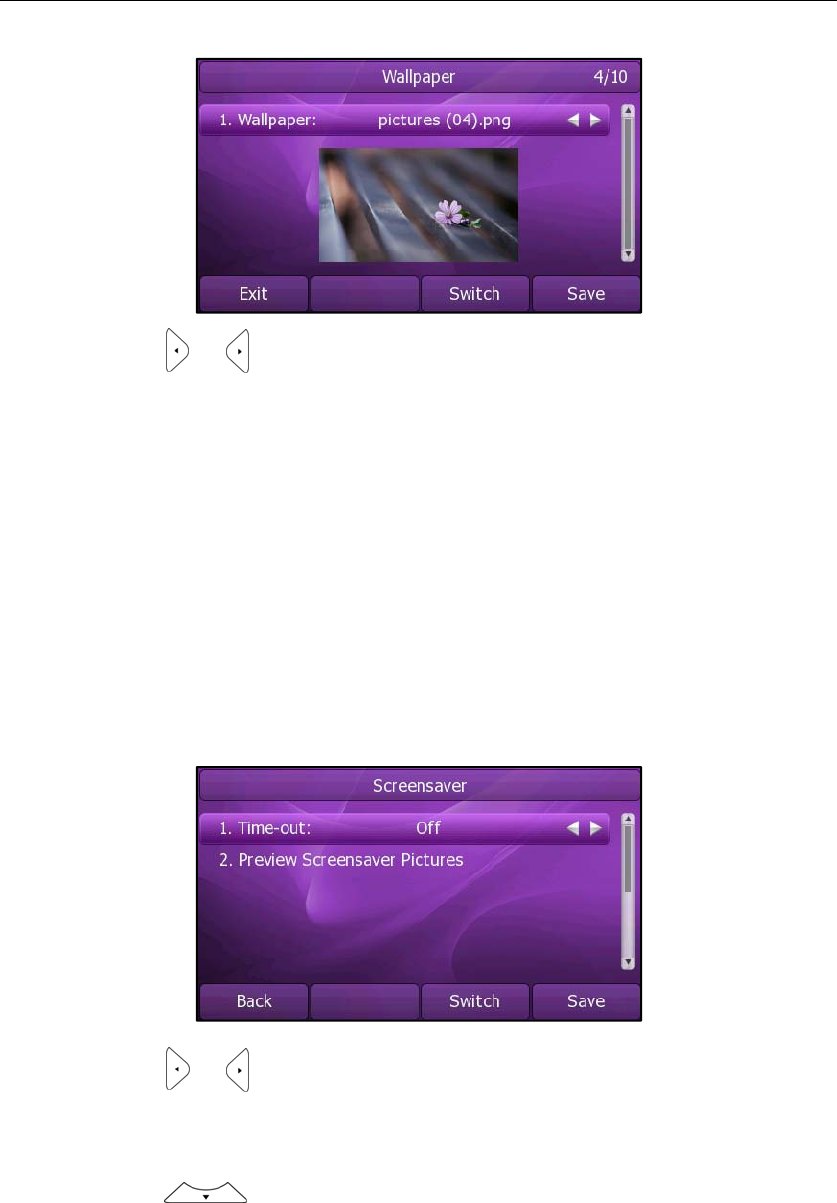
User Guide SIP-T46G IP Phone
22
2. Press or , or the Switch soft key to select the desired wallpaper image.
3. Press the Save soft key to accept the change or the Back soft key to cancel.
You can also change wallpaper via web user interface at the path Phone->Preference.
Screensaver
You can use screensaver that your phone will automatically change the pictures on the
screen during periods of user inactivity. You can configure the time out for screensaver
and preview screensaver pictures.
To configure the screensaver via phone user interface:
1. Press Menu->Display->Screensaver.
2. Press or , or the Switch soft key to select the desired time in the Time-out
field.
After the time you specified in the Time-out field, your phone will display the
screensaver.
3. Press to scroll to the Preview Screensaver Pictures field, press the Enter
soft key to preview the screensaver pictures and then press the Exit soft key to back
to the previous interface.
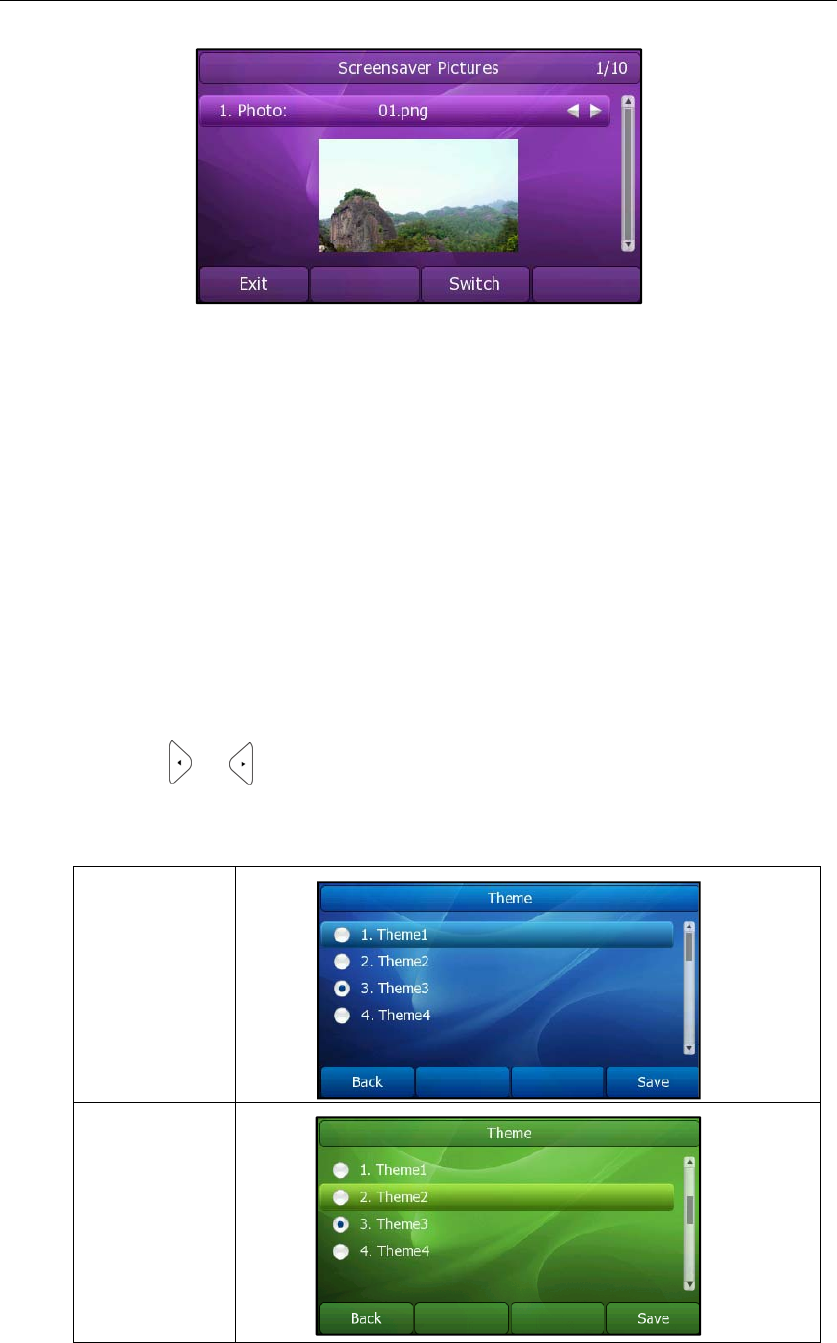
Customizing Your Phone
23
You can also configure screensaver via web user interface at the path
Phone->Preference.
Theme
The theme can make your phone display personalized desktop and distinctive visual
enjoyment. You can change the theme for the phone via phone user interface and
web user interface.
To change the theme via phone user interface:
1. Press Menu->Display->Theme.
2. Press or to select the desired theme.
3. Press the Save soft key to accept the change or the Back soft key to cancel.
The following table lists the four themes supported by the T46G IP phone.
Theme 1
Theme 2
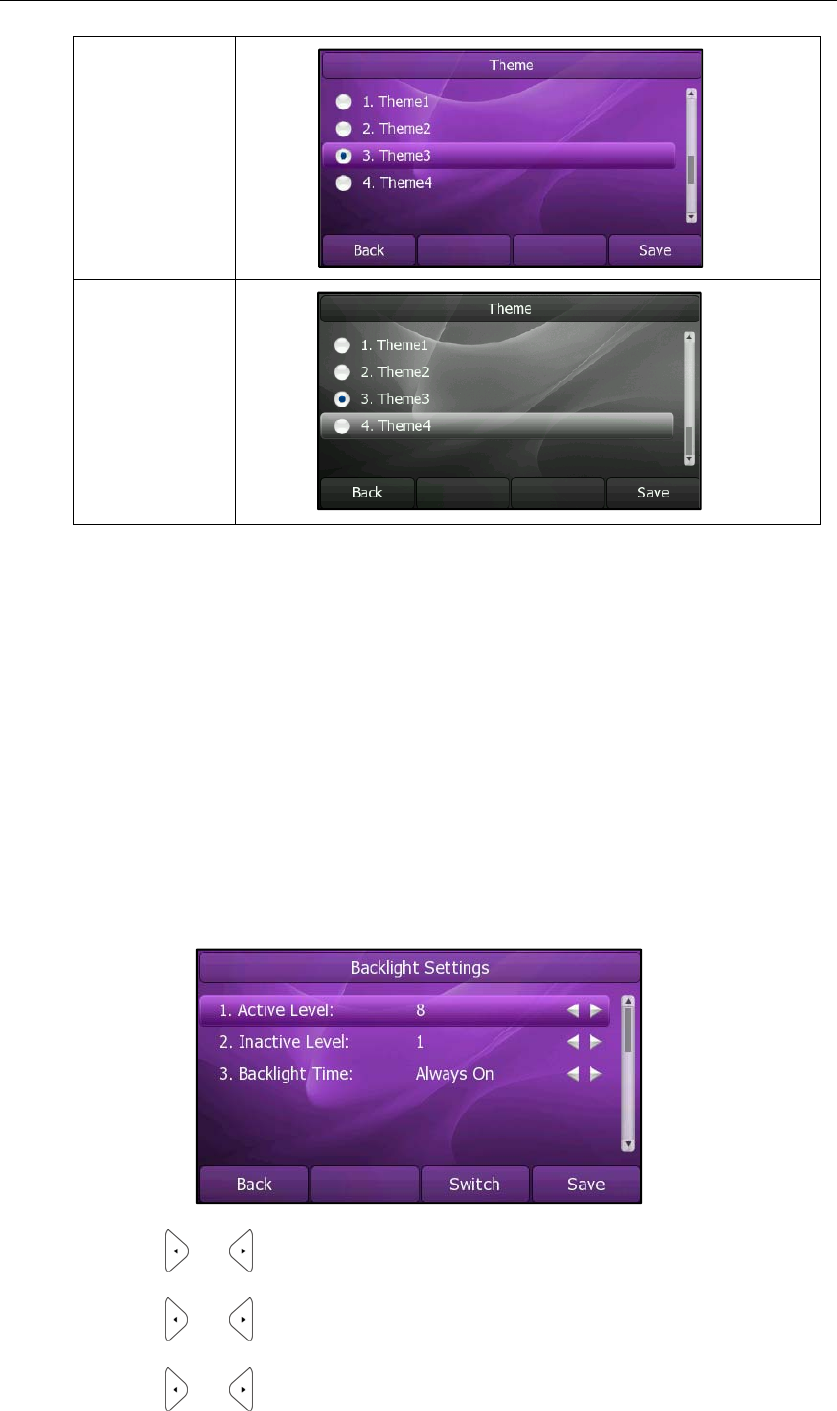
User Guide SIP-T46G IP Phone
24
Theme 3
Theme 4
You can also change the theme via web user interface at the path Phone->Preference.
Backlight
You can configure the backlight status on the LCD screen as the following types:
z Always on: Backlight is on permanently.
z 1min, 2min, 5min, 10min, 30min: Backlight is turned off when the phone is inactive
for approximately 1min, 2min, 5min, 10min or 30min.
To configure the backlight via phone user interface:
1. Press Menu->Display->Backlight.
2. Press or , or the Switch soft key to select the desired level from the Active
Level field.
3. Press or , or the Switch soft key to select the desired level from the Inactive
Level field.
4. Press or , or the Switch soft key to select the desired time from the
Backlight Time field.

Customizing Your Phone
25
5. Press the Save soft key to accept the change or the Back soft key to cancel.
You can also configure the backlight via web user interface at the path
Phone->Preference.
Note
Contrast
You can configure the contrast of the expansion model-CM69 to a comfortable level.
Premise is the expansion model has been connected to the phone.
Backlight Level means the backlight intensity.
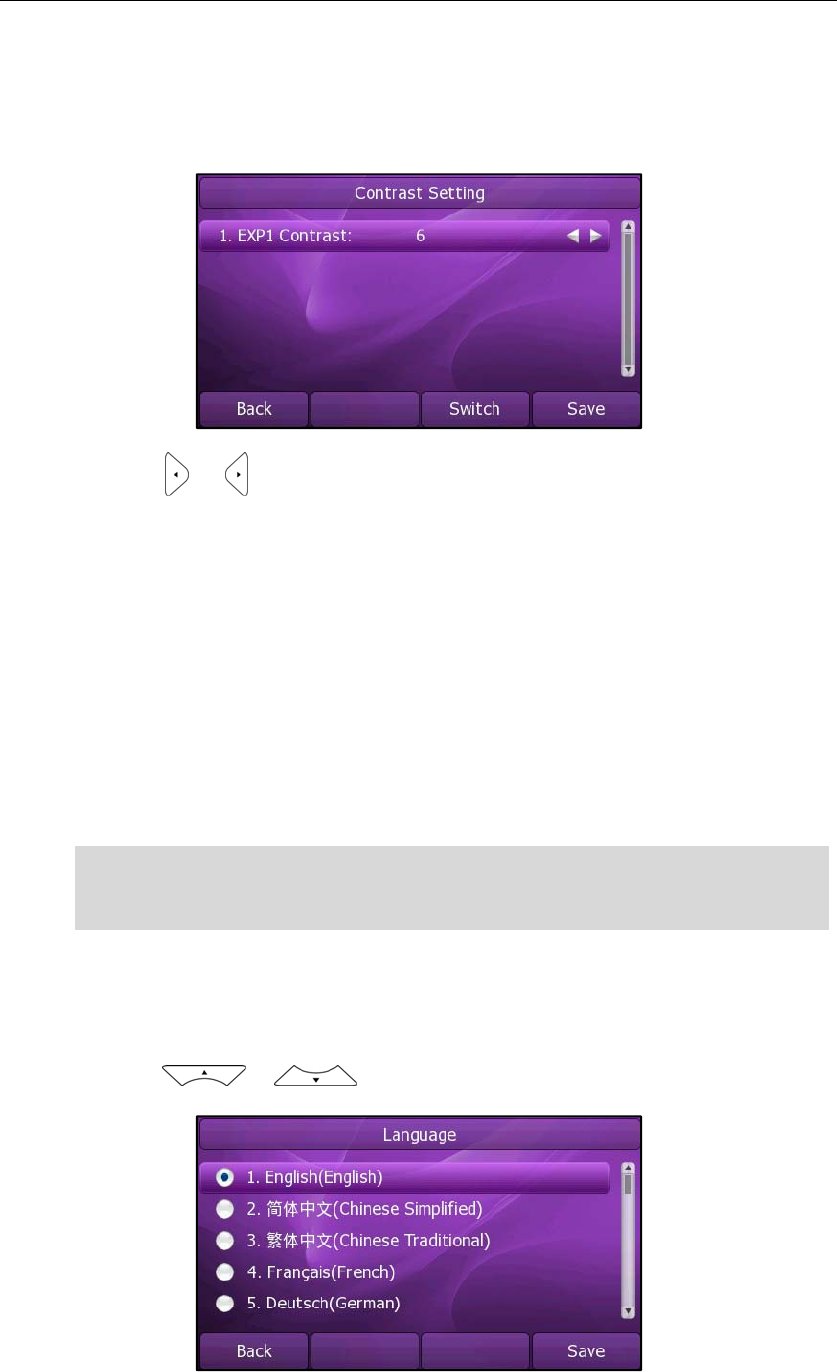
User Guide SIP-T46G IP Phone
26
To configure the contrast via phone user interface:
1. Press Menu->Setting->Advanced Settings (password: admin) ->Phone
Setting->Contrast.
2. Press or , or the Switch soft key to increase or decrease the intensity of
contrast. The default contrast level is 6.
3. Press the Save soft key to accept the change or the Back soft key to cancel.
Language
The default language of the phone user interface is English. The phone will detect and
use the same language as which of your internet browser for the web user interface, if
the language of your internet browser is not supported by the phone, the web user
interface will use English by default. You can change the language for the phone user
interface and the web user interface respectively from each other.
Note
To change the language for the phone user interface:
1. Press Menu->Setting->Basic Settings->Language.
2. Press or to select the desired language.
3. Press the Save soft key to accept the change.
Not all languages are available for selection. The available languages depend on the
language packs currently loaded to the IP phone. Please contact your system
administrator for more information about the available languages of your new phone.
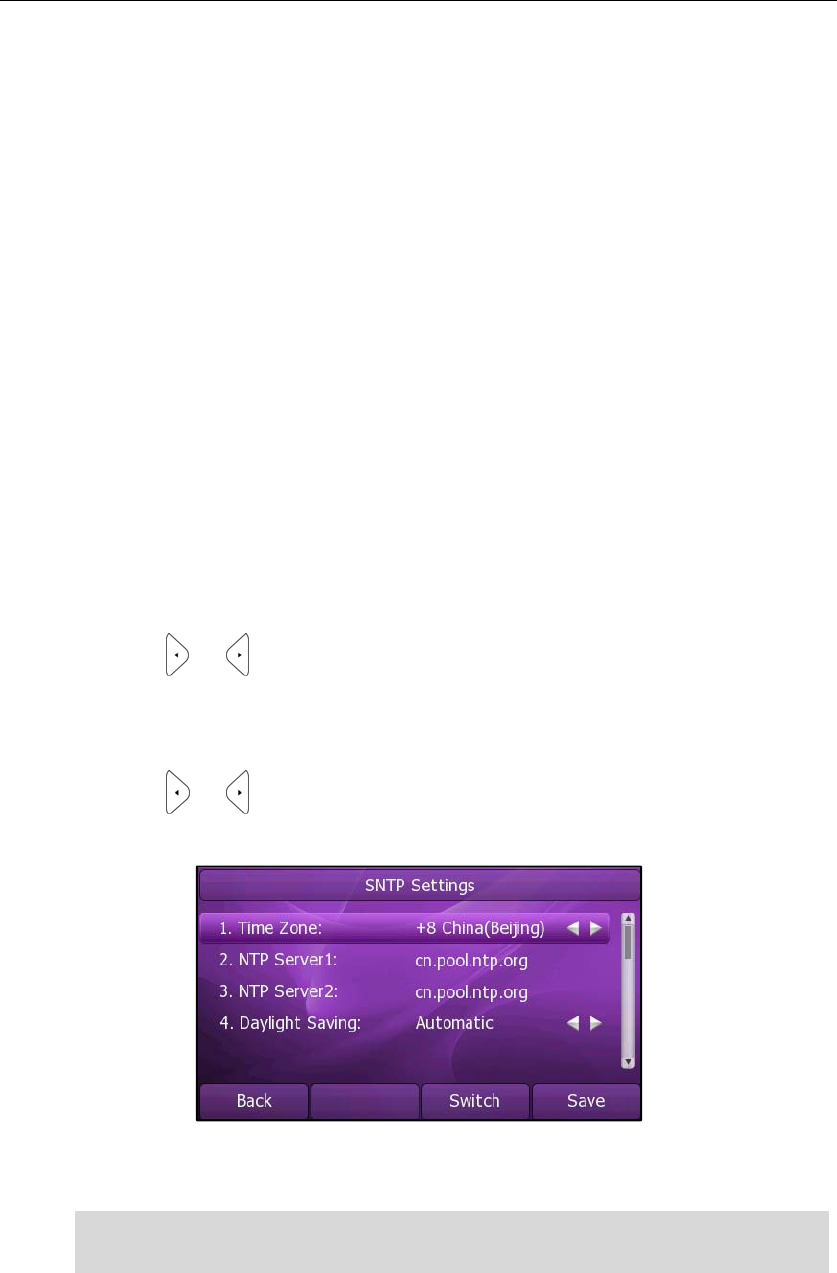
Customizing Your Phone
27
Text appears on the LCD screen will change to the selected language.
To change the language for the web user interface:
1. Click on Phone->Preference.
2. Select the desired language from the pull-down list of Web Language.
3. Click Confirm to accept the change.
Text displays on the web user interface will change to the selected language.
Time and Date
The time and date display on the LCD screen when the phone is idle. If the phone
cannot obtain the time and date from the Simple Network Time Protocol (SNTP) server,
contact your system administrator for more information. You can configure the phone
to obtain the time and date from the SNTP server automatically, or configure the time
and date manually.
To configure the SNTP settings via phone user interface:
1. Press Menu->Setting->Basic Settings->Time & Date->SNTP Settings.
2. Press or , or the Switch soft key to select the time zone that applies to your
area from the Time Zone field. The default time zone is "+8 China(Beijing)".
3. Enter the domain names or IP addresses in the NTP Server1 and NTP Server2 fields,
respectively.
4. Press or , or the Switch soft key to select Automatic from the Daylight
Saving field.
5. Press the Save soft key to accept the change or the Back soft key to cancel.
Note
Please refer to Appendix A - Time Zones
for the list of available time zones on the IP
phone.
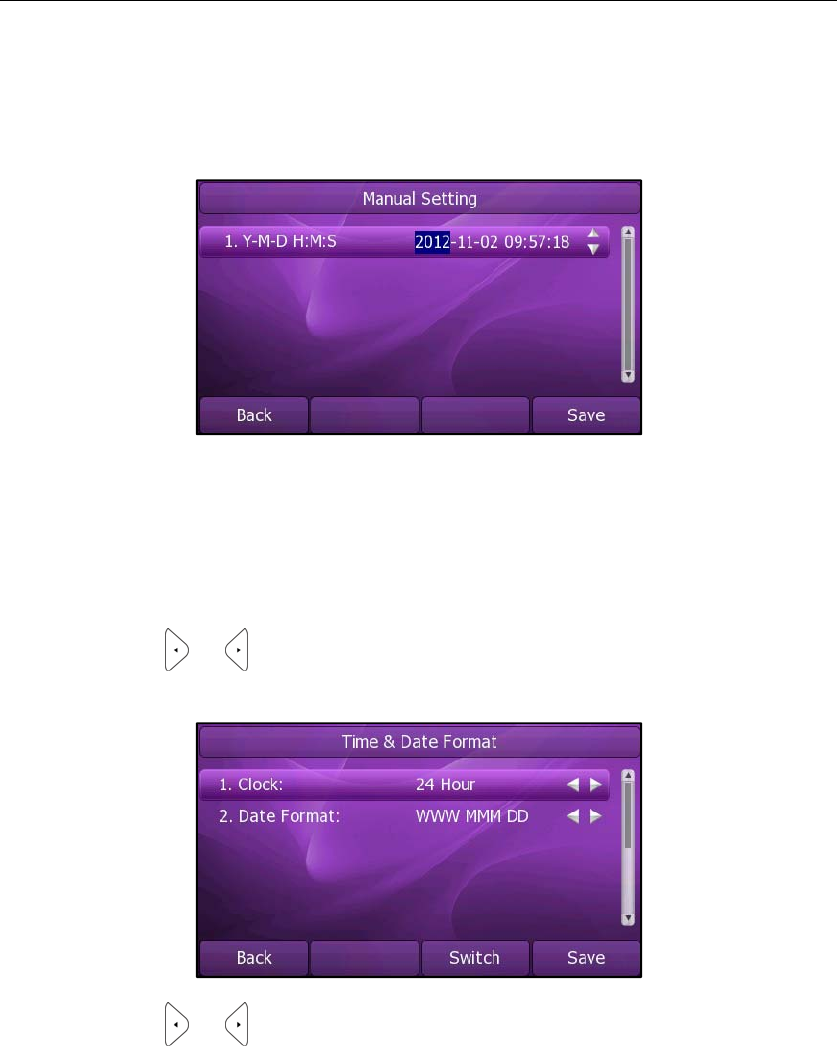
User Guide SIP-T46G IP Phone
28
To configure the time and date manually via phone user interface:
1. Press Menu->Setting->Basic Settings->Time & Date->Manual Setting.
2. Enter the specific date and time.
3. Press the Save soft key to accept the change.
The time that displays on the LCD screen will change accordingly.
To configure the time and date format via phone user interface:
1. Press Menu->Setting->Basic Settings->Time & Date Format.
2. Press or , or the Switch soft key to select the desired time format (12 Hour
or 24 Hour) from the Clock field.
3. Press or , or the Switch soft key to select the desired date format from the
Date Format field.
4. Press the Save soft key to accept the change or the Back soft key to cancel.
There are 7 available date formats, for example, the date format "WWW DD
MMM","WWW" represents the abbreviation of the week, "DD" represents two-digit of the
date, and "MMM" represents the first three letters of the month.
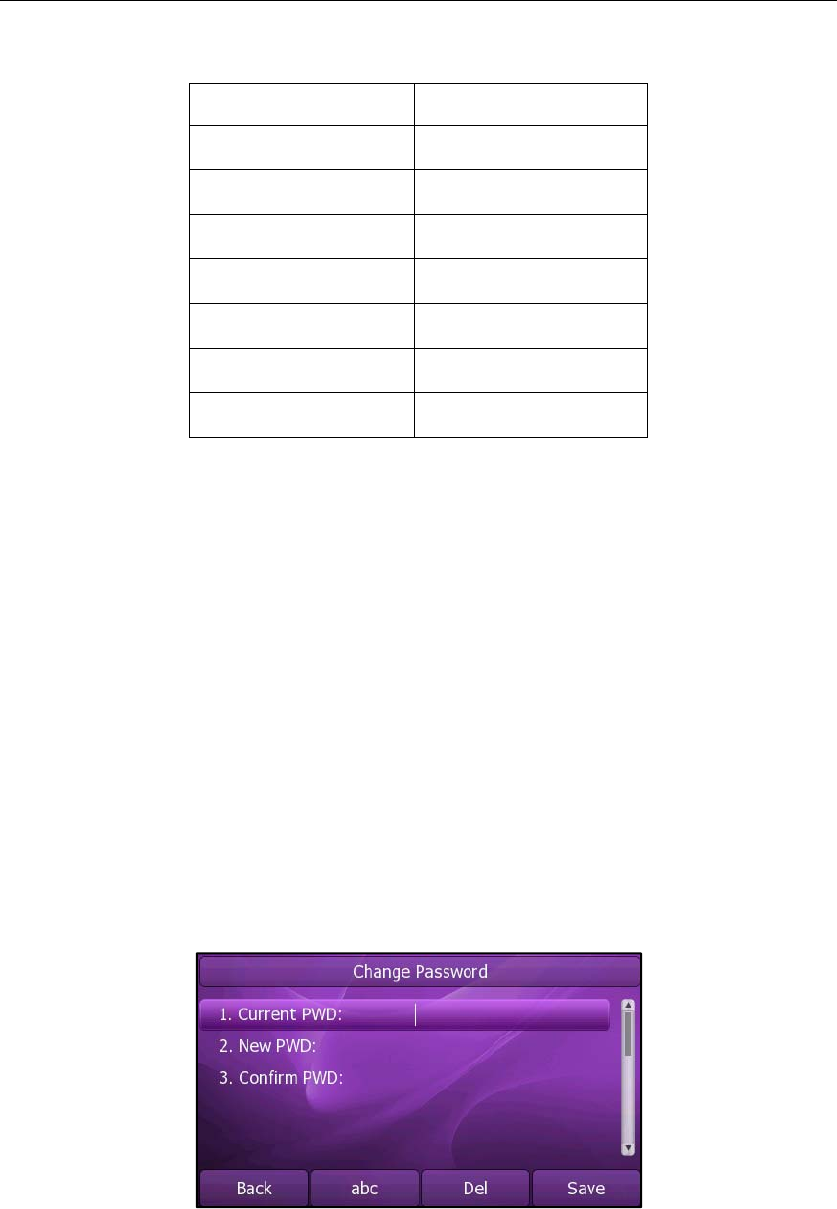
Customizing Your Phone
29
The date formats you need to know:
Date Format Example (2012-11-2)
WWW MMM DD Fri Nov 02
DD-MMM-YY 02-Nov-12
YYYY-MM-DD 2012-11-02
DD/MM/YYYY 02/11/2012
MM/DD/YY 11/02/12
DD MMM YYYY 02 Nov 2012
WWW DD MMM Fri 02 Nov
You can also configure the time and date settings via web user interface at the path
Phone->Preference.
Administrator Password
You can change the administrator password to protect your phone from unauthorized
use. Only the users owning the administrator password have the permission to change
the advanced settings.
To change the administrator password via phone user interface:
1. Press Menu->Setting->Advanced Settings (password: admin) ->Set Password.
2. Enter the old password in the Current PWD field.
3. Enter the new password in the New PWD field.
4. Enter the new password again in the Confirm PWD field.
5. Press the Save soft key to accept the change or the Back soft key to cancel.
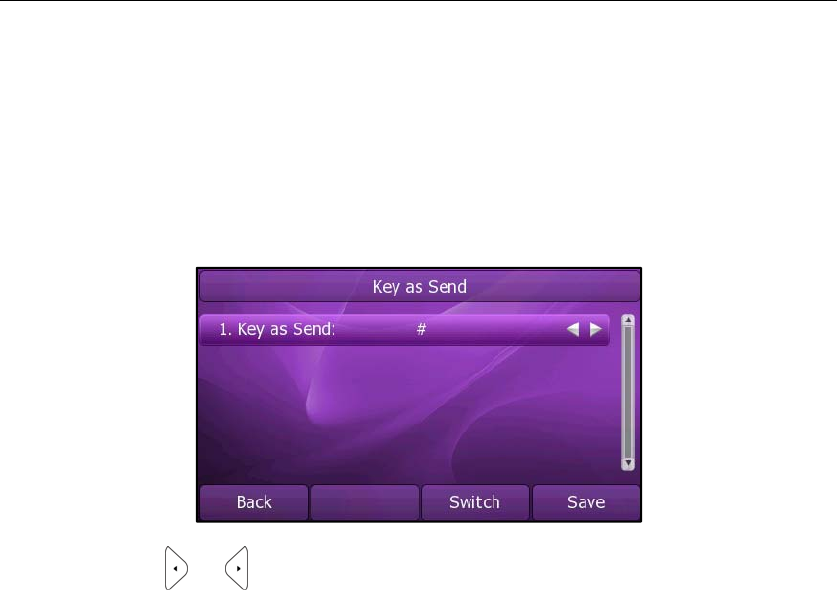
User Guide SIP-T46G IP Phone
30
Key as Send
You can set the "#" or "*" to perform as a send key while dialing a call.
To set the key as send via phone user interface:
1. Press Menu->Features->Key as Send.
2. Press or , or the Switch soft key to select "#" or "*" from the Key as Send field,
or select Disable to disable this feature.
3. Press the Save soft key to accept the change or the Back soft key to cancel.
You can also configure key as send via web user interface at the path
Phone->Features->General Information.
Keypad Lock
You can lock the keypad of your phone when you are temporarily not using it. This
feature helps you to protect your phone from unauthorized use.
This feature allows you to perform the following:
Menu Key: The Menu soft key and Menu key are locked. You cannot access
the menu of the phone until unlocked. A new voice mail can be
accessed by pressing the Connect soft key or the MESSAGE key,
but the voice mail code cannot be configured.
Function Keys: The function keys are locked. You cannot use the MESSAGE,
REDIAL, HOLD, MUTE, TRANSFER, OK, X, navigation keys, soft keys,
and line keys until unlocked.
All Keys: All keys are locked. You are only allowed to dial emergency
numbers, answer incoming calls by lifting the handset, pressing
the Speakerphone key or pressing the HEADSET key and place
an active call on hold by pressing the Hold soft key.
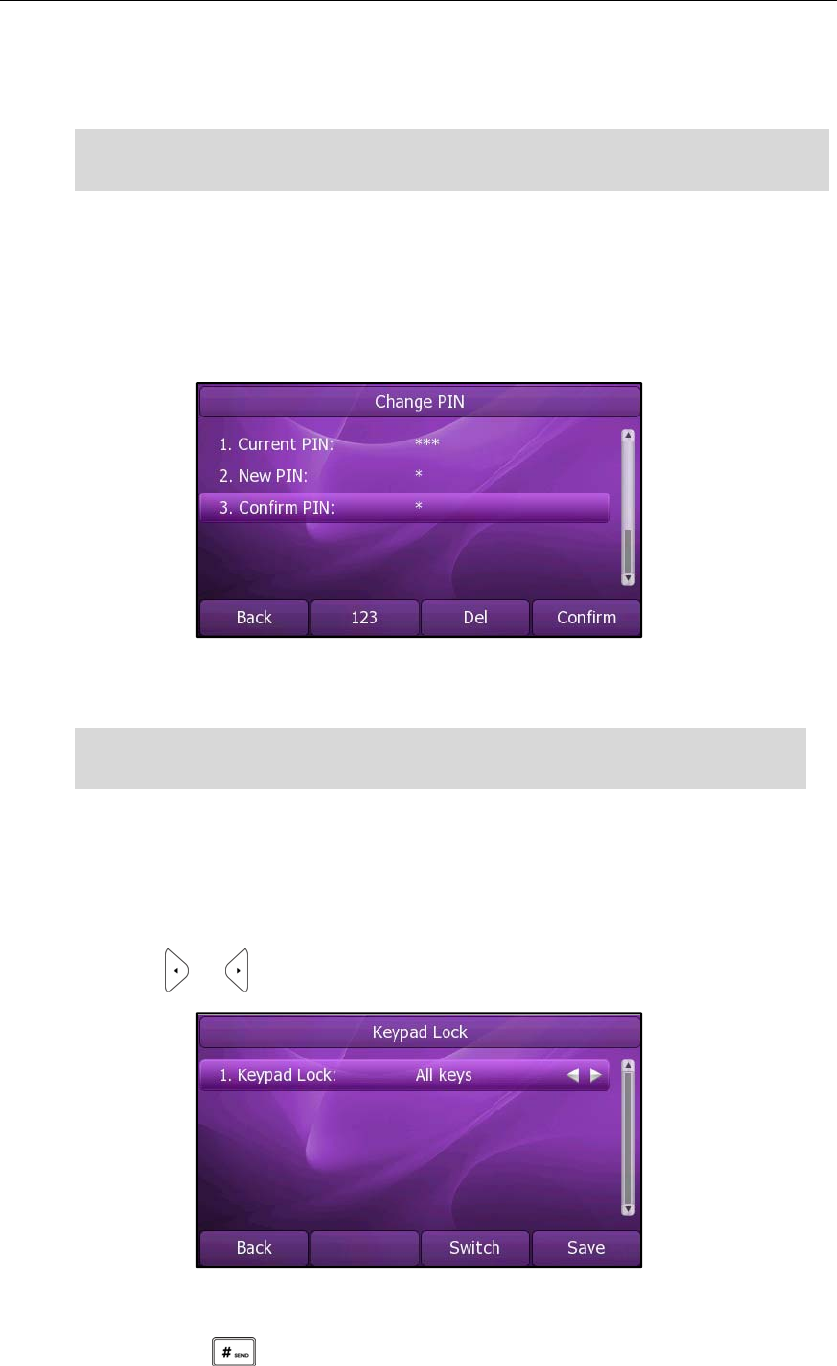
Customizing Your Phone
31
Answer call only: All keys are locked. Incoming calls will be answered
automatically, but cannot be ended by your party.
Note
To set the keypad lock PIN via phone user interface:
1. Press Menu->Setting->Basic Settings->Phone Unlock PIN.
2. Enter the Current PIN, New PIN and Confirm PIN in the corresponding fields.
3. Press the Confirm soft key to accept the setting or the Back soft key to cancel.
Note
To activate the keypad lock via phone user interface:
1. Press Menu->Setting->Advanced Settings (password: admin) ->Phone Setting->Lock.
2. Press or , or the Switch soft key to select the desired type from the Keypad
Lock field.
3. Press the Save soft key to accept the change.
4. Long press to lock the keypad immediately when the phone is idle.
The emergency number setting, if desired, must be made before lock activation. For
more information, refer to Emergency Number on page 65.
The PIN code can only be 0~9, and not more than 15 characters.
The current PIN is 123.
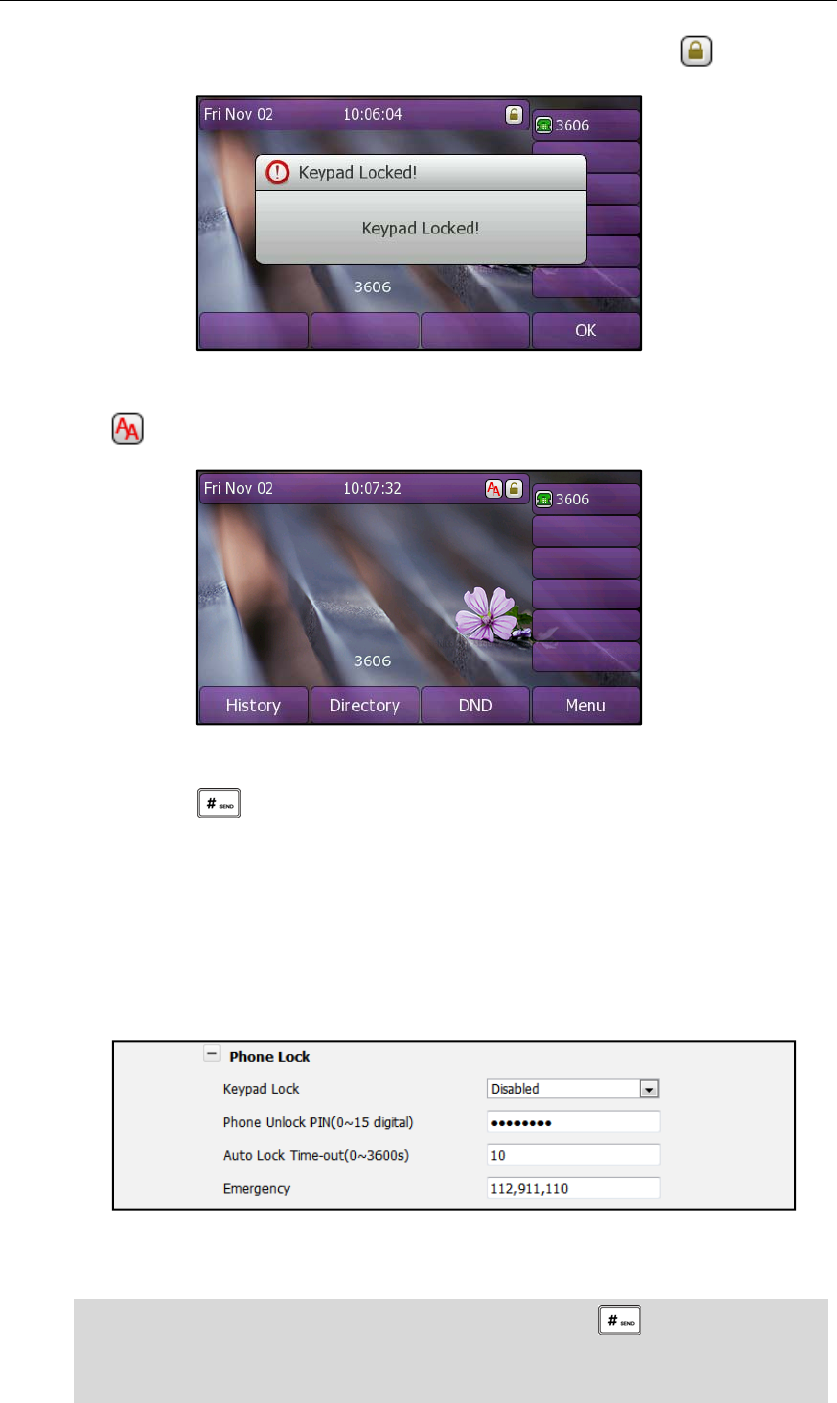
User Guide SIP-T46G IP Phone
32
The LCD screen prompts “Keypad Locked!” and displays the icon .
If the keypad lock feature is activated to be Answer call only, an additional icon
will appear on the LCD screen.
You can configure the interval (in seconds) to automatically lock the keypad instead of
long pressing .
To configure the timeout for auto lock via web user interface:
1. Click on Phone->Features.
2. Click the “+”sign on the left of the Phone Lock to expand the feature list.
3. Enter the desired time in the Auto Lock Time-out (0~3600s) filed. The default value is
10 seconds.
4. Click Confirm to accept the change.
Note When the time out is 0 seconds, that is, you can lon
g
press to lock the keypad
only.
You can configure the time out for automatic keypad lock via web user interface
l
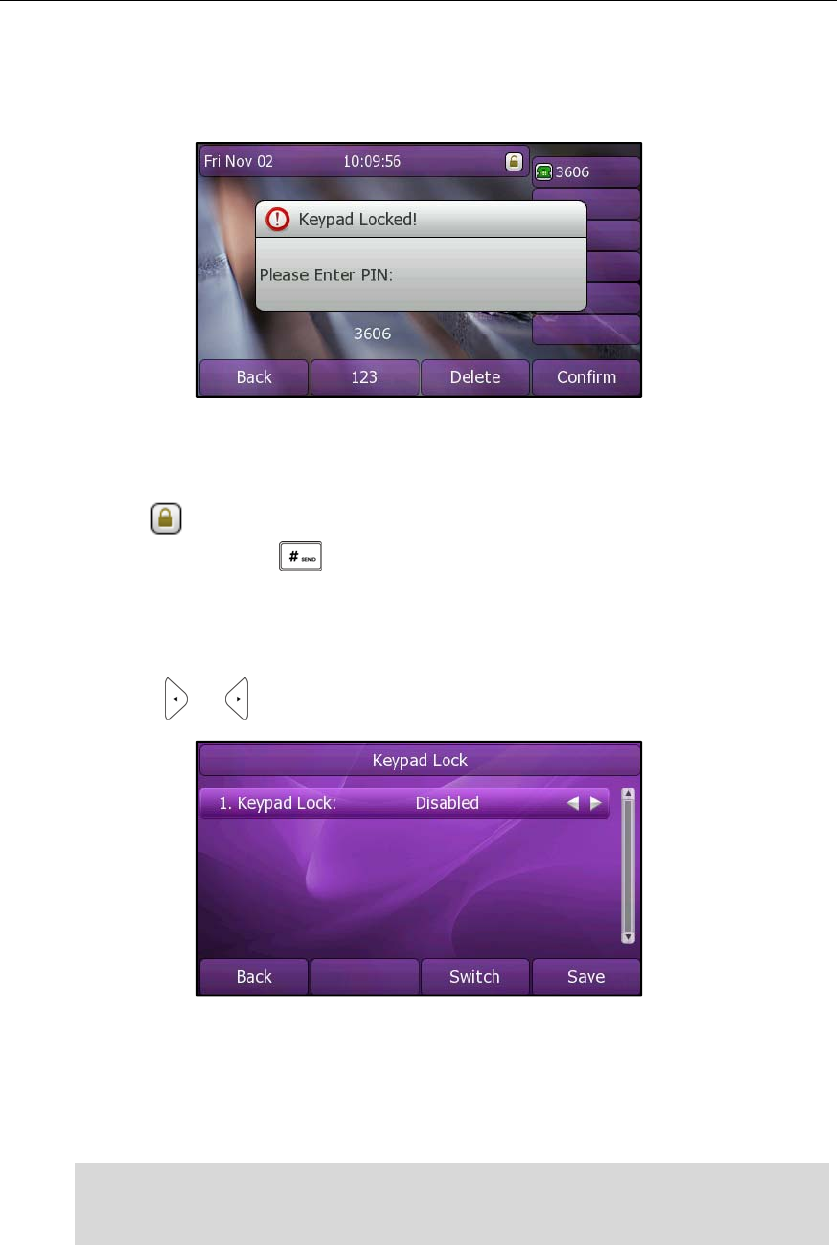
Customizing Your Phone
33
To unlock the keypad lock via phone user interface:
1. Press any locked key, the LCD screen prompts “Please Enter PIN:”.
2. Enter the PIN (default PIN: 123).
3. Press the Confirm soft key to unlock the keypad.
The icon disappears from the LCD screen.
You can long press to lock the keypad again.
To deactivate the keypad lock via phone user interface:
1. Press Menu->Setting->Advanced Settings (password: admin) ->Phone Setting->Lock.
2. Press or , or the Switch soft key to select Disabled from the Keypad Lock
field.
3. Press the Save soft key to accept the change.
You can also activate or deactivate the keypad lock via web user interface at the
path Phone->Features->Phone Lock.
Note The default PIN for unlock is 123, you can also unlock the keypad by administrator
password. When you enter the administrator password to unlock the keypad, the phone
will then turn to the Change PIN interface.
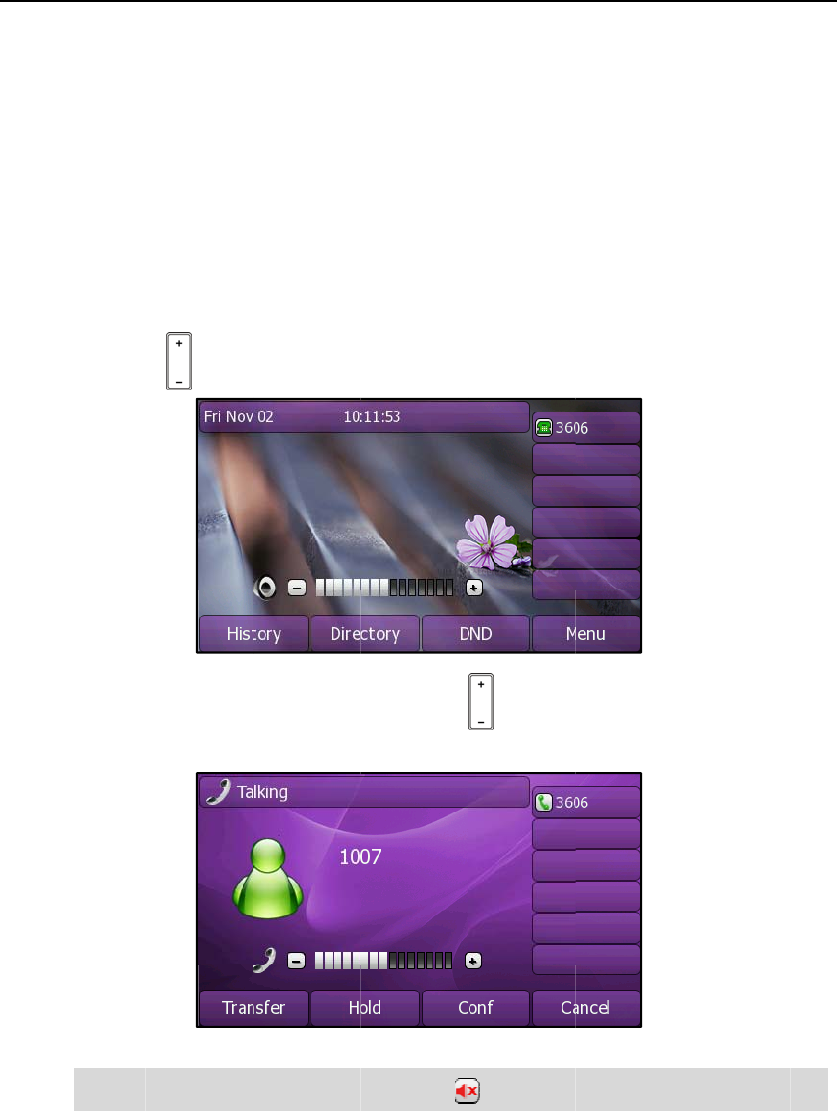
User
34
Au
Vo
Not
e
Ri
n
Guide SIP-T4
6
u
dio Set
t
lume
You ca
n
devices
interfac
e
when th
1. Pres
2. Wh
e
(
ha
n
e
n
g Tones
Rin
g
ton
distin
g
ui
To selec
1. Pres
If ringe
r
6
G IP Phone
t
ings
n
press the V
o
(
handset, s
p
e
or durin
g
a
e phone is i
d
s to ad
ju
e
n the phon
e
n
dset, speak
e
es are used
t
sh the acco
u
t a rin
g
tone
s Menu->Set
t
r
volume is a
d
o
lume key to
p
eake
r
phon
e
call. You ca
d
le.
u
st the rin
g
e
r
e
is durin
g
th
e
er
phone or
h
t
o indicate i
n
u
nts or to dis
t
for the phon
t
in
g
->Basic S
d
justed to mi
n
ad
j
ust the r
e
e
or headset
)
n also press t
r
volume wh
e
e
call, press
h
eadset
)
.
n
comin
g
cal
l
t
in
g
uish your
e via phone
ettin
g
s->Rin
g
n
imum, the
e
ceiver volu
m
, when the
p
he Volume
k
e
n the phon
e
to ad
j
us
t
s. You can s
e
phone from
user interfa
c
g
Tones.
icon will a
p
m
e of curren
t
p
hone is in th
e
k
ey to ad
j
ust
t
e
is in the idl
e
t
the volume
e
lect differe
n
your nei
g
hb
o
c
e:
p
pear on the
t
ly used aud
i
e
dialing
t
he rin
g
e
r
vo
e
screen.
of audio de
v
n
t rin
g
tones
t
o
r’s.
LCD screen.
i
o
lume
v
ice
t
o
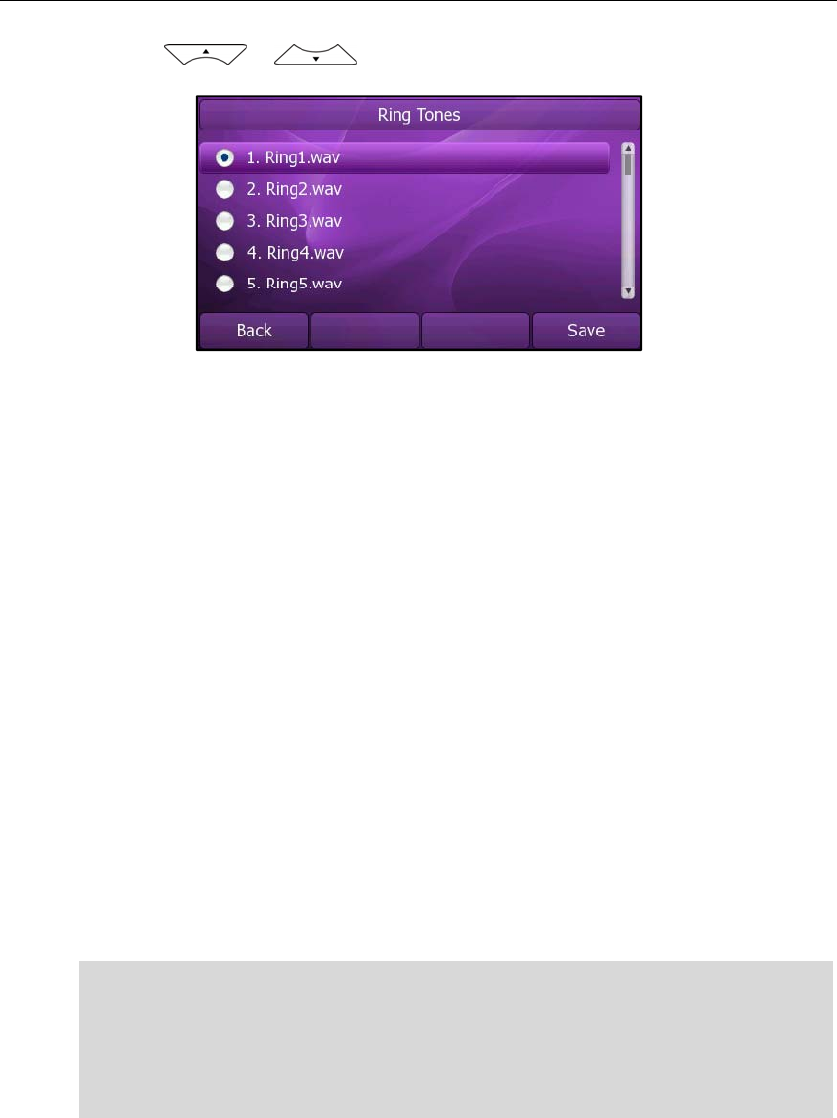
Customizing Your Phone
35
2. Press or to select the desired ring tone.
3. Press the Save soft key to accept the change or the Back soft key to cancel.
To select a ring tone for the phone via web user interface:
1. Click on Phone->Preference.
2. Select the desired ring tone from the pull-down list of Ring Tones.
3. Click Confirm to accept the change.
To select a ring tone for the account via web user interface:
1. Click on Account.
2. Select the desired account from the pull-down list of Account.
3. Select the desired ring tone from the pull-down list of Ring Tones.
If common is selected, this account will use the ring tone selected for the phone at
the path Phone->Preference. Refer to the above instruction.
4. Click Confirm to accept the change.
You can also upload custom ring tones for your phone, contact your system
administrator for more information.
Note
Contact Management
This section provides the operating instructions for managing contacts. The topics
include:
z Local Directory
z Blacklist
z Remote Phonebook
The ring tone for an incoming call on the phone may be different. For example, when
the phone receives an incoming call from a contact stored in the local directory, it will
play the ring tone assigned to the contact in the contact directory (refer to Adding
Contacts in the Contact Management section). Otherwise, the phone will play the ring
tone assigned to the account. If both the contact ring tone and the account ring tone
are not assigned, then the phone will play the ring tone assigned for the phone.
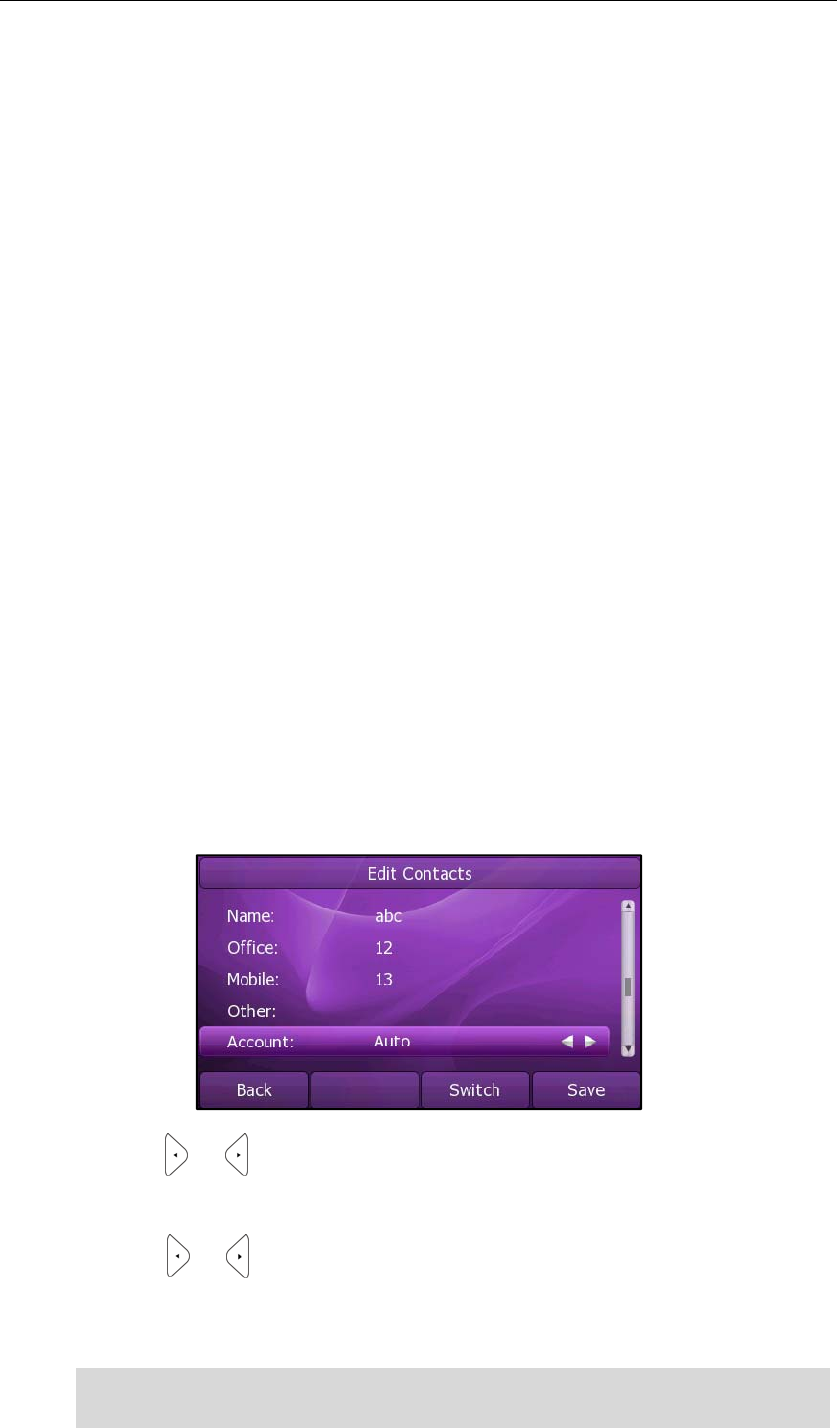
User Guide SIP-T46G IP Phone
36
z BroadSoft Phonebook
Local Directory
The built-in phone directory stores the names and phone numbers of your contacts. You
can store up to 300 contacts in your phone's local directory. You can add, edit, delete
or search for a contact in the local directory. You can also dial a contact from the local
directory.
Adding Contacts
You can add contacts to your local directory in the following ways:
z Manually
z From call history
z From remote phonebook
Adding Contacts Manually
To add a contact to the local directory manually:
1. Press Directory->Local Directory.
2. Select the desired contact group (For example, select Contacts).
3. Press the Add soft key.
4. Enter the Name and the Office, Mobile or Other numbers.
5. Press or , or the Switch soft key to select the desired account from the
Account field. If Auto is selected, the phone will use the first available account
when placing calls to the contact from the local directory.
6. Press or , or the Switch soft key to select the desired ring tone from the Ring
field.
7. Press the Save soft key to accept the change or the Back soft key to cancel.
Note If the contact has existed in the directory, the LCD screen will prompt “ContactName
exists in contactlist!”.
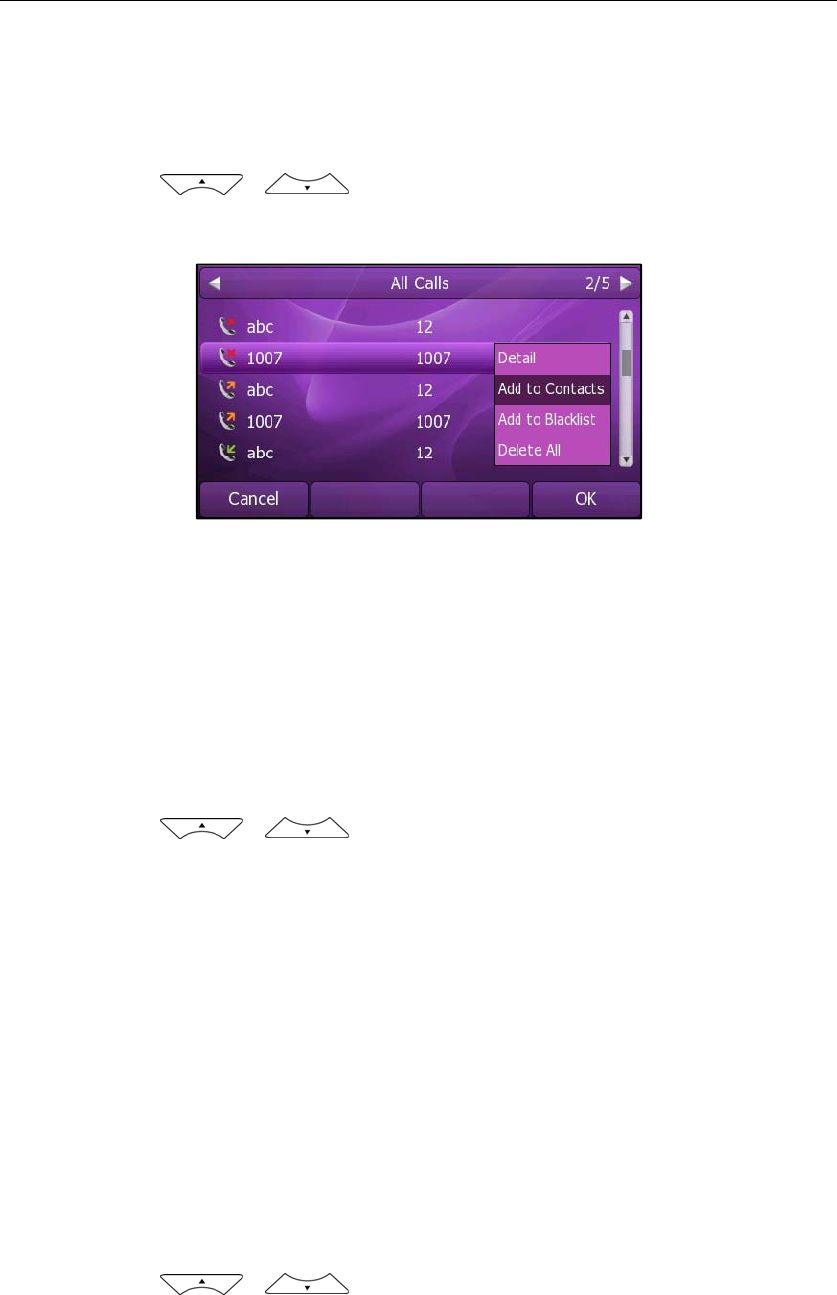
Customizing Your Phone
37
Adding Contacts from Call History
To add a contact to the local directory from the call history:
1. Press the History soft key.
2. Press or to highlight the desired entry.
3. Press the Option soft key, and then select Add to Contacts from the prompt list.
4. Enter the contact name.
5. Press the Save soft key to accept the change.
The entry is successfully saved in the local directory.
Adding Contacts from remote phonebook
To add a contact to the local directory from the remote phonebook:
1. Press Directory->Remote Phone Book.
2. Press or to highlight the desired entry.
3. Press the Option soft key, and then select Move to Contacts from the prompt list.
4. Press the Save soft key to save the contact in the local directory.
If the contact has already existed in the local directory, the LCD screen will prompt
"Overwrite the original contact?". Press the OK soft key to overwrite the original
contact in the local directory or the Cancel soft key to cancel.
For more information on remote phonebook operating, refer to Remote Phonebook on
page 42.
Editing Contacts
To edit a contact in the local directory:
1. Press Directory->Local Directory->Contacts.
2. Press or to highlight the desired contact.
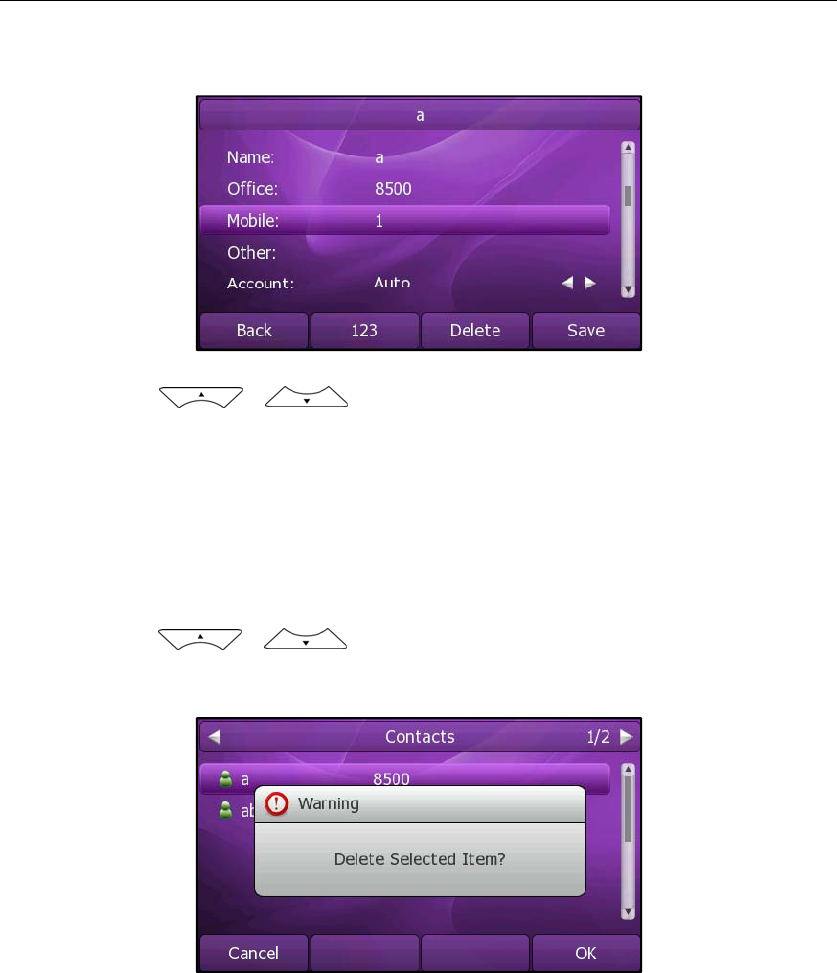
User Guide SIP-T46G IP Phone
38
3. Press the Option soft key, and then select Detail from the prompt list.
4. Press or to highlight the contact information and then edit.
5. Press the Save soft key to accept change or the Back soft key to cancel.
Deleting Contacts
To delete a contact from the local directory:
1. Press Directory->Local Directory->Contacts.
2. Press or to highlight the desired contact.
3. Press the Option soft key, and then select Delete from the prompt list.
4. Press the OK soft key to confirm the deleting or the Cancel soft key to cancel.
You can also manage the contacts via web user interface at the path
Contacts->Contacts->Contacts. Please refer to the instruction above for the parameters’
detail.
Uploading Contact Photos
To upload a new custom photo for the contact via web interface:
1. Click on Contacts->Contacts->Contacts.
2. Click the record which you want to edit, then the record will turn orange.
3. Click Browse, and then select a photo from your local computer.
4. Click Upload Photo to upload the photo.
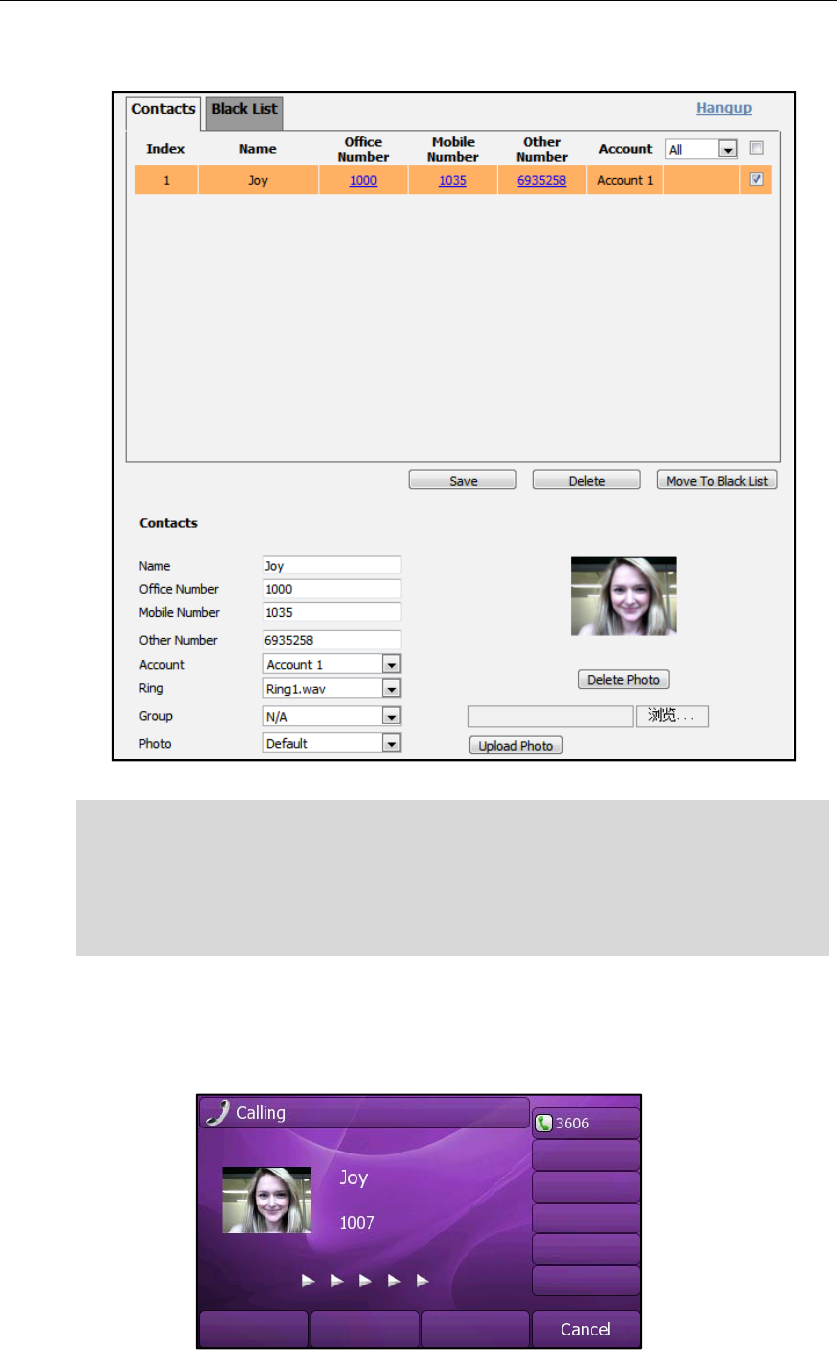
Customizing Your Phone
39
You can also click Delete Photo to delete the photo.
Note
When you place a call from the contact, the phone idle screen will show the contact
photo.
The phone only supports uploading the png, jpg or bmp format files. The maximum
resolution of the upload picture is 96*96 pixels.
You can only delete the custom photos.
If multiple contacts want to use the same custom photo, you need to upload the
contact photo again.

User Guide SIP-T46G IP Phone
40
Placing Calls to Contacts
To place a call to a contact from the local directory:
1. Press Directory->Local Directory.
2. Select the desired contact group.
3. Press or to highlight the desired contact.
4. Press the Dial soft key.
- If only one number of the contact is stored in the local directory, press the Dial soft
key to dial out the number.
- If multiple numbers of the contact are stored in the local directory, press the Dial
soft key to display a list of numbers.
Press or to highlight the desired number.
Press the Dial soft key to dial out the number.
Searching for Contacts
To search for a contact in the local directory:
1. Press Directory->Local Directory.
2. Press the Search soft key.
3. Enter a few continuous characters of the contact name or continuous numbers of
the contact phone number using the keypad.
4. Press the OK soft key.
The contacts whose name or phone number matches the characters entered will
appear on the LCD screen. You can dial from the result list.
Importing/Exporting Contact lists
You can manage your phone’s local directory via phone or web user interface. But you
can only import or export the contact list via web user interface.
To import an XML file of contact list via web user interface:
1. Click on Contacts->Contacts.

Customizing Your Phone
41
2. Click Browse to select a contact list file (file format must be .xml) from your local
system.
3. Click Import XML to import the contact list.
The web user interface prompts "This operation will delete all records which already
exist! Continue?".
4. Click OK to complete importing the contact list.
To import a CSV file of contact list via web user interface:
1. Click on Contacts->Contacts.
2. Click Browse to select a contact list file (file format must be.csv) from your local
system.
3. Click Import CSV to import the contact list.
Then the phone turns to the preview page, you can then select whether to delete
all old contacts while importing the contact list, and select the contact information
you want to import into the local directory. Such as contact name, office number
or mobile number.
4. Click Import to complete importing the contact list.
To export a contact list via web user interface:
1. Click on Contacts->Contacts.
2. Click Export XML (or Export CSV).
3. Click Save to save the contact list to your local system.
Blacklist
The built-in phone directory stores the names and phone numbers of the blacklist. You
can store up to 30 contacts in your phone’s blacklist directory. You can add, edit,
delete or search for a contact in the blacklist directory. You can also dial a contact in
the blacklist directory, but an incoming call from the blacklist directory will be rejected
automatically.
Operating instructions of adding blacklists, editing blacklists, deleting blacklists, placing
call to blacklists and searching for contact in the blacklist, refer to the operating
instructions of Local Directory on page 36.
To remove a contact to the Blacklist:
1. Press Directory->Local Directory.
2. Select the desired contact group (For example, select Contacts).
3. Press the Option soft key and then select Move to Blacklist from the prompt list.
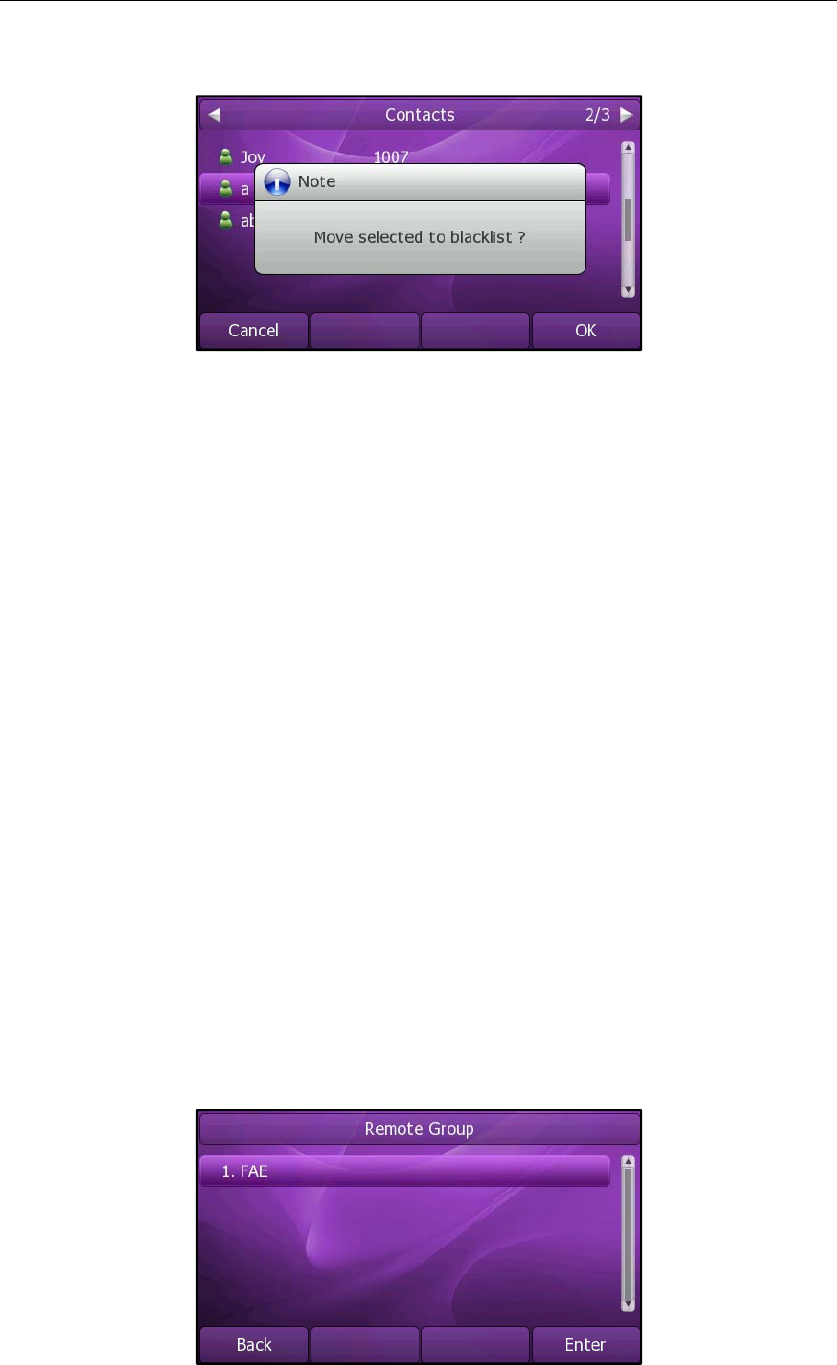
User Guide SIP-T46G IP Phone
42
The phone user interface prompts "Move selected to blacklist?".
4. Press the OK soft key to confirm the setting.
Remote Phonebook
You can access your corporate directory through your phone. You can add local
contacts from the corporate directory. You can also dial a contact from the corporate
directory.
You can configure your new phone to access up to 5 corporate directories. Contact
your system administrator for the access URL of the corporate directory.
To configure an access URL for remote phonebook via web user interface:
1. Click on Contacts->Remote Phone Book.
2. Enter the access URL in the Phone Book URL field.
3. Enter the name in the Name field.
4. Click Confirm to accept the change.
To access your corporate directory via phone user interface:
1. Press Directory->Remote Phone Book.
2. Select the desired remote group, and then press the Enter soft key.
The phone connects to load the corporate directory, and then displays the
corporate contact list on the LCD screen.
3. Press the Back soft key to back to the previous interface.

Customizing Your Phone
43
To place a call from the corporate directory:
1. Press Directory->Remote Phone Book.
2. Select the desired remote group, and then press the Enter soft key to load the
corporate directory.
3. Select the desired contact in the corporate directory.
4. Press the Dial soft key.
In addition, you can enable the phone to present the caller identity stored in the
corporate directory when receiving a call.
To enable the presentation of caller identity stored in the remote phonebook:
1. Click on Phone->Features.
2. Click the “+” sign on the left of the General Information to expand the feature list.
3. Select Enabled from the pull-down list of Match Remote Phone Book.
4. Enter the refresh period of corporate directory in the Load Remote Phone Book
Interval (120~2592000s) field. The default value is 3600 seconds.
5. Click Confirm to accept the change.
BroadSoft Phonebook
You can access the BroadSoft directory through your phone. You can add local
contacts from the BroadSoft directory. You can also dial a contact from the BroadSoft
directory.
You can configure your new phone to access up to 6 BroadSoft directories. Contact
your system administrator for the access URL of the BroadSoft directory.
To configure the BroadSoft phonebook via phone user interface:
1. Press Menu->Features->BroadSoft Settings Menu->BroadSoft Dir Settings.
2. Press or , or the Switch soft key to select the desired BroadSoft item from
the BroadSoft Item field.
3. Enter the parameters: display name, server address, port, username and password
in the corresponding fields.
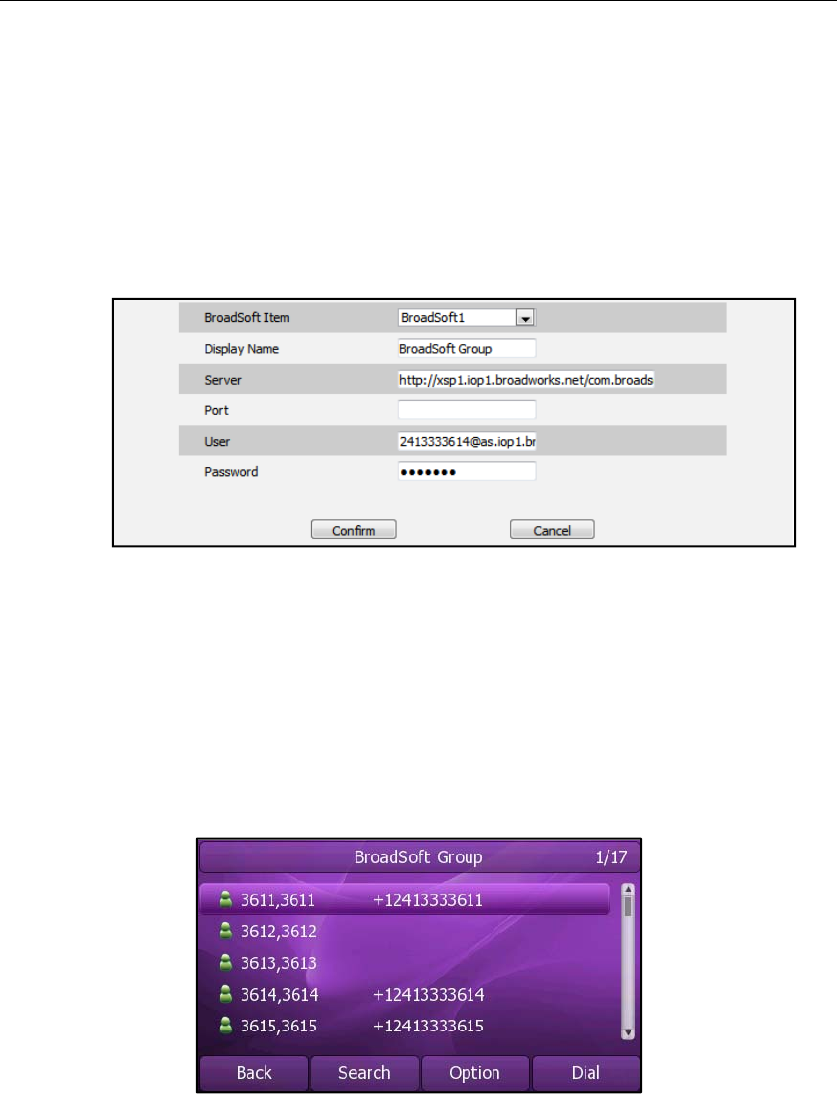
User Guide SIP-T46G IP Phone
44
4. Press the Save soft key to accept the change or the Back soft key to cancel.
To configure the BroadSoft phonebook via web user interface:
1. Click on Contacts->BroadSoft.
2. Select the desired BroadSoft item from the pull-down list of BroadSoft Item.
3. Enter the parameters: display name, server address, port, username and password
in the corresponding fields.
4. Click Confirm to accept the change.
To access the Broadsoft directory via phone user interface:
1. Press Directory->BroadSoft.
2. Select the desired directory item, and then press the Enter soft key.
The phone connects to load the BroadSoft directory, and then displays the desired
BroadSoft contact list on the LCD screen.
3. Press the Back soft key to back to the previous interface.
To place a call from the Broadsoft directory:
1. Press Directory->BroadSoft.
2. Select the desired directory item, and then press the Enter soft key to load the
BroadSoft directory.
3. Select the desired contact in the BroadSoft directory.
4. Press the Dial soft key.
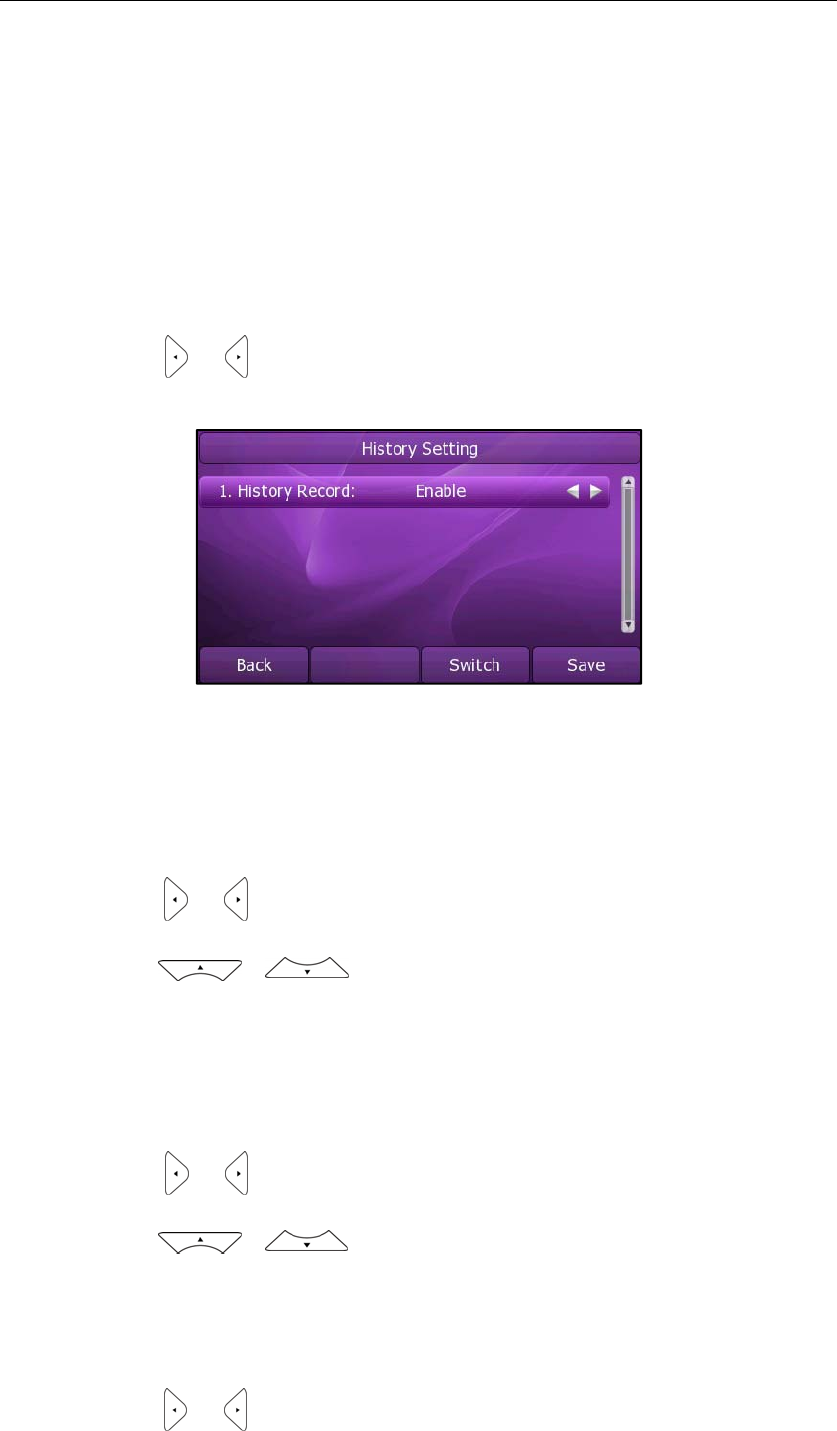
Customizing Your Phone
45
Call History Management
The SIP-T46G IP phone maintains call history lists of Dialed Calls, Received Calls, Missed
Calls and Forwarded Calls. The call history list supports up to100 entries in all. You can
check the call history, dial a call, add a contact or delete an entry from the call history
list. You should enable the history record feature in advance.
To enable the history record feature via phone user interface:
1. Press Menu->Features->History Setting.
2. Press or , or the Switch soft key to select Enable from the History Record
field.
3. Press the Save soft key to accept the change or the Back soft key to cancel.
To check the call history:
1. Press the History soft key.
The LCD screen displays All Calls list.
2. Press or to switch between All Calls, Dialed Calls, Received Calls, Missed
Calls and Forwarded Calls.
3. Press or to select the desired entry.
4. Press the Option soft key, and then select Detail from the prompt list.
The detailed information of the entry appears on the LCD screen.
To dial a call from the call history list:
1. Press the History soft key.
2. Press or to switch between All Calls, Dialed Calls, Received Calls, Missed
Calls and Forwarded Calls.
3. Press or to select the desired entry.
4. Press the Send soft key.
To add a contact from the call history list:
1. Press the History soft key.
2. Press or to switch between All Calls, Dialed Calls, Received Calls, Missed

User Guide SIP-T46G IP Phone
46
Calls and Forwarded Calls.
3. Press or to select the desired entry.
4. Press the Option soft key, and then select Add to Contacts (or Add to Blacklist) from
the prompt list.
For more information, refer to Contact Management on page 35.
To delete an entry from the call history list:
1. Press the History soft key.
2. Press or to switch between All Calls, Dialed Calls, Received Calls, Missed
Calls and Forwarded Calls.
3. Press or to select the desired entry.
4. Press the Delete soft key.
To delete all entries from the call history list:
1. Press the History soft key.
2. Press or to switch between All Calls, Dialed Calls, Received Calls, Missed
Calls and Forwarded Calls.
3. Press the Option soft key, and then select Delete All from the prompt list.
4. Press the OK soft key.
The LCD screen prompts "Are you sure to delete all records".
5. Press the OK soft key to confirm the deleting or the Cancel soft key to cancel.
BroadSoft Call Log
You can access the call log of the BroadSoft user through the IP phone. The call log
contains call information such as remote party identification, time and date. You can
check the call log and dial a call from the call log list. The BroadSoft call log allows users
to view and dial the stored numbers in the following lists: missed, received, and placed.
You can configure the IP phone to access up to 3 call log items. Contact your system
administrator for the access URL of the BroadSoft call log.
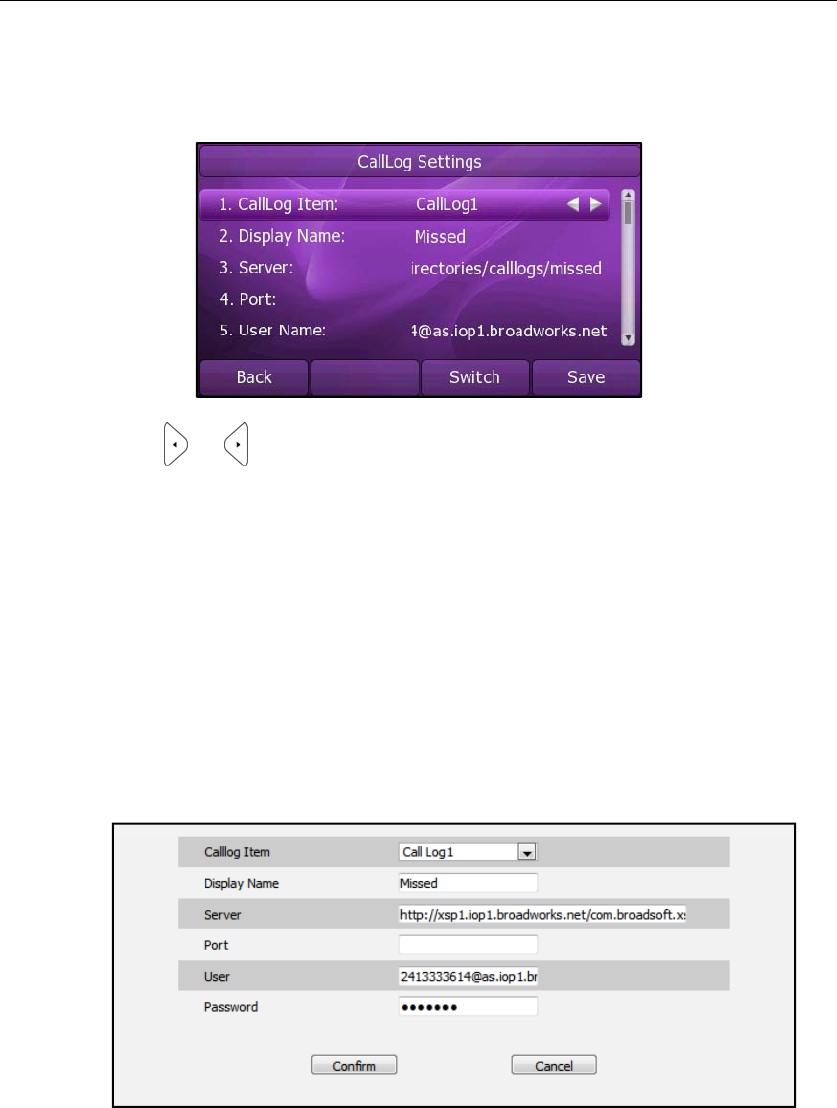
Customizing Your Phone
47
To configure the BroadSoft call log via phone user interface:
1. Press Menu->Features->BroadSoft Settings Menu->CallLog Settings.
2. Press or , or the Switch soft key to select the desired call log item from the
CallLog Item field.
3. Enter the parameters: display name, server address, port, username and password
in the corresponding fields.
4. Press the Save soft key to accept the change or the Back soft key to cancel.
To configure the BroadSoft call log via web user interface:
1. Click on Contacts->Call Log.
2. Select the desired call log item from the pull-down list of Calllog Item.
3. Enter the parameters: display name, server address, port, username and password
in the corresponding fields.
4. Click Confirm to accept the change.
To access the BroadSoft call log via phone user interface:
1. Press Menu->History->Network Call Log.
2. Select the desired call log menu, and then press the Enter soft key.
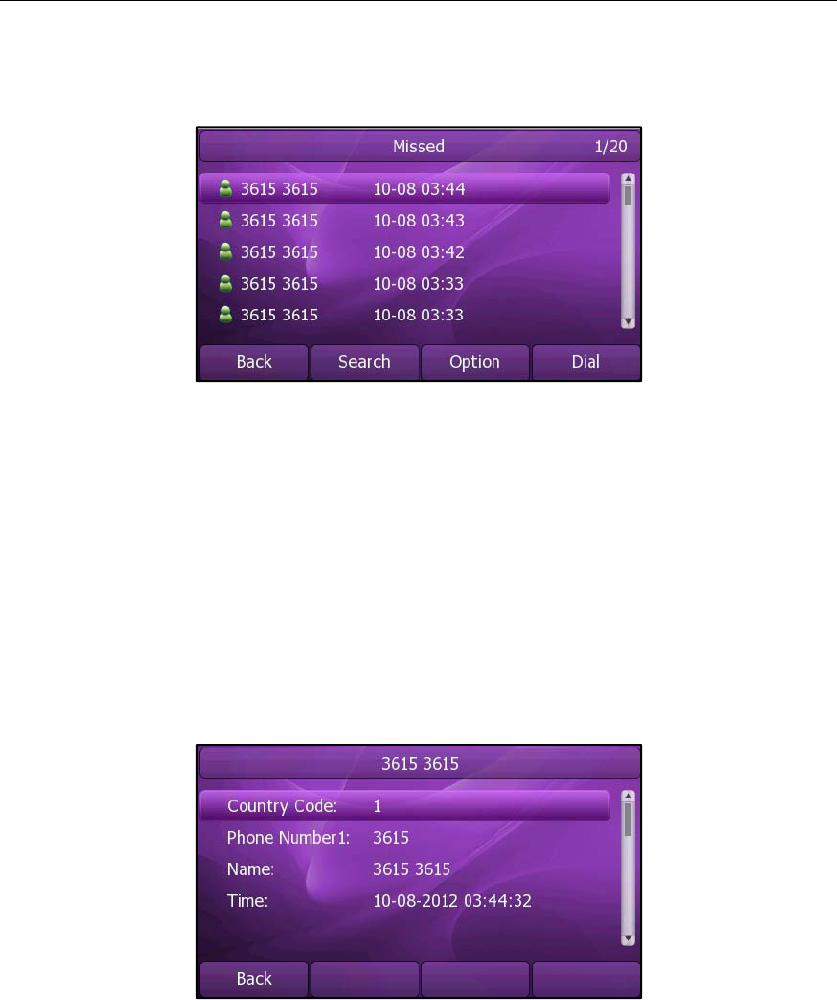
User Guide SIP-T46G IP Phone
48
The phone connects to load the BroadSoft call log, and then displays the desired
call log list on the LCD screen.
3. Press the Back soft key to back to the previous interface.
To check the BroadSoft call log:
1. Press Menu->History->Network Call Log.
2. Select the desired call log menu, and then press the Enter soft key to load the
BroadSoft call log.
3. Select the desired contact in the BroadSoft call log list.
4. Press the Detail soft key.
The detailed information of the entry appears on the LCD screen.
To dial a call from the BroadSoft call log list:
1. Press Menu->History->Network Call Log.
2. Select the desired call log menu, and then press the Enter soft key to load the
BroadSoft call log.
3. Select the desired contact in the BroadSoft call log list.
4. Press the Dial soft key.

Customizing Your Phone
49
System Customizations
Headset Use
Physically connect your headset, refer to Phone Installation on page 13 and
activate/deactivate it for use.
To activate the headset mode:
1. Press on the phone.
The HEADSET key LED illuminates solid green when the headset mode is activated.
Press the line key or the Answer soft key to answer a call, the call will connect to
your headset automatically.
To deactivate the headset mode:
1. Press again on the phone.
The HEADSET key LED turns off when the headset mode is deactivated.
DSS Keys
There are two types of DSS keys: Line Keys and Programmable Keys. The details will be
introduced as following. The SIP-T46G IP phone supports 15 line keys.
Line Keys
You can assign predefined functionalities to the line keys. You can also define a label
for the line key feature which will appear on the LCD screen. Line keys allow you to use
quick access features such as call return and voice mail. The line keys LED will indicate
the monitoring status when the keys are assigned specific features, such as BLF and
Shared Line. The default key type of line key 1-6 is Line. The default key type of line key
7-15 is N/A, which indicates that this line key provides no functionality.
To configure the line key via phone user interface:
1. Press Menu->Features->DSS Keys.
2. Select the desired line key, and then press the Enter soft key.
3. Select the desired key type from Type field.
4. (Optional.) Select the desired key event type from the Key Type field.
5. (Optional.) Select the desired line from the Account ID field.
6. (Optional.) Enter the string that will appear on the LCD screen in the Label field.
7. (Optional.) Enter the corresponding value in the Value field.
8. (Optional.) Enter the corresponding value in the Extension field.
9. Press the Save soft key to accept the change or the Back soft key to cancel.
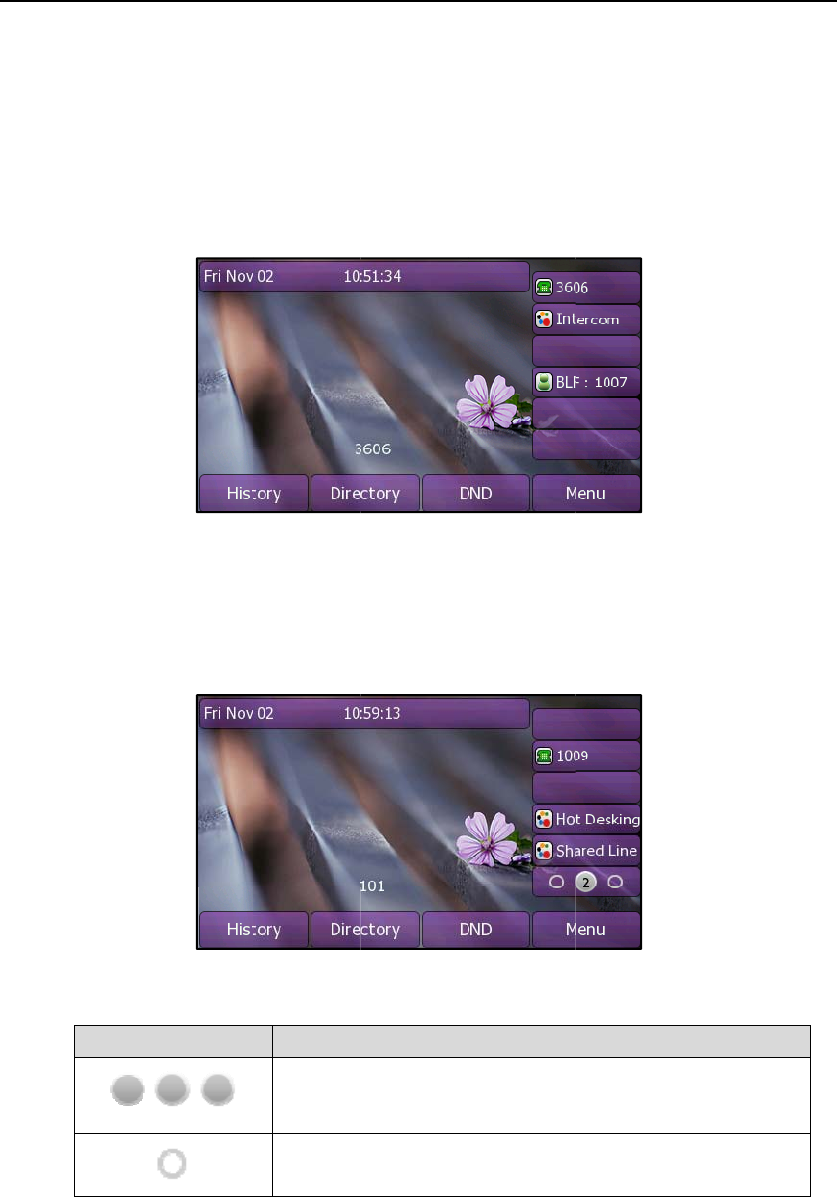
User
50
Guide SIP-T4
6
You ca
n
Key.
You ca
n
located
The pa
g
of the L
C
When y
o
key is di
s
line key
followin
g
The foll
o
You ca
n
disable
d
1
6
G IP Phone
n
also confi
gu
n
assi
g
n func
t
in line key 1
-
g
e can displ
a
C
D screen di
s
o
u assi
g
n fun
s
played on t
h
labels at mo
g
fi
g
ure sho
w
o
win
g
table li
s
Icons
n
confi
g
ure t
h
d
by default.
2
3
u
re the line k
e
t
ionalities to
-
6, the label
o
a
y 6 line key l
a
s
play:
ctionality to
h
e second o
r
st. The lowes
w
s an examp
l
s
ts the defa
u
The curr
e
The non-
c
h
e pa
g
e ico
n
e
y via web
u
15 line keys.
W
o
f the line ke
y
a
bels at mo
s
line key loc
a
r
third pa
g
e
o
t line key is u
l
e of the LC
D
u
lt pa
g
e ico
n
e
nt pa
g
e of t
c
urrent pa
ge
n
status to in
d
u
ser interfac
e
W
hen you a
s
y
is displaye
d
s
t. The followi
a
ted in line k
e
o
f the line k
e
sed to switc
h
D
screen disp
n
status:
Descripti
o
he line keys.
e
of the line
k
d
icate the di
e
at the path
s
si
g
n functio
n
d
on the one
n
g
fi
g
ure sh
o
e
y 7-15, the l
a
e
ys. Each pa
g
h
pa
g
es of t
h
lay:
o
n
k
eys.
fferent statu
s
DSS Key->Li
n
n
ality to line
k
pa
g
e of lin
e
o
ws an exa
m
a
bel of the li
n
g
e can displ
a
h
e line keys.
T
s
. This featur
e
n
e
k
ey
keys.
m
ple
n
e
a
y 5
T
he
e
is
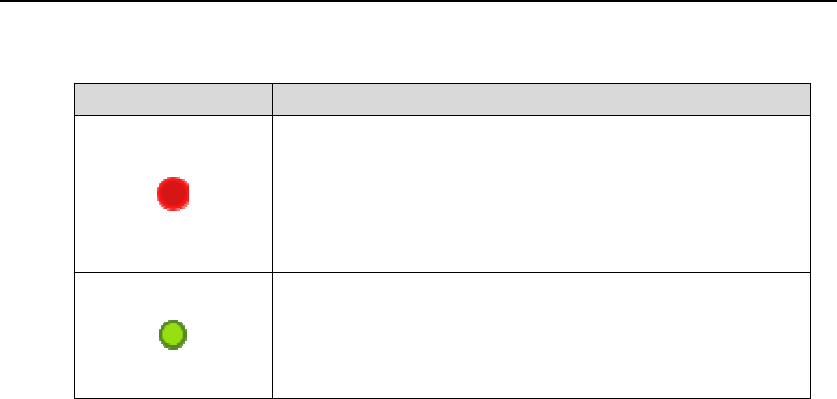
The foll
o
To confi
g
1. Cli
c
2. Sel
e
3. Cli
c
The line
z
Line
z
Spe
e
z
Voi
c
z
Dire
z
Gro
u
z
DT
M
z
Pref
i
z
Loc
a
z
XM
L
z
Xml
z
LD
A
z
Bro
a
z
Co
n
z
For
w
z
Tra
n
z
Hol
d
z
DN
D
z
Red
z
SMS
o
win
g
table li
s
Icons
g
ure the pa
g
c
k on DSS Ke
y
e
ct Enabled
ck
Confirm t
o
key features
e
d Dial
c
e Mail
ct Pickup
u
p Pickup
M
F
i
x
a
l Group
L
Phone Boo
k
Brower
A
P
a
dSoft Dir
n
ference
w
ard
n
sfe
r
d
D
ial
s
ts the pa
g
e
Fast flash
The BLF
m
non-curr
e
Solid:
There is
a
Fast flash
The line r
e
Solid:
The line i
s
g
e icon statu
s
y
->Line Key.
in the Pa
g
e
T
o
accept the
are explain
e
k
icon status t
ing:
m
onitored us
e
e
nt page.
a
par
k
ed call
in
g
:
e
ceives an i
n
s
in conversa
s
via web us
e
T
ip field.
chan
g
e.
e
d in the foll
o
o indicate t
h
Descripti
o
er
receives a
in the non-
c
n
comin
g
call
tion on the
n
e
r interface:
o
win
g
subch
a
Custo
m
h
e different s
t
o
n
n incomin
g
c
c
urrent pa
g
e
.
on the non-
c
n
on-current
p
a
pters in det
a
m
izing Your P
t
atus:
c
all on the
.
c
urrent pa
ge
p
a
g
e.
a
il:
hone
51
e
.

User Guide SIP-T46G IP Phone
52
z Group Listening
z Public Hold
z Private Hold
z Zero-touch
z URL
z Keypad Lock
For more information, contact your system administrator.
Line
You can use this key feature to accept the incoming calls, place active calls on hold or
resume a held call. It performs the same as a hard line key.
Dependencies: Type (Line)
Account ID (the account this feature will be applied to)
Value (Default/Lock/Float)
Usage: When receiving an incoming call, the DSS key LED flashes green:
1. Press the DSS key to accept the incoming call.
2. Press the DSS key to place the active call on hold.
3. Press the DSS key again to resume the held call.
If Auto is selected from the Account ID field, press the DSS key when the phone is idle,
you can then dial out using the first registered account.
When you select Lock in the Value field, the line keys located in the same position of
the other page will be automatically assigned Line feature with Lock filled in the Value
field. You can use this key feature on every page. This feature is only applicable to line
key 1-5.
When you select Float in the Value field, the phone will automatically switch to the
page where the line receives an incoming call.
Speed Dial
You can use this key feature to speed up dialing the numbers often used or hard to
remember.
Dependencies: Type (Speed Dial)
Account ID (the account this feature will be applied to)
Label (key label displays on the LCD screen)
Value (the number you want to dial out)
Usage: Press the DSS key to dial out the number specified in the Value field, using the
account selected from the Account ID field.
Voice Mail
You can use this key feature to connect voice mail quickly. For more information, refer

Customizing Your Phone
53
to Voice Mail on page 107.
Dependencies: Type (Key Event)
Key Type (Voice Mail)
Account ID (the account this feature will be applied to)
Label (key label displays on the LCD screen)
Value (the voice mail access code)
Usage: Press the DSS key to dial out the voice mail access code, you can follow the
voice prompt to listen to the voice mails.
Direct Pickup
You can use this key feature to answer someone else’s incoming call on the phone.
Dependencies: Type (Key Event)
Key Type (Direct Pickup)
Account ID (the account this feature will be applied to)
Label (key label displays on the LCD screen)
Value (the direct pickup code followed by the specific phone number)
Usage: Press the DSS key on your phone when the specific phone number receives an
incoming call. The call is answered on your phone.
Group Pickup
You can use this key feature to answer incoming calls in a group that is associated with
their own group.
Dependencies: Type (Key Event)
Key Type (Group Pickup)
Account ID (the account this feature will be applied to)
Label (key label displays on the LCD screen)
Value (the group pickup feature code)
Usage: Press the DSS key on your phone when a phone number in the group receives
an incoming call. The call is answered on your phone.
DTMF
You can use this key feature to send the specification of arbitrary key sequences via
DTMF.
Dependencies: Type (Key Event)
Key Type (DTMF)
Label (key label displays on the LCD screen)
Value (DTMF sequence)
Note DTMF sequence is allowed to be: "0-9", "*", "#" and "A-D".

User Guide SIP-T46G IP Phone
54
Usage: Press the DSS key during an active call to send the key sequence specified in the
Value field.
Prefix
You can use this key feature to add a specified prefix number before the dialed
number.
Dependencies: Type (Key Event)
Key Type (Prefix)
Label (key label displays on the LCD screen)
Value (the prefix number)
Usage: Press the DSS key when the phone is idle, the phone enters into the dialing
screen and displays the prefix number which you specified in the Value field, enter
other digits and then dial out.
Local Group
You can use this key feature to access the contact group in the local directory quickly.
For more information, refer to Local Directory on page 36.
Dependencies: Type (Key Event)
Key Type (Local Group)
Local Group (the contact group name you want to access)
Label (key label displays on the LCD screen)
Usage: Press the DSS key to access the contact group specified in the Local Group field.
XML Phone Book
You can use this key feature to access the remote group in your corporate directory
quickly. You should configure the remote phonebook in advance. For more information,
refer to Remote Phonebook on page 42.
Dependencies: Type (Key Event)
Key Type (XML Phone Book)
Phone Book Name (the remote group name you want to access if the
remote phonebook is configured)
Label (key label displays on the LCD screen)
Usage: Press the DSS key to access the remote group specified in the Phone Book Name
field.
Xml Browser
You can use this key feature to access the Xml browser quickly. The Xml browser allows
you to create custom services which meet your functional requirements on the server.
You can customize practical applications, such as weather report, stock information,
Google search, etc.
Dependencies: Type (Xml Browser)

Customizing Your Phone
55
Label (key label displays on the LCD screen)
Xml Browser (the access URL for xml browser)
Usage: Press the DSS key to access the Xml browser specified in the Xml Browser field.
LDAP
You can use this key feature to access the LDAP search interface quickly.
Dependencies: Type (Key Event)
Key Type (LDAP)
Label (key label displays on the LCD screen)
Usage:
1. Press the DSS key to access the LDAP search interface.
2. Enter a few continuous characters of the contact name or continuous numbers of
the contact phone number using the keypad.
The contacts whose name or phone number matches the characters entered will
appear on the LCD screen.
BroadSoft Dir
You can use this key feature to access the BroadSoft group in the BroadSoft phonebook
quickly. You should configure the BroadSoft phonebook in advance. For more
information, refer to BroadSoft Phonebook on page 43.
Dependencies: Type (Key Event)
Key Type (BroadSoft Dir)
BroadSoft Name (the BroadSoft group name you want to access if the
BroadSoft phonebook is configured)
Label (key label displays on the LCD screen)
Usage: Press the DSS key to access the BroadSoft group specified in the BroadSoft
Name field.
Conference
You can use this key feature to set up a conference call. For more information, refer to
Conference on page 83.
Dependencies: Type (Key Event)
Key Type (Conf)
Label (key label displays on the LCD screen)
Value (the number you want to add to the conference)
Usage: Press the DSS key during an active call to set up a conference with the number
specified in the Value field.
Note When leaving the Value field blank, the DSS key performs the same as the Conf soft key
during a call.

User Guide SIP-T46G IP Phone
56
Forward
You can use this key feature to forward an incoming call to someone else. For more
information, refer to Call Forward on page 79.
Dependencies: Type (Key Event)
Key Type (Forward)
Label (key label displays on the LCD screen)
Value (the number you want to forward to)
Usage: Press the DSS key to forward an incoming call to the number specified in the
Value field.
Note
Transfer
You can use this key feature to handle the call differently depending on the transfer
mode on DSS key when there is an active call on the phone.
Dependencies: Type (Key Event)
Key Type (Transfer)
Label (key label displays on the LCD screen)
Value (the number you want to transfer to)
Usage:
z When the transfer mode on DSS key is Blind Transfer, press the DSS key to complete
the blind transfer to the number specified in the Value field.
z When the transfer mode on DSS key is Attended Transfer, press the DSS key to dial
out the number specified in the Value field, and then you can complete the
attended or semi-attended transfer.
z When the transfer mode on DSS key is New Call, press the DSS key, the number
specified in the Value field displays on the LCD screen, and then you can
complete the blind, attended or semi-attended transfer.
Note
Hold
You can use this key feature to place an active call on hold or retrieve a held call.
You can configure the transfer mode on DSS key via web user interface at the path
Phone->Features->Transfer Settings. For more information on how to configure the
transfer mode on DSS key, refer to Busy Lamp Field (BLF) on page 92.
When leaving the Value field blank, the DSS key performs the same as the TRANSFER key
or the Transfer soft key during a call. For more information, refer to Call Transfer on page
81.
When leaving the Value field blank, the DSS key performs the same as the Forward soft
key when receiving an incoming call.

Customizing Your Phone
57
Dependencies: Type (Key Event)
Key Type (Hold)
Label (key label displays on the LCD screen)
Usage:
1. Press the DSS key during an active call to place the call on hold.
2. Press the DSS key again to retrieve the held call.
DND
You can use this key feature to activate or deactivate the DND mode.
Dependencies: Type (Key Event)
Key Type (DND)
Label (key label displays on the LCD screen)
Usage:
1. Press the DSS key to activate the DND mode.
2. Press the DSS key again to deactivate the DND mode.
Note
Redial
You can use this key feature to access the Dialed Calls list. Press the DSS key when the
phone is idle, then you can select an entry to redial.
Dependencies: Type (Key Event)
Key Type (Redial)
Label (key label displays on the LCD screen)
Usage:
1. Press the DSS key when the phone is idle to access the dialed calls list.
2. Select an entry and press the DSS key again to redial the call.
SMS
You can use this key feature to quick access the text message feature. For more
information, refer to Short Message Service (SMS) on page 105.
Dependencies: Type (Key Event)
Key Type (SMS)
Label (key label displays on the LCD screen)
Usage: Press the DSS key when the phone is idle to access the text message feature.
Group Listening
You can use this key feature to activate the Speakerphone and Handset/Headset
mode at the same time. It is suitable for the group conversation which has more than
When the DND mode is activated, all incoming calls will be rejected automatically.

User Guide SIP-T46G IP Phone
58
one person at one side. You are able to speak and listen through the handset/headset,
meanwhile the others nearby can only listen through the speaker.
Dependencies: Type (Key Event)
Key Type (Group Listening)
Label (key label displays on the LCD screen)
Usage:
1. During a call, press the DSS key to activate group listening mode.
You can then speak and listen through the handset/headset, other people at your
side can listen through speaker at the same time.
2. Press the DSS key again to deactivate group listening mode.
Public Hold
You can use this key feature to place an active call on public hold or retrieve a public
held call. The public hold feature is often used in the shared line.
Dependencies: Type (Key Event)
Key Type (Public Hold)
Label (key label displays on the LCD screen)
Usage:
1. Press the DSS key when there is an active call on the shared line.
The active call is placed on public hold.
2. Press the DSS key again to retrieve the public held call.
Note
Private Hold
You can use this key feature to place an active call on private hold or retrieve a private
held call. The private hold feature is often used in the shared line.
Dependencies: Type (Key Event)
Key Type (Private Hold)
Label (key label displays on the LCD screen)
Usage:
1. Press the DSS key when there is an active call on the shared line.
The active call is placed on private hold.
2. Press the DSS key again to retrieve the private held call.
Note
When the DSS key is used in the private line, it performs the same as the HOLD key or the
Hold soft key during a call.
When the DSS key is used in the private line, it performs the same as the HOLD key or the
Hold soft key during a call.

Customizing Your Phone
59
Zero-touch
You can use this key feature to configure auto provision and network parameters
quickly.
Dependencies: Type (Key Event)
Key Type (Zero-touch)
Label (key label displays on the LCD screen)
Usage:
1. Press the DSS key to access the zero-touch interface.
2. Press the OK soft key within a few seconds.
3. Configure the network parameters in the corresponding fields.
4. Press the Next soft key.
5. Configure the auto provision parameters in the corresponding fields.
6. Press the OK soft key.
The phone will reboot to update configurations.
URL
You can use this key feature to access a specific URL quickly.
Dependencies: Type (URL)
Label (key label displays on the LCD screen)
URL (the URL you want to access)
Usage: Press the DSS key to access the URL specified in the URL field.
Keypad Lock
You can use this key feature to immediately lock the keypad of your phone instead of
long pressing . For more information, refer to Keypad Lock on page 30.
Dependencies: Type (Key Event)
Key Type (Keypad Lock)
Label (key label displays on the LCD screen)
Usage: Press the DSS key to immediately lock the keypad of your phone instead of long
pressing .
Programmable Keys
You can customize the soft keys, navigation keys and function keys on the keypad.
To customize the programmable keys via web user interface:
1. Click on DSS Key->Programmable Key.
2. Customize specific features for these keys.
3. Click Confirm to accept the change.

User Guide SIP-T46G IP Phone
60
Note
Account Management
You can register one or multiple accounts on the SIP-T46G IP phone. You can also
configure each line key associated with an account or configure multiple line keys
associated with an account.
Account Registration
To register an account via phone user interface:
1. Press Menu->Setting->Advanced Settings (password: admin) ->Accounts.
2. Select the desired account and then press the Enter soft key.
3. Select Enable from the Activation field.
4. Enter the desired values in Label, Display Name, Register Name, User Name,
Password and SIP Server fields respectively. Contact your system administrator for
more information.
5. Press the Save soft key to accept the change or the Back soft key to cancel.
6. Repeat steps 2 to 5 until you have registered all accounts.
The following figures show single or multiple accounts registered on the phone:
Single account:
Multiple accounts:
You can configure the programmable keys via web user interface only.
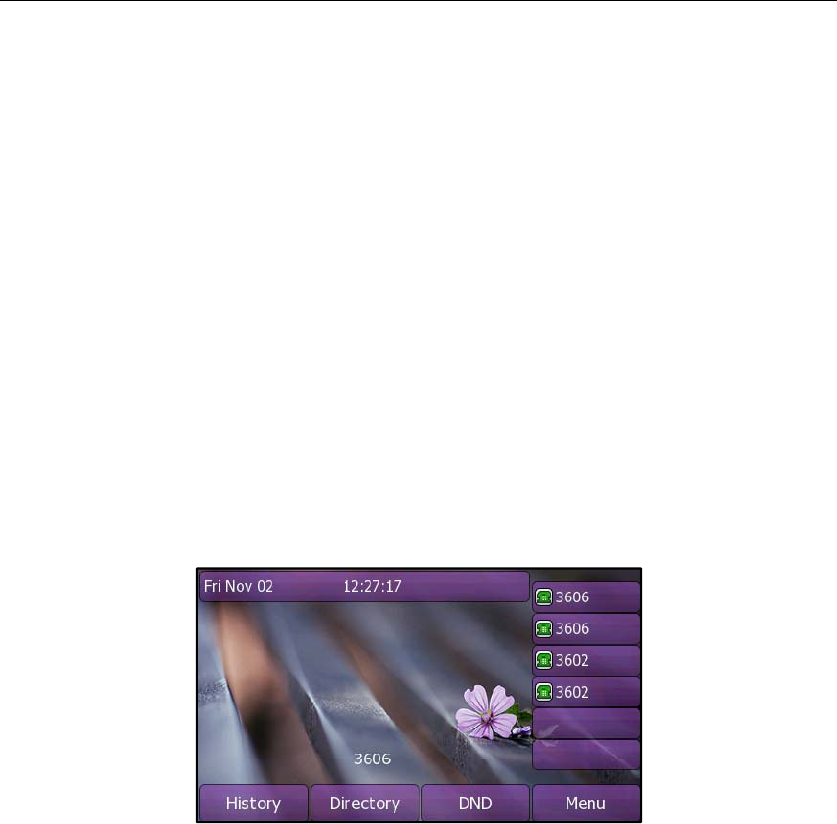
Customizing Your Phone
61
To disable an account via phone user interface:
1. Press Menu->Setting->Advanced Settings (password: admin) ->Accounts.
2. Select the desired account and then press the Enter soft key.
3. Select Disable from the Activation field.
4. Press the Save soft key to accept the change or the Back soft key to cancel.
You can also register or disable an account via web user interface at the path
Account->Basic.
Multiple Line Keys per Account
You can configure multiple line keys associated with an account. This enhances call
visualization and simplifies call handling.
If this is the case, the LCD screen could resemble the following figure:
Incoming calls to this line will be distributed evenly among the available line keys.
Similarly, outgoing calls will be distributed.
Your phone can be configured to have a combination of lines with a single line key and
lines with multiple line keys.
Dial Plan
Dial plan is a string of characters that governs the way your SIP-T46G IP phone processes
the inputs received from your phone keypad. The SIP-T46G IP phone supports the
following dial plan features:
z Replace Rule
z Dial-now
z Area Code
z Block Out

User Guide SIP-T46G IP Phone
62
The basic expression syntax you need to know:
Syntax Description
.
The dot"." can be used as a placeholder or multiple placeholders for
any character. Example:
"12." would match "123", "1234","12345","12abc", etc.
x An "x" can be used as a placeholder for any character. Example:
"12x" would match "121", "122","123","12a", etc.
[]
The square brackets "[]"can be used as a placeholder for a single
character which matches any of a set of characters. Example:
"91[5-7]1234"would match "9151234", "9161234","9171234",etc.
()
The parentheses"( )"can be used to group together patterns, for
instance, to logically combine two or more patterns. Example:
"([1-9])([2-7])3" would match "923", "153", "773",etc.
$
The “$” should be followed by the sequence number of a parenthesis.
The “$” plus the sequence number means the whole character or
characters placed in the parenthesis. The number directs to the right
parenthesis when there are more than one. Example:
A replace rule configuration: Number: "9([5-7])(.)", Replace: "5$2". When
you enter "96123" to dial out on your phone, the number will be
replaced as "5123" and then dialed out.“$2” means the characters in
the second parenthesis, that is, “123”.
Note
Replace Rule
You can configure one or more replace rules to remove the specified string and
replace it with another string. You can configure a pattern with wildcards (expression
syntax refer to the table above), so that any string that matches the pattern will be
replaced. This feature is convenient for you to dial out a long number. For example, a
replace rule is configured as "Number: 1" and "Replace: 1234567", then when you try to
dial out the number “1234567”, you just need to enter “1” on the phone and then press
the Send soft key.
To add a replace rule via web user interface:
1. Click on Phone->Dial Plan->Replace Rule.
2. Enter the string (e.g. 2xx) in the Number field.
3. Enter the string (e.g. 12345) in the Replace field.
4. Enter the desired line ID in the Account field or leave it blank.
5. Click ADD to add the replace rule.
6. Click Save to accept the change.
You can configure the dial plan rules via web user interface only.

Customizing Your Phone
63
When you enter the number “234” using the keypad and then dial out, the phone
will dial out “12345” instead.
Note
To edit a replace rule via web user interface:
1. Click on Phone->Dial Plan->Replace Rule.
2. Select the desired replace rule by checking the check box.
3. Edit the values in the Number and Replace fields.
4. Enter the desired line ID in the Account field or leave it blank.
5. Click Edit to edit the replace rules.
6. Click Save to accept the change.
To delete one or more replace rules via web user interface:
1. Click on Phone->Dial Plan->Replace Rule.
2. Select the one or more replace rules by checking the check box(es).
3. Click Delete to delete the replace rule(s).
4. Click Save to accept the change.
Dial-now
You can configure one or more dial-now rules on your phone. When the dialed out
number matches the dial-now string, the number will be dialed out automatically. For
example, a dial-now rule is configured as "2xx", then entering any three-digit string
begins with 2 will be dialed out automatically on the phone.
To add a dial-now rule via web user interface:
1. Click on Phone->Dial Plan->Dial-now.
2. Enter the desired value (e.g. 1234) in the Dial-now Rule field.
3. Enter the desired line ID in the Account field or leave it blank.
4. Click ADD to add the dial-now rule.
5. Click Save to accept the change.
When you enter the number “1234” using the keypad, the phone will dial out “1234”
automatically without pressing any key.
Note You can also edit or delete the dial-now rule, refer to Replace Rule
on page 62 for more
information.
The valid value of Account field can be one or more digits among1, 2, 3, 4, 5 and 6. Each
digit must be separated by a “,”. For example: when you enter the value “1, 2” in the
Account field, this replace rule will apply to account1 and account2.
If you leave the Account field blank or enter an invalid value, then the replace rule will
apply to all accounts.

User Guide SIP-T46G IP Phone
64
Dial-now Time-out
You can configure the interval for dial-now rules. That is, you can configure your phone
to dial out the phone number automatically, which matches a dial-now rule, after the
specified delay time.
To configure the timeout for dial-now rule via web user interface:
1. Click on Phone->Features.
2. Click the “+” sign on the left of the General Information to expand the feature list.
3. Enter the time within 0-14 (in seconds) in the Dial-now Time-out (seconds) field.
4. Click Confirm to accept the change.
Area Code
Area codes are also known as Numbering Plan Areas (NPAs). They usually indicate
geographical areas in a country. This feature is necessary only when dialing outside the
code area. For example, area code is configured as "Code: 011, Minimum Length: 4,
Maximum Length: 11", then when you dial out the number "56789", the phone will add
the area code and dial out the number "01156789".
To configure the area code and lengths via web user interface:
1. Click on Phone->Dial Plan->Area Code.
2. Enter the desired values in the Code, Minimum Length (1-15) and Maximum Length
(1-15) fields.
3. Enter the desired line ID in the Account field or leave it blank.
4. Click Confirm to accept the change.
Note
Block Out
You can block the dialing of specific numbers. When you dial a block out number on
your phone, the dialing will fail and the LCD screen will prompt "Forbidden Number".
To add a block out number via web user interface:
1. Click on Phone->Dial Plan->Block Out.
2. Enter the desired value in the Block Out Number field.
3. Enter the desired line ID in the Account field or leave it blank.
4. Click Confirm to add the block out number.
The default values of minimum and maximum length are 1 and 15 respectively.

Customizing Your Phone
65
Emergency Number
Public telephone networks in countries around the world have a single emergency
telephone number (emergency services number), that allows a caller to contact local
emergency services for assistance when required. The emergency telephone number
may differ from country to country. It is typically a three-digit number so that it can be
easily remembered and dialed quickly. Some countries have a different emergency
number for each of the different emergency services.
You can specify the emergency telephone numbers on the IP phone for contacting
the emergency services in an emergency situation.
Note
To specify emergency numbers via web user interface:
1. Click on Phone->Features.
2. Click the “+” sign on the left of the Phone Lock to expand the feature list.
3. Enter the emergency services number in the Emergency field. For multiple numbers,
enter a "," between each emergency number.
The default emergency numbers are 112,911 and 110.
4. Click Confirm to accept the change.
Live Dialpad
You can enable the live dialpad feature on the SIP-T46G IP phone, which enables the IP
phone to automatically dial out the phone number without pressing any other key. You
can also configure a period of time before automatically dialing out the phone
number.
To enable the live dialpad via web user interface:
1. Click on Phone->Features.
2. Click the “+” sign on the left of the General Information to expand the feature list.
3. Select Enabled from the pull-down list of Live Dialpad.
4. Enter the desired delay time (0~14s) in the Inter Digit Time (1~14) (seconds) field.
5. Click Confirm to accept the change.
Note The default delay time of live dialpad feature is 4s.
You can configure live dialpad via web user interface only.
Contact your local phone service provider for available emergency numbers in your
area.
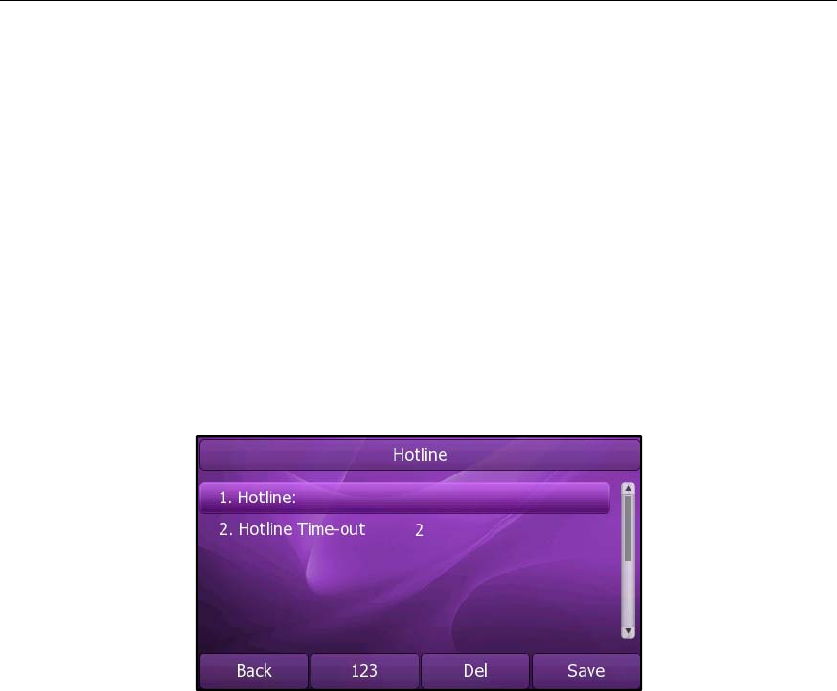
User Guide SIP-T46G IP Phone
66
Hotline
You can dial a hotline number immediately once you lift the handset, press the
speakerphone key or press a line key. You can also configure a period of delay time to
dial out the hotline number, the phone will dial out the hotline number automatically
after the specified delay time.
To configure the hotline number via phone user interface:
1. Press Menu->Features->Hotline.
2. Enter the desired number in the Hotline field.
3. Enter the delay time (seconds) in the Hotline Time-out field.
4. Press the Save soft key to accept the change or the Back soft key to cancel.
You can also configure hotline via web user interface at the path
Phone->Features->General Information.

User Guide SIP-T46G IP Phone
68
Basic Call Features
The SIP-T46G IP phone is designed to be easily used like a regular phone on a public
switched telephone network (PSTN). You can place calls, answer calls, transfer a call to
someone else, or conduct a conference call.
This chapter provides basic operating instructions for the SIP-T46G IP phone. The topics
include:
z Placing Calls
z Answering Calls
z Ending Calls
z Redialing Numbers
z Auto Answer
z Auto Redial
z Call Completion
z Call Return
z Call Mute
z Call Hold/Resume
z Do Not Disturb (DND)
z Call Forward
z Call Transfer
z Call Waiting
z Conference
z Call Park
z Call Pickup
z Anonymous Call
z Anonymous Call Rejection
If you require additional information or assistance with your new phone, contact your
system administrator.
Placing Calls
You can place a call in three ways using your SIP-T46G IP phone:
z Using the handset
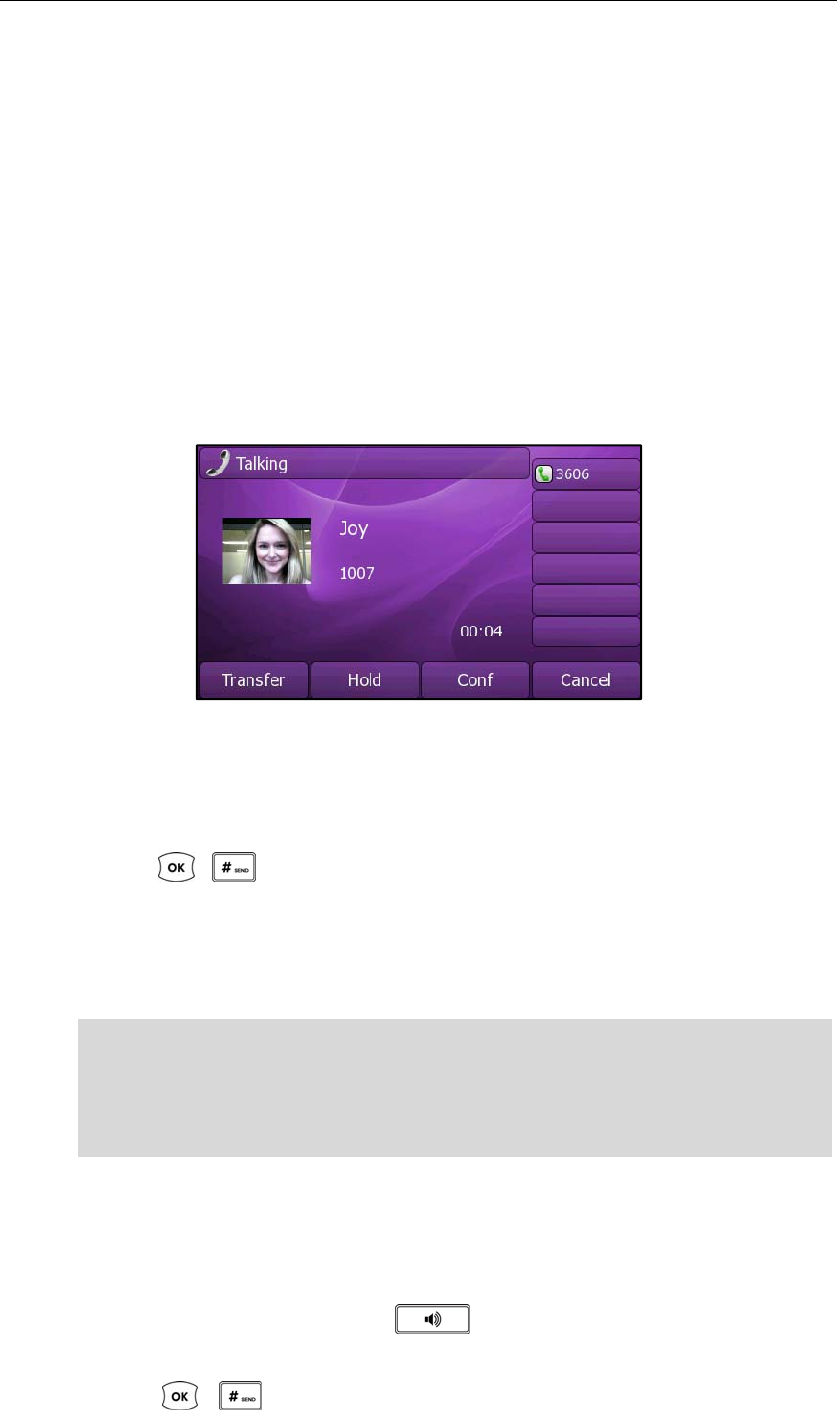
Basic Call Features
69
z Using the speakerphone
z Using the headset
You can also dial the number first, and then choose the way you want to speak to the
other party.
You can search the call history, the local contact directory or the remote phonebook
and dial from the search results. For more information, refer to Contact Management
on page 35 and Call History Management on page 45.
During a call, you can alternate between Speakerphone, Headset, or Handset modes
by pressing the Speakerphone key, the HEADSET key, or picking up the handset.
The call duration of active calls is visible on the LCD screen. In the figure below, the call
to the number ”1000” has lasted 4 seconds.
To place a call using the handset:
1. Pick up the handset.
2. Enter the desired number using the keypad.
3. Press , , or the Send soft key.
By default, the # key is set to be a send key. You can set the * key as send key or set
neither of them to be send keys. For more information, refer to the Key as Send on page
30.
Note
To place a call using the hands-free speakerphone mode:
Do one of the following:
- With the handset on-hook, press or the line key to obtain a dial tone.
Enter the desired number using the keypad.
Press , or the Send soft key.
You can also dial using the SIP URI or IP address. To obtain the IP address of your phone,
press the OK key. The maximum SIP URI or IP address length is 32 characters. For
example, 192.168.1.15, SIP URI: 3606@sip.com.
Your phone may not support direct IP dialing. Contact your system administrator for
more information.
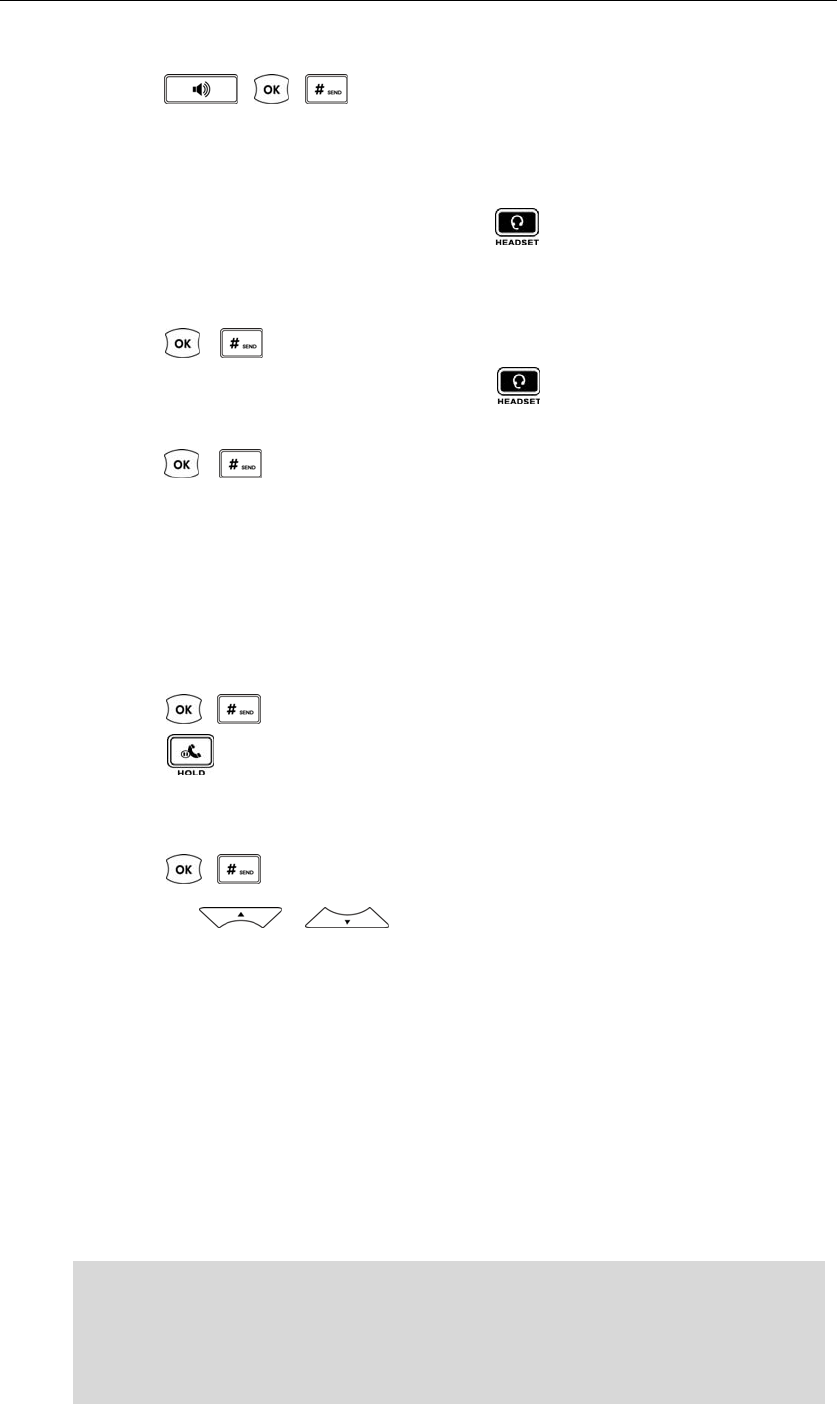
User Guide SIP-T46G IP Phone
70
- With the handset on-hook, enter the desired number using the keypad.
Press , , or the Send soft key.
To place a call using the headset:
Do one of the following:
- With the optional headset connected, press to activate the headset mode.
Press the line key to obtain a dial tone.
Enter the desired number using the keypad.
Press , , or the Send soft key.
- With the optional headset connected, press to activate the headset mode.
Enter the desired number using the keypad.
Press , , or the Send soft key.
To place multiple calls:
You can have more than one call on your SIP-T46G IP phone. To place a new call
during an active call, do one of the following:
- Press the line key. The active call is placed on hold.
Enter the desired number using the keypad.
Press , , or the Send soft key.
- Press or the Hold soft key to place the original call on hold.
Press the New Call soft key.
Enter the desired number using the keypad.
Press , , or the Send soft key.
You can press or to switch between the calls, and then press the
Resume soft key to retrieve the desired call.
Answering Calls
When you are not in another call, you can answer a call in three ways:
z Using the handset
z Using the speakerphone
z Using the headset
Note You can ignore incoming calls by pressing the X key, the Reject soft key or the Silence
soft key. You can also activate Do Not Disturb mode to ignore all incoming calls without
ring on your phone. For more information, refer to Do Not Disturb (DND) on page 78.
You can forward incoming calls to someone else by pressing the Forward soft key. For
more information, refer to Call Forward on page 79.

Basic Call Features
71
Answering When Not in Another Call
In all cases, the active call will appear on the LCD screen showing call duration and
destination.
To answer a call using the handset:
1. Pick up the handset.
To answer a call using the hands-free speakerphone mode:
Do one of the following:
- Press .
- With the handset on-hook and the headset mode deactivated, press the Answer
soft key.
- With the handset on-hook and the headset mode deactivated, press the line key
(the line key LED flashes green).
To answer a call using the headset:
Do one of the following:
- Press .
- With the headset mode activated, press the Answer soft key.
- With the headset mode activated, press the line key (the line key LED flashes
green).
Answering When in Another Call
If you have an active call, and an incoming call arrives on the phone, do one of the
following:
- Press the Answer soft key.
The incoming call is answered and the original call is placed on hold.
- Press to access the new call.
Press or the Answer soft key.
The incoming call is answered and the original call is placed on hold.
Ending Calls
To end a call:
Do one of the following:
- If you are using the handset, press the Cancel soft key or hang up the handset.
- If you are using the headset, press the Cancel soft key.
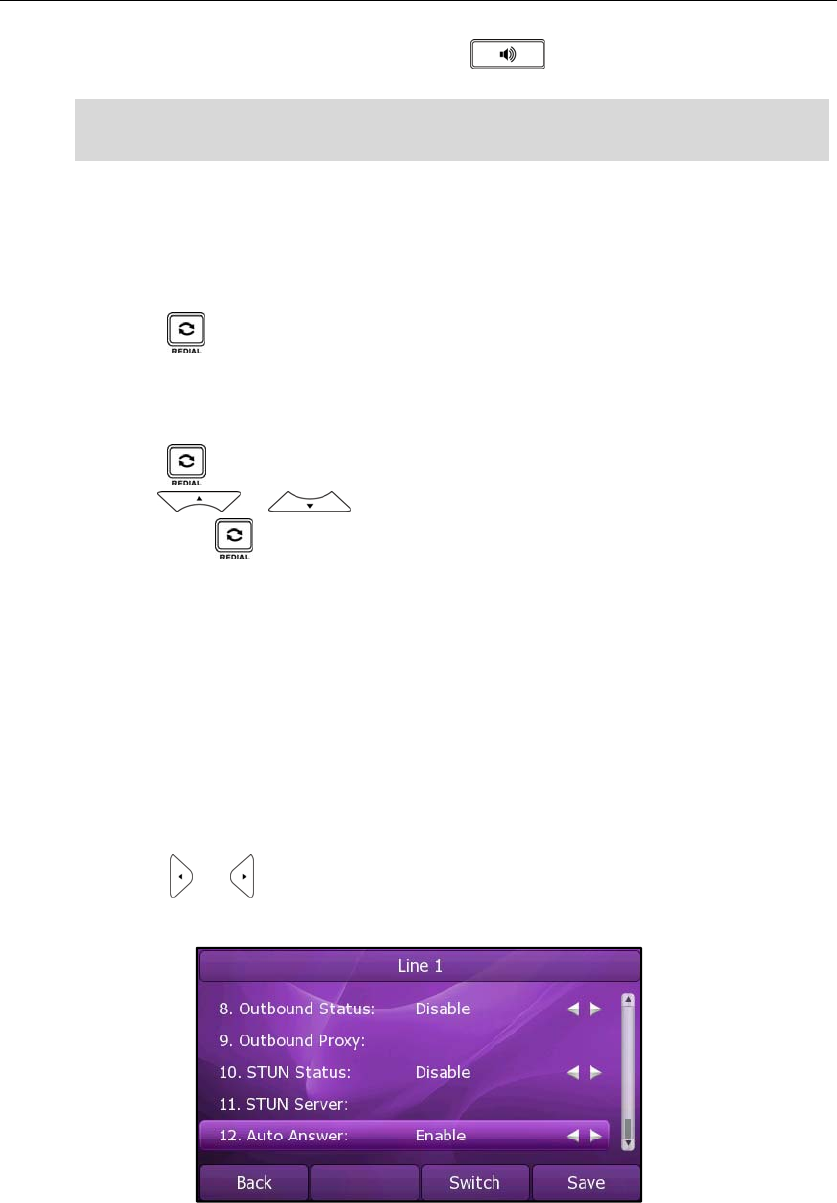
User Guide SIP-T46G IP Phone
72
- If you are using the speakerphone, press or the Cancel soft key.
Note
Redialing Numbers
To redial the last placed call from your phone:
1. Press twice.
A call to your last placed call is attempted.
To redial a previously placed call from your phone:
1. Press when the phone is idle.
2. Press or to select the desired entry from the dialed calls list, and
then press or the Send soft key.
Auto Answer
You can enable the auto answer feature for a line. You can use the auto answer
feature to allow the phone to automatically answer an incoming call on the line.
To configure auto answer via phone user interface:
1. Press Menu->Setting->Advanced Settings (password: admin) ->Accounts.
2. Select the desired account and then press the Enter soft key.
3. Press or , or the Switch soft key to select Enable from the Auto Answer
field.
To end a call placed on hold, you can press the Cancel soft key to end the call directly,
or press the Resume soft key to resume the call before ending it.
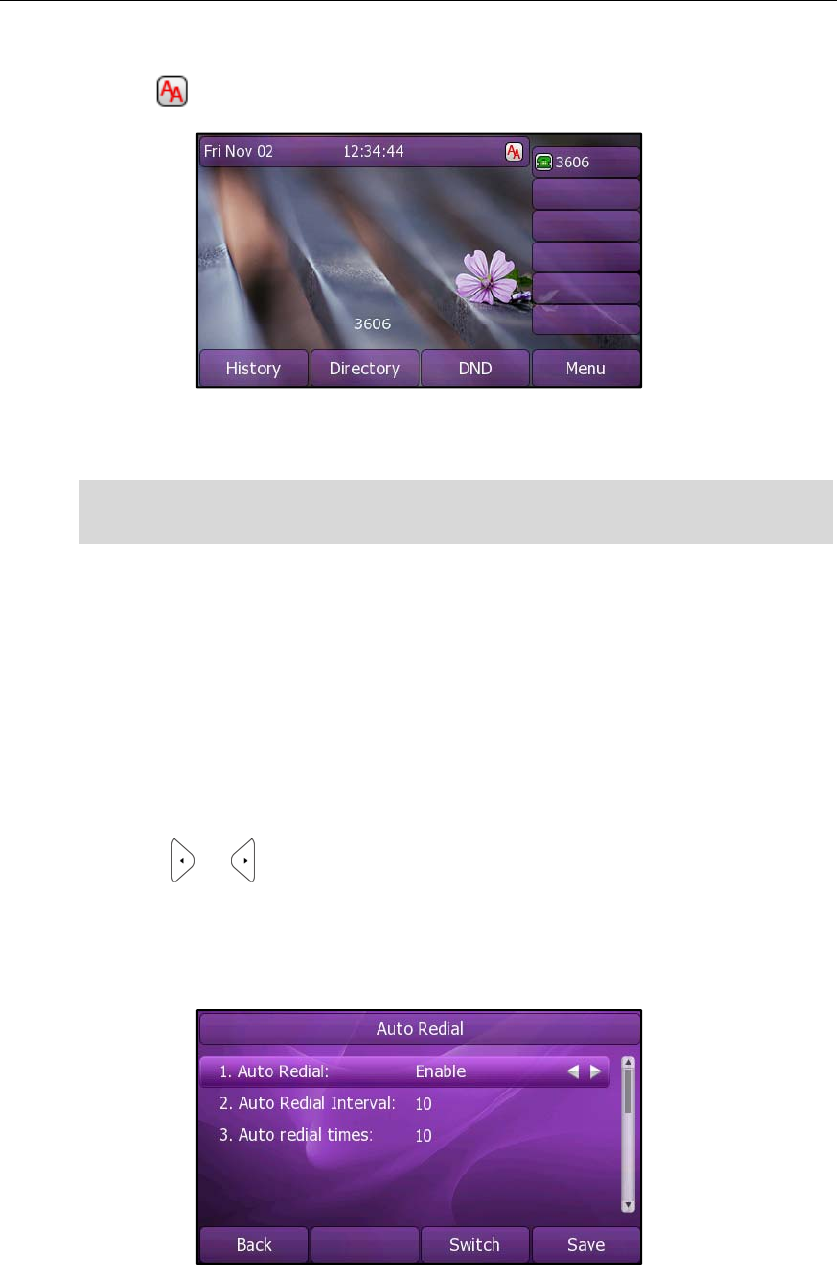
Basic Call Features
73
4. Press the Save soft key to accept the change or the Back soft key to cancel.
The icon appears on the LCD screen.
You can also configure auto answer via web user interface at the path Account.
Note
Auto Redial
You can enable the auto redial feature to redial the phone number automatically
when the called party is busy. You can also configure the times of the auto redial and
the time to wait between redial attempts.
To configure auto redial via phone user interface:
1. Press Menu->Features->Auto Redial.
2. Press or , or the Switch soft key to select Enable from the Auto Redial field.
3. Enter the desired time in the Auto Redial Interval field (the default time interval is
10s).
4. Enter the desired times in the Auto redial times field (the default times are 10).
5. Press the Save soft key to accept the change or the Back soft key to cancel.
You can also configure auto redial via web user interface at the path
Phone->Features->General Information.
The auto answer feature is not applicable to answer another incoming call
automatically when there is an active call on the phone.
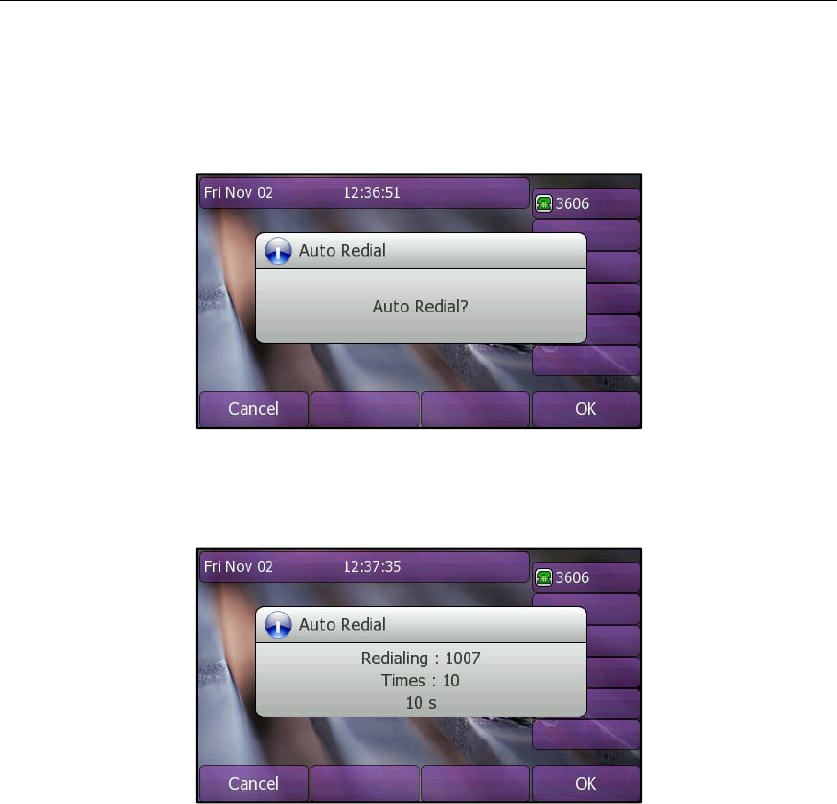
User Guide SIP-T46G IP Phone
74
To use auto redial:
When the called party is busy, the following prompt will appear on the LCD screen of
the phone:
1. Press the OK soft key to activate auto redial. The following prompt will appear on
the LCD screen of the phone:
2. Wait for a period of time or press the OK soft key to redial the phone number.
The phone will retry as many times as you configured until the called party is idle.
Call Completion
You can use the call completion feature to notify the caller of a failed call when the
callee becomes available to receive a call.
To configure call completion via phone user interface:
1. Press Menu->Features->Call Completion.
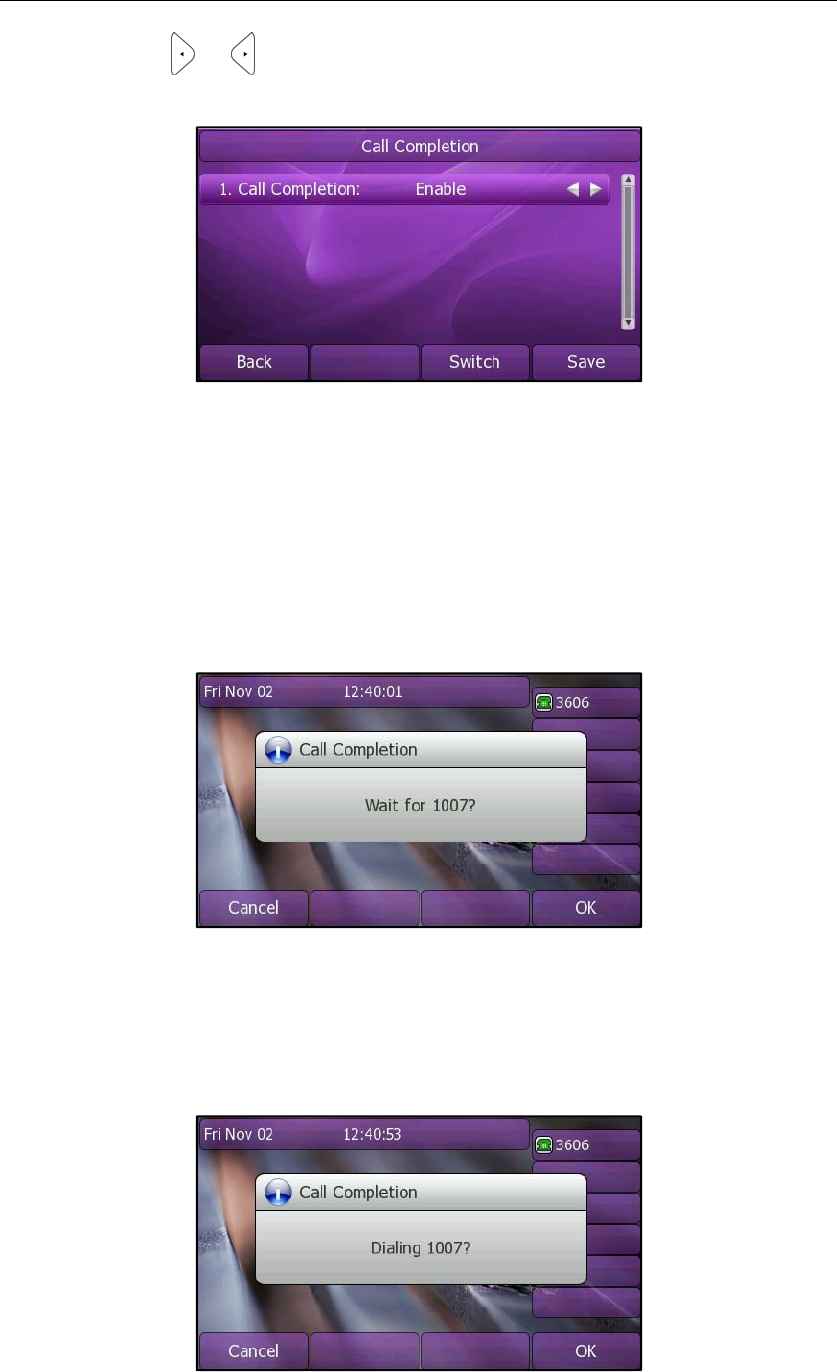
Basic Call Features
75
2. Press or , or the Switch soft key to select Enable from the Call Completion
field.
3. Press the Save soft key to accept the change or the Back soft key to cancel.
You can also configure call completion via web user interface at the path
Phone->Features->General Information.
To use call completion:
When the called party is busy, the following prompt will appear on the LCD screen of
the phone:
1. Press the OK soft key, the phone returns to the idle screen and call completion is
activated.
2. When the called party becomes idle, the following prompt appears on the LCD
screen of the phone:
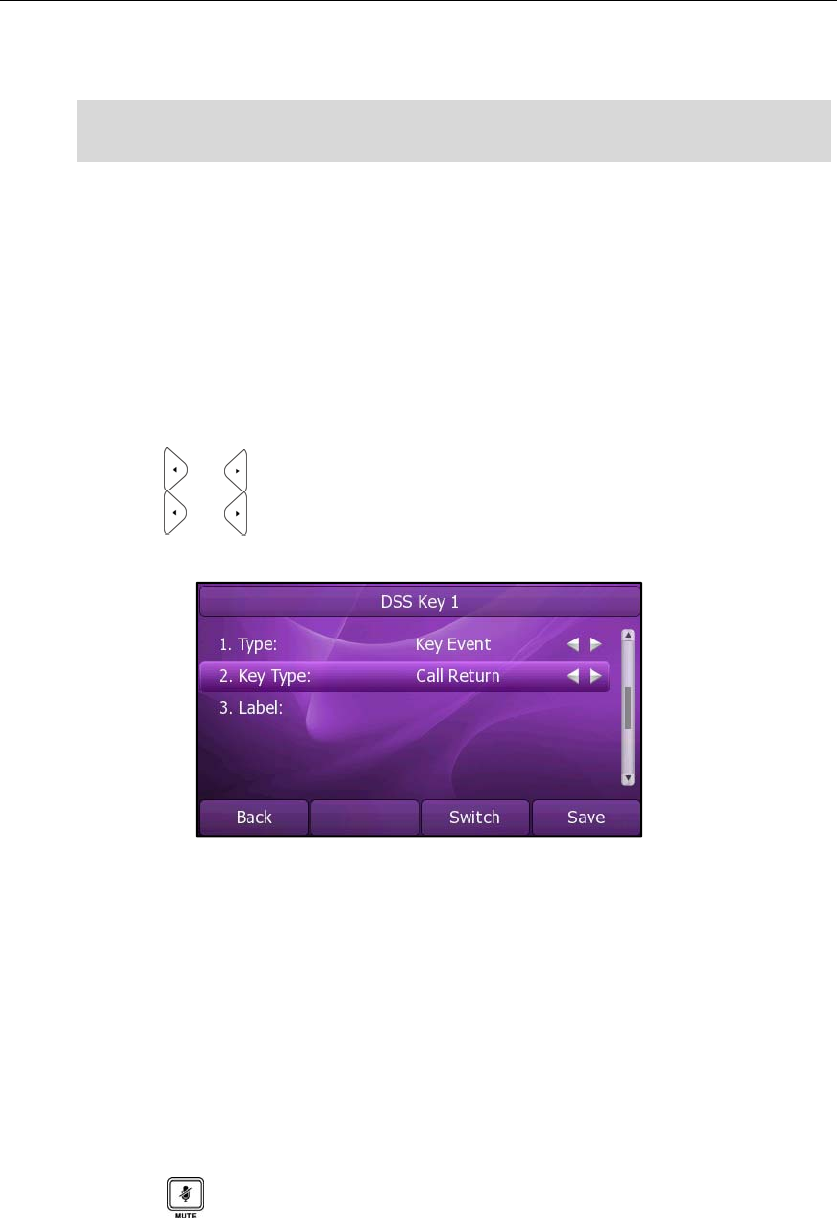
User Guide SIP-T46G IP Phone
76
3. Press the OK soft key to redial the number.
Note
Call Return
You can press a call return key to place a call back to the last incoming call.
To configure a call return key via phone user interface:
1. Press Menu->Features->DSS Keys.
2. Select a desired DSS key.
3. Press or , or the Switch soft key to select Key Event from the Type field.
4. Press or , or the Switch soft key to select Call Return from the Key Type
field.
5. Press the Save soft key to accept the change or the Back soft key to cancel.
You can also configure a call return key via web user interface at the path DSS Key.
Call Mute
You can mute the microphone of the active audio device during an active call, and
then the other party cannot hear you.
To mute a call:
1. Press during an active call.
The MUTE key LED illuminates solid red when the mute mode is activated.
The call completion feature is not available on all servers. For more information, contact
your system administrator.
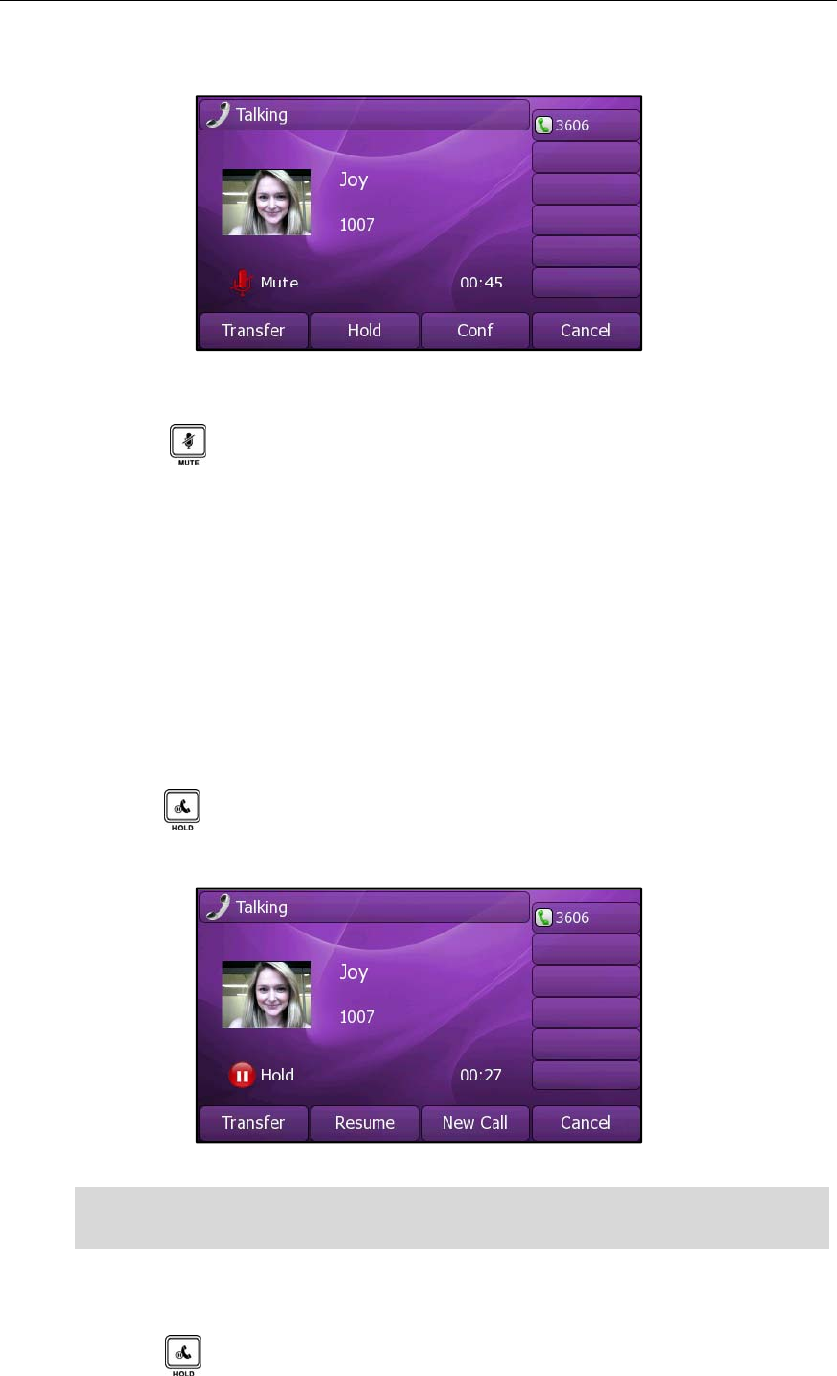
Basic Call Features
77
The phone LCD screen indicates that the call is on mute.
To un-mute a call:
1. Press again to un-mute the call.
The MUTE key LED turns off when the mute mode is deactivated.
Call Hold/Resume
You can place an active call on hold. At any time, at most one active call can be in
progress on your phone, other calls can be received and made while placing the
original call on hold. When placing a call on hold, your IP PBX might play a melody or
message to the other party while waiting.
To place a call on hold:
1. Press or the Hold soft key during a call.
The phone LCD screen shows the call is on hold and the line key LED flashes green.
Note
To resume a held call:
1. Press or the Resume soft key.
The phone will beep softly every 30 seconds to remind you that you still have a call on
hold.
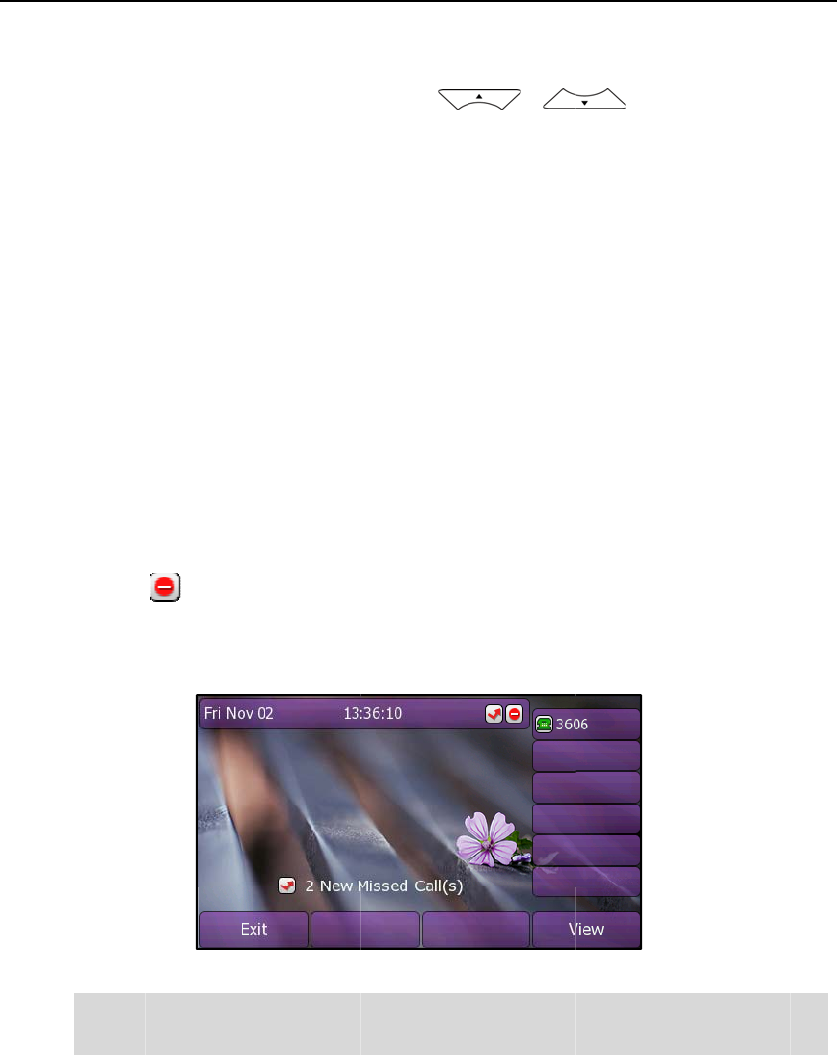
User
78
D
o
Not
e
Guide SIP-T4
6
Multiple
If multip
l
calls, an
If more
t
exampl
e
If multip
l
line key
o
Not Di
s
You ca
n
and the
To activ
a
1. Pres
The
Inc
o
indi
c
e
To spec
i
1. Cli
c
2. Cli
c
3. Ent
e
mu
4. Cli
c
If DND m
from the
The Do
setting
s
6
G IP Phone
Calls on Hol
d
l
e calls are p
d then press
t
han two cal
l
e
"2/4", indic
a
l
e calls are o
to retrieve t
h
s
turb (
D
n
use the DN
D
callers can
h
a
te DND fea
t
s the DND so
icon on
o
min
g
calls
w
c
ates the nu
m
i
fy the DND
a
c
k on Phone-
c
k the “+” si
g
e
r the numb
e
ltiple numbe
c
k Confirm t
o
ode is enabl
numbers sp
e
Not Disturb f
e
s
. For more in
f
d
:
laced on ho
the Resume
l
s are on hol
d
a
tin
g
that thi
s
n hold on m
o
h
e call.
D
ND)
D
feature to
r
h
ear a busy
s
t
ure on the SI
ft key when
t
the idle scr
e
w
ill be re
j
ect
e
m
ber of the
m
a
uthorized n
u
>Features.
g
n on the left
er
s in the Au
t
rs, enter a ","
o
accept the
ed on the p
h
e
cified in the
e
ature is loca
f
ormation, co
ld, press
soft key to r
e
d
, an indicat
i
s
is the seco
n
o
re than on
e
r
e
j
ect the in
c
s
i
g
nal o
r
a m
P-T46G IP p
h
t
he phone is
e
en indicate
s
e
d automati
c
m
issed calls
)
u
mbers via w
e
of the Do N
o
t
horized Nu
m
between e
a
chan
g
e.
h
one, the ph
Authorized
N
l to the phon
e
ntact your sy
s
or
e
trieve the d
i
on appears
n
d call out o
f
e
line keys, y
o
c
omin
g
calls
essa
g
e dep
e
h
one:
idle.
s
that the Do
c
ally and "n
N
will prompt
o
e
b user inter
f
o
t Disturb to
e
m
bers
(
com
m
a
ch numbe
r
.
one can still
N
umbers
(
c
o
e
, and may
b
s
tem adminis
t
to swit
c
esired call.
on the LCD
s
f
four calls.
o
u can press
automatica
l
e
ndin
g
on y
o
Not Disturb
m
N
ew Missed
C
o
n the LCD s
c
f
ace:
e
xpand the
f
m
a separate
d
receive the
i
o
mma separ
a
b
e overridden
t
rator.
c
h between
s
creen, for
correspondi
n
l
ly on the ph
o
o
ur server.
m
ode is ena
b
C
all(s)" ("n"
c
reen.
f
eature list.
d)
field. For
i
ncomin
g
ca
a
ted
)
field.
by the serve
r
the
ng
o
ne
b
led.
ll
r

Basic Call Features
79
Call Forward
You can configure your phone to forward incoming calls to another party by the Static
Forwarding. You can also forward calls while your phone rings, refer to the Dynamic
Forwarding.
Static Forwarding
To enable call forward:
1. Press Menu->Features->Call Forward.
2. Press or to select the desired forwarding type, and then press
the Enter soft key. The options are:
Always Forward: Incoming calls are immediately forwarded.
Busy Forward: Incoming calls are immediately forwarded if the phone is busy.
No Answer Forward: Incoming calls are forwarded if not answered after a
period of time.
3. Depending on your selection:
a.) If you select Always Forward:
1) Press or , or the Switch soft key to select Enable from the
Always field.
2) Enter the destination number you want to forward all incoming calls to
in the Forward to field.
3) (Optional.) Enter the always forward on code or off code respectively
in the On Code or Off Code field.
b.) If you select Busy Forward:
1) Press or , or the Switch soft key to select Enable from the Busy
field.
2) Enter the destination number you want to forward all incoming calls to
when the phone is busy in the Forward to field.
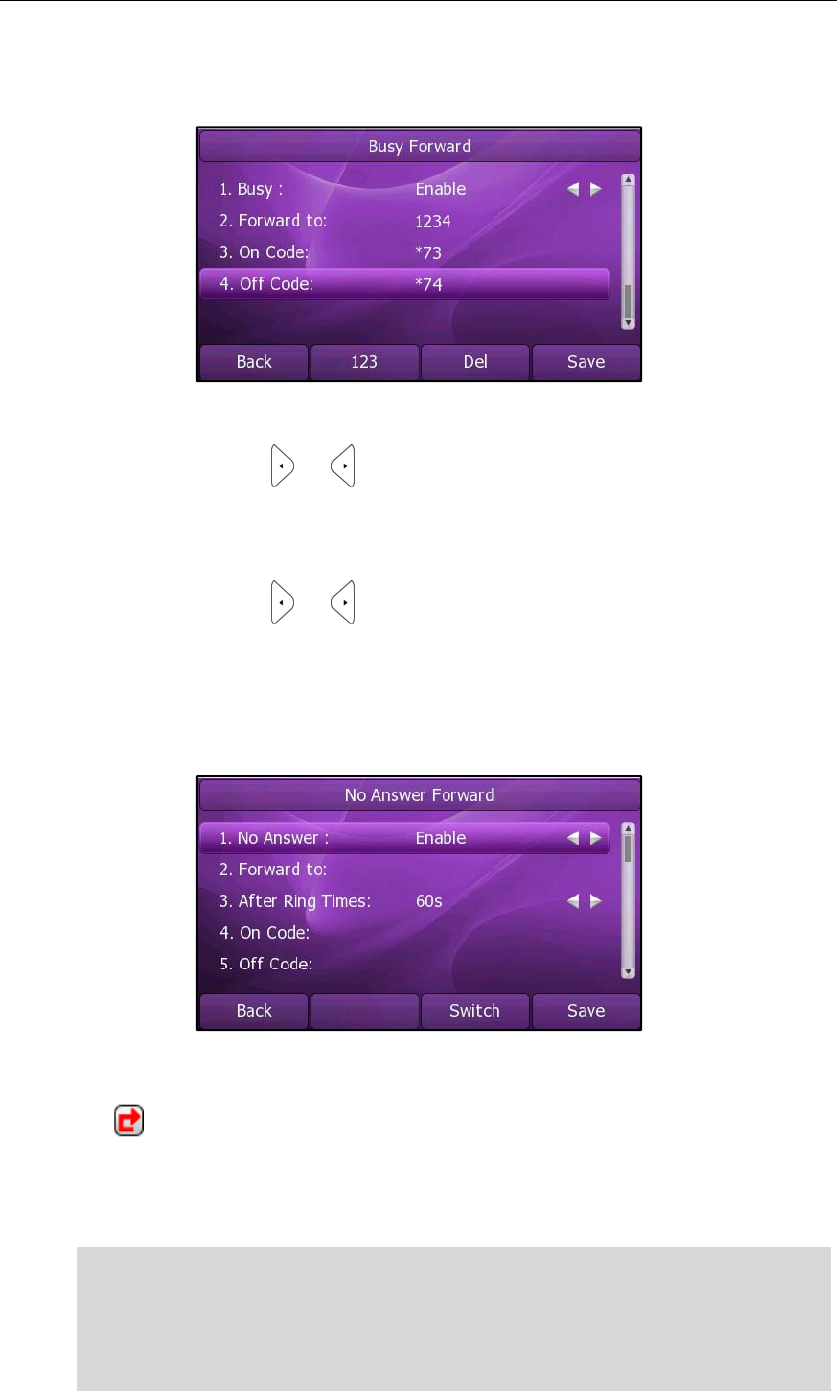
User Guide SIP-T46G IP Phone
80
3) (Optional.) Enter the busy forward on code or off code respectively in
the On Code or Off Code field.
c.) If you select No Answer Forward:
1) Press or , or the Switch soft key to select Enable from the No
Answer field.
2) Enter the destination number you want to forward all unanswered
incoming calls to in the Forward to field.
3) Press or , or the Switch soft key to select the ring time to wait
before forwarding in the After Ring Times field (The default ring time is
60 seconds).
4) (Optional.) Enter the no answer forward on code or off code
respectively in the On Code or Off Code field.
4. Press the Save soft key to accept the change or the Back soft key to cancel.
The icon on the idle screen indicates the call forward is enabled.
You can also configure forward feature via web user interface at the path
Phone->Features->Forward.
Note You can also enter the SIP URL or IP address in the Forward to field. For more information
on using the SIP URL or IP address, refer to Placing Calls on page 68.
Call forward feature is local to the phone, and may be overridden by the server settings.
Call forward on code or off code may be different between servers. For more
information, contact your system administrator.
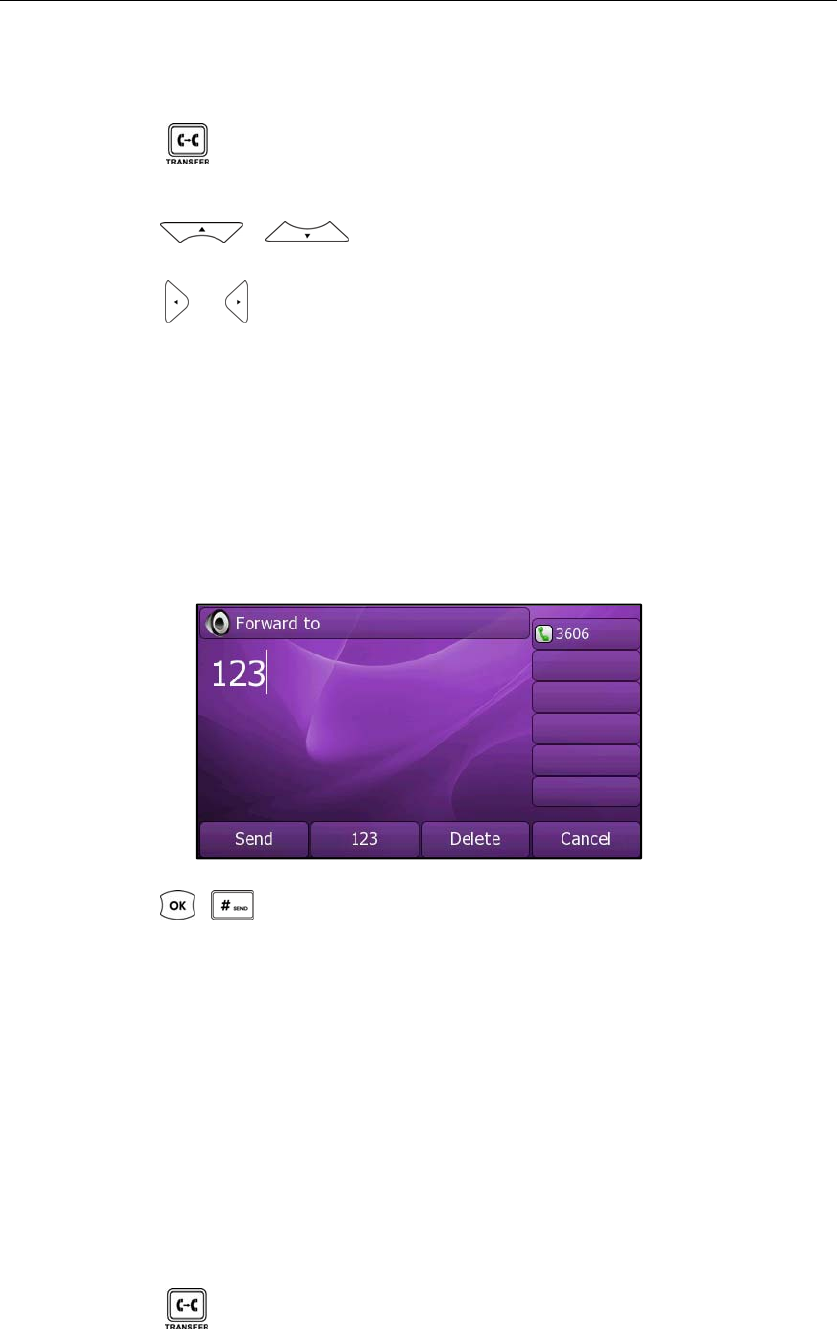
Basic Call Features
81
To disable call forward:
Do one of the following:
- Press when the phone is idle.
- Press Menu->Features->Call Forward.
Press or to select the desired forwarding type, then press the
Enter soft key.
Press or , or the Switch soft key to select Disable to disable the call
forward.
Press the Save soft key to accept the change.
Dynamic Forwarding
To forward an incoming call to another party:
1. When the phone is ringing, press the Forward soft key.
2. Enter the number you want to forward the incoming call to.
3. Press , , or the Send soft key.
The LCD screen prompts a call forward message.
Call Transfer
You can transfer a call to another party in one of the three ways:
z Blind Transfer: Transfer a call directly to another party without consulting.
z Semi-Attended Transfer: Transfer a call when the target phone is ringing.
z Attended Transfer: Transfer a call with prior consulting.
To perform a blind transfer:
1. Press or the Transfer soft key during a call.
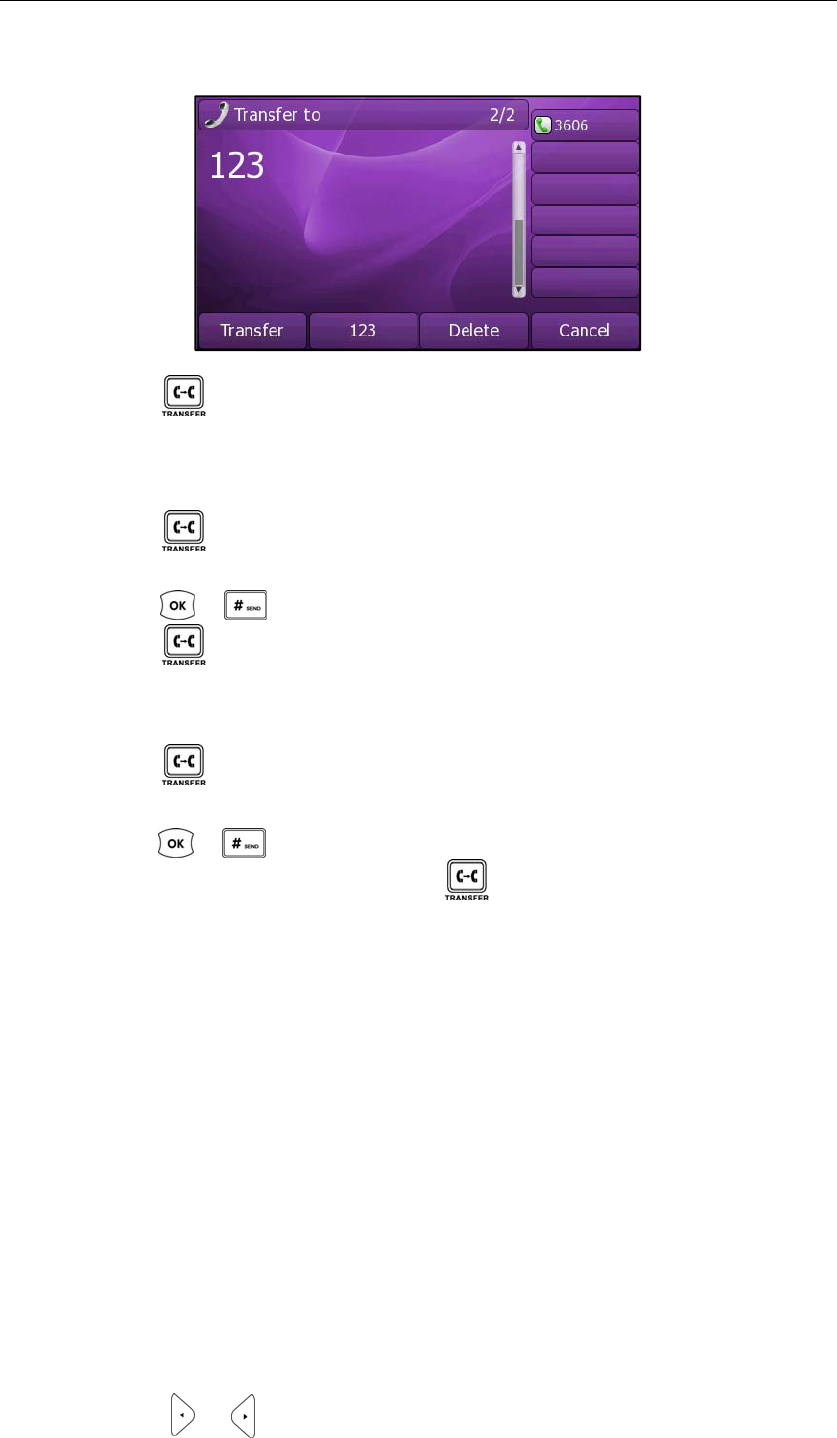
User Guide SIP-T46G IP Phone
82
2. Enter the number you want to transfer the call to.
3. Press or the Transfer soft key to complete the transfer.
Then the call is connected to the number to which you are transferring.
To perform a semi-attended transfer:
1. Press or the Transfer soft key during a call.
2. Enter the number you want to transfer the call to.
3. Press or to dial out.
4. Press or the Transfer soft key to complete the transfer when receiving
ringback.
To perform an attended transfer:
1. Press or the Transfer soft key during a call.
2. Enter the number you want to transfer the call to.
3. Press or to dial out.
4. After the party answers the call, press or the Transfer soft key to complete the
transfer.
If you are using a handset, the transfer can be completed by hanging up the handset.
You can cancel the transfer before the call connects by pressing the Cancel soft key.
Call Waiting
You can enable or disable the call waiting feature on the phone. If the call waiting
feature is enabled, you can receive another call when there is an active call on the
phone. If the call waiting feature is disabled, another incoming call is automatically
rejected by the phone with a busy message when there is an active call on the phone.
You can also enable the play tone feature to hear a warning tone when receiving
another call.
To configure call waiting via phone user interface:
1. Press Menu->Features->Call Waiting.
2. Press or , or the Switch soft key to select Enable from the Call Waiting field.
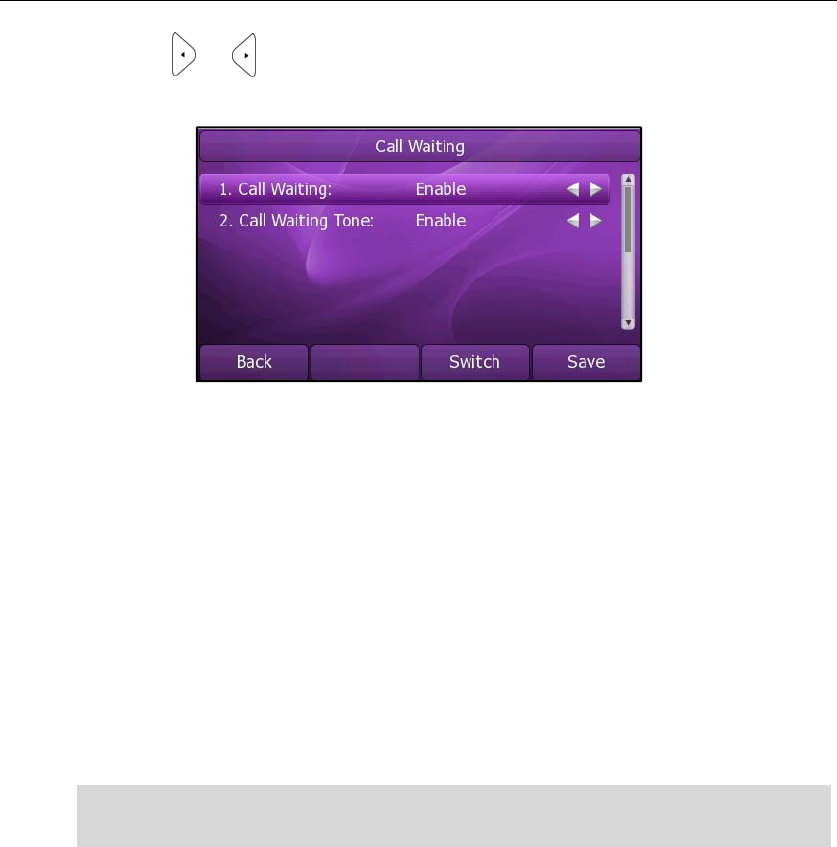
Basic Call Features
83
3. Press or , or the Switch soft key to select Enable from the Call Waiting Tone
field.
4. Press the Save soft key to accept the change or the Back soft key to cancel.
You can also configure the call waiting feature via web user interface at the path
Phone->Features->General Information.
Conference
You can create a conference with other parties using the phone’s local conference
feature. You can create a conference between an active call and a call on hold (on
the same or another line) by pressing the Conf soft key. The network conference feature
allows you to add and remove specific conference parties.
Note
Local Conference
The SIP-T46G IP phone supports up to 3 parties (including yourself) in a conference call.
This is called Local Conference and is the default method of conference.
To set up a local conference call:
1. Place a call to the first party.
2. Press the Conf soft key to create a new call
The active call is placed on hold.
The network conference feature is not available on all servers. For more information,
contact your system administrator.
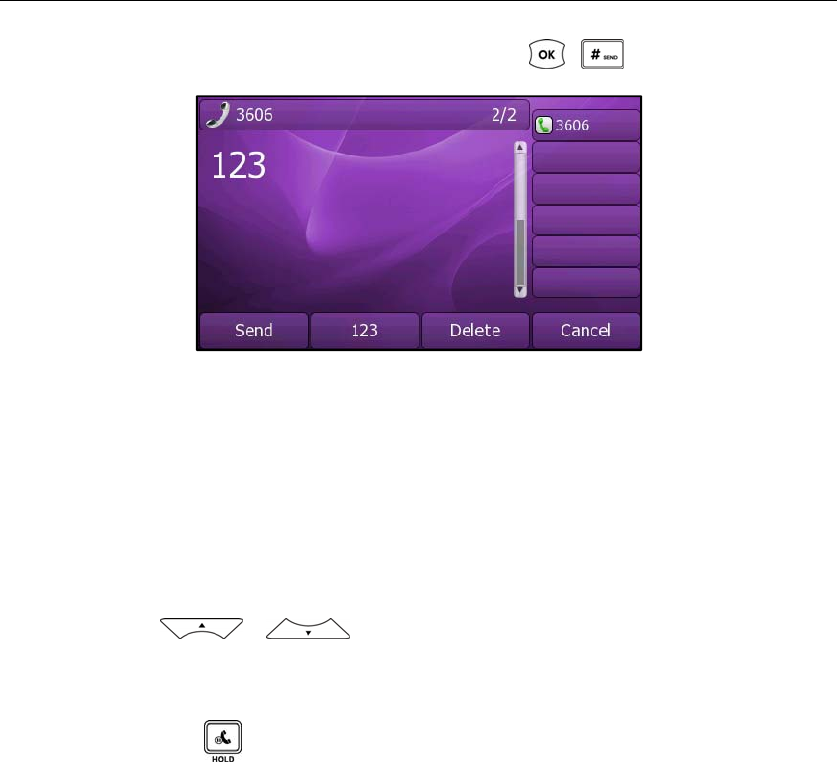
User Guide SIP-T46G IP Phone
84
3. Enter the number of the second party and press , , or the Send soft key.
4. When the second party answers the call, you can consult with him or her before
adding to the conference.
5. Press the Conf soft key again to join all parties in the conference.
To join two calls in a conference:
1. Place two calls using two different accounts on the phone (for example, place the
first call using account 1, and then place the second call using account 2).
2. Press or to select the call for conference and make sure the call
is active (for example, select the call on account 1).
3. Press the Conf soft key to join the two calls in the conference on account 1.
You can press or the Hold soft key to place the conference on hold. You can
press the Split soft key to split the conference call into two individual calls. To drop the
conference call, press the Cancel soft key.
Network Conference
You can use network conference feature on the SIP-T46G IP phone to conduct a
conference with multiple participants.
This feature allows you to perform the following:
z Join two calls together into a conference call.
z Invite another party into an active conference call.
To use this feature, contact your system administrator for the network conference-URI in
advance, and configure the phone via web user interface:
1. Click on Account->Advanced.
2. Select the desired conference type from the pull-down list of Conference Type.
3. Enter the conference URI (e.g. conference@example.com) in the Conference URI
field.
4. Click Confirm to accept the change.

Basic Call Features
85
To set up a network conference call:
1. Place a call to the first party.
2. Press the Conf soft key to create a new call.
The active call is placed on hold.
3. Enter the number of the second party and press , , or the Send soft key.
4. When the second party answers the call, press the Conf soft key to add the second
party to the conference.
5. Press the Conf soft key to create a new call.
The conference is placed on hold.
6. Enter the number of the new party and then press , , or the Send soft
key.
7. When the new party answers the call, press the Conf soft key to add the new party
to the conference.
8. Repeat steps 5 to 7 until you have added all intended parties.
The procedures to set up a network conference call for specific servers may be
different from introduced above. Contact your system administrator for more
information.
Call Park
You can use call park feature to place a call on hold, and then retrieve the call from
another phone in the system (for example, a phone in another office or conference
room). You can park an active call by pressing the call park key on the phone. If the
call is parked successfully, the response is either a voice prompt confirming that the call
was parked, or a visible indication on the LCD screen. When the call is parked
successfully, someone can retrieve the parked call on another phone.
Note
To configure a call park key via phone user interface:
1. Press Menu->Features->DSS Keys.
2. Select the desired DSS key.
3. Press or , or the Switch soft key to select Key Event from the Type field.
4. Press or , or the Switch soft key to select Call Park from the Key Type field.
5. Press or , or the Switch soft key to select the desired line from the Account
ID field.
Call Park feature is not available on all servers. Contact your system administrator for
more information.
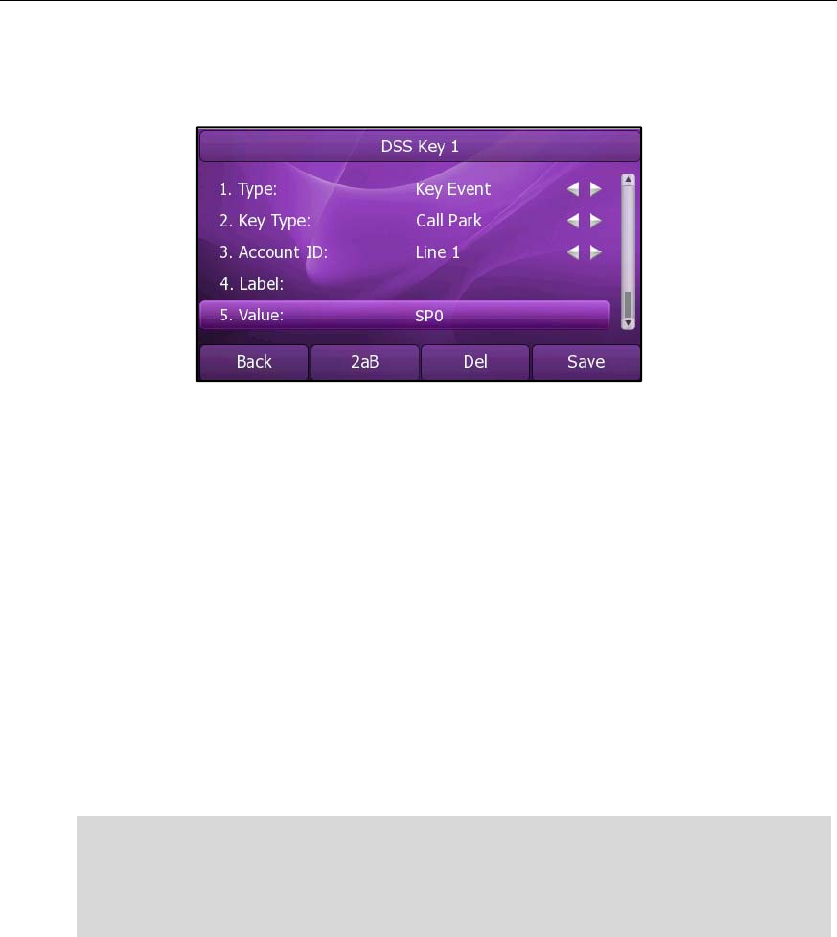
User Guide SIP-T46G IP Phone
86
6. Enter the call park feature code (contact your system administrator for it) in the
Value field.
7. Press the Save soft key to accept the change or the Back soft key to cancel.
You can also configure a call park key via web user interface at the path DSS Key.
To use the Call Park feature:
1. User on phone A places a call to phone B.
2. User on phone A wants to take the call in a conference room for privacy, then
presses the call park key on phone A.
3. User on phone A walks to an available conference room where the phone is
designated as phone C. The user dials the call park retrieve feature code to
retrieve the parked call.
The system establishes call between phone C and B.
Note
Call Pickup
You can use call pickup feature to answer someone else’s incoming call on the phone.
The SIP-T46G IP phone supports the direct call pickup and group call pickup features.
Direct call pickup is used for picking up a call that is ringing at a specific phone number.
Group call pickup is used for picking up a call that is ringing at any phone number in
the group. The pickup group should be predefined, contact your system administrator
for more information.
The call park feature code and call park retrieve feature code
are predefined on the
system server. Contact your system administrator for more information.
If the parked call is not retrieved within a period of time assigned by the system, the
phone performing call park feature will receive call back.
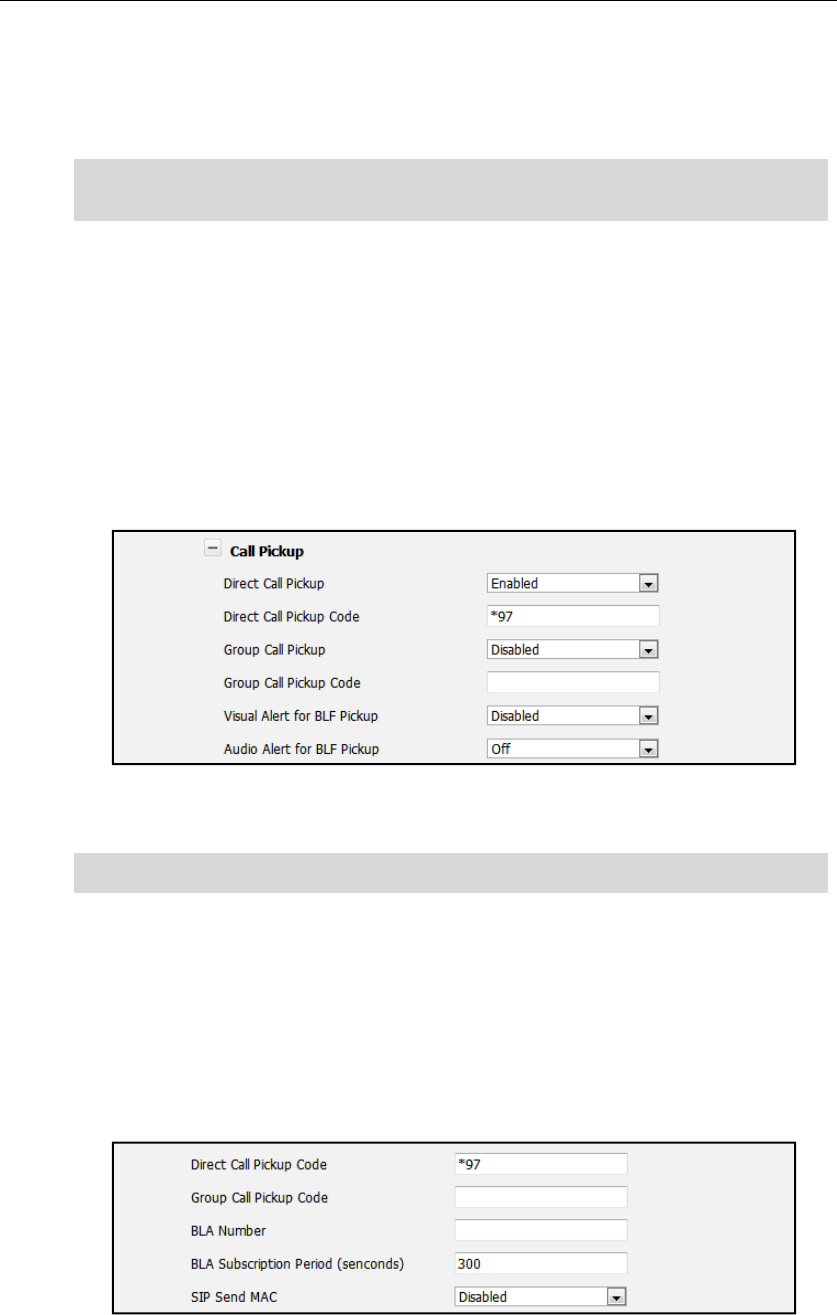
Basic Call Features
87
You can configure the phone to pick up an incoming call by using the
DPickup/GPickup soft key. You can also configure the call pickup code on a global or
per-line basis via web user interface.
Note
Direct Call Pickup
To enable the direct call pickup via web user interface:
1. Click on Phone->Features.
2. Click the “+” sign on the left of the Call Pickup to expand the feature list.
3. Select Enabled from the pull-down list of Direct Call Pickup.
4. Enter the direct call pickup code in the Direct Call Pickup Code field.
5. Click Confirm to accept the change.
Note
To configure the direct call pickup code on a per-account basis via web user interface:
1. Click on Account.
2. Select the desired account from the pull-down list of Account.
3. Click on Advanced under the Account tab.
4. Enter the direct call pickup code in the Direct Call Pickup Code field.
5. Click Confirm to accept the change.
If there are many incoming calls at the same time, press the Gpickup key on the phone
will pick up the call that rings first.
The direct pickup code above is configured on a global, which applies to all accounts.
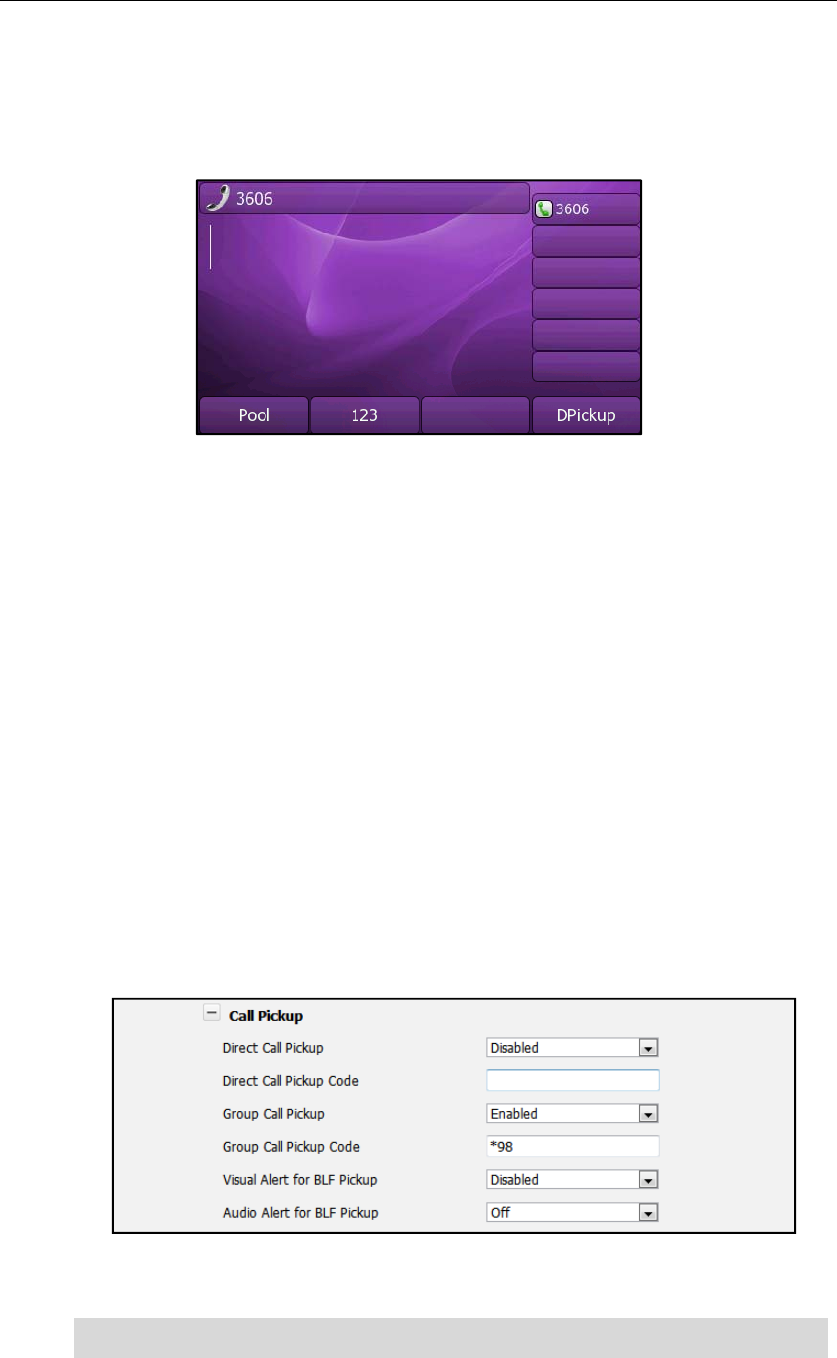
User Guide SIP-T46G IP Phone
88
To pick up a call directly:
1. Pick up the handset.
The DPickup soft key appears on the LCD screen.
2. Press the DPickup soft key on your phone when the specific phone receives an
incoming call.
3. Enter the specific phone number.
4. Press the DPickup soft key.
The call is answered on your phone.
You can also configure a DSS key as a direct pickup key via phone user interface or
web user interface. You can pick up the call by pressing the direct pickup key directly.
Group Call Pickup
To enable the group call pickup via web user interface:
1. Click on Phone->Features.
2. Click the “+” sign on the left of the Call Pickup to expand the feature list.
3. Select Enabled from the pull-down list of Group Call Pickup.
4. Enter the group call pickup code in the Group Call Pickup Code field.
5. Click Confirm to accept the change.
Note
The group pickup code above is configured on a global, which applies to all accounts.
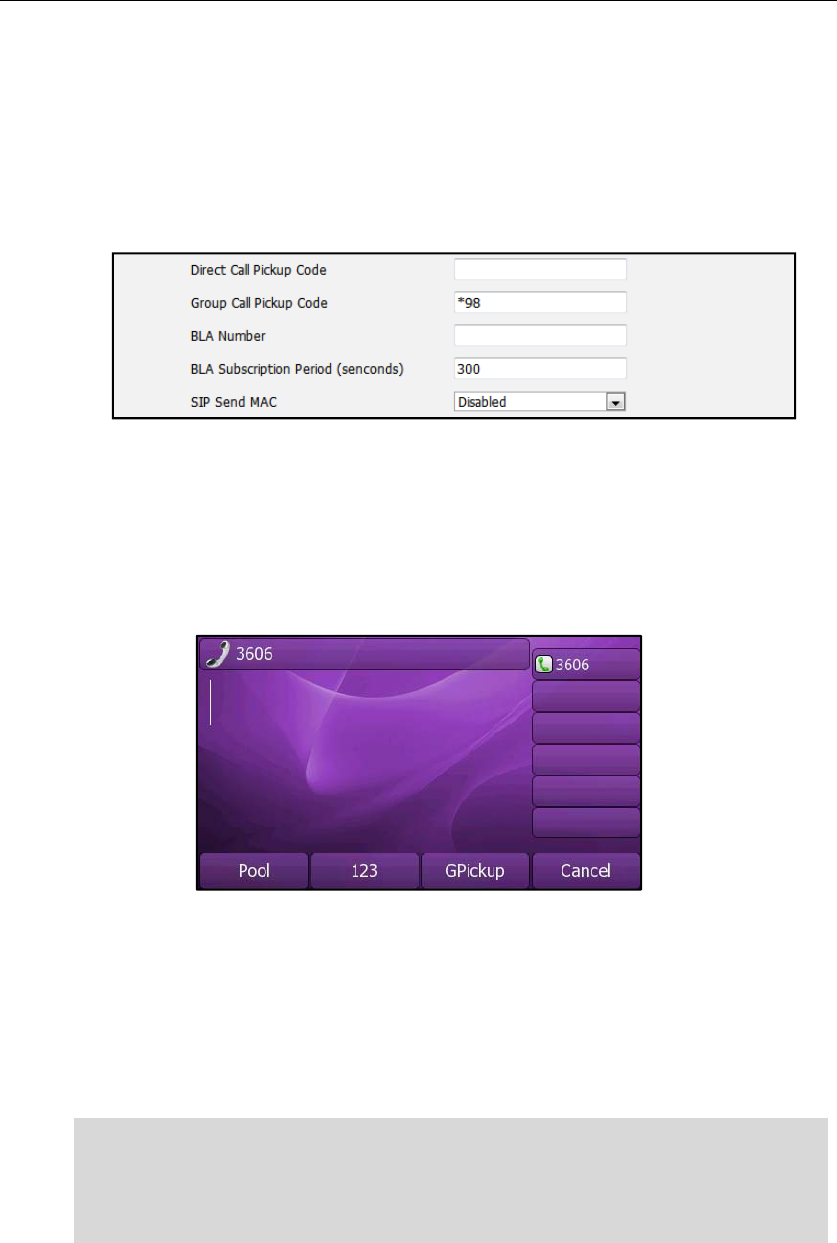
Basic Call Features
89
To configure the group call pickup code on a per-account basis via web user interface:
1. Click on Account.
2. Select the desired account from the pull-down list of Account.
3. Click on Advanced.
4. Enter the group call pickup code in the Group Call Pickup Code field.
5. Click Confirm to accept the change.
To pick up a call in the group:
1. Pick up the handset.
The GPickup soft key appears on the LCD screen.
2. Press the GPickup soft key on your phone when a phone in the group receives an
incoming call.
The call is answered on your phone.
You can also configure a DSS key as group pickup key via phone user interface or web
user interface. You can pick up the call by pressing the group pickup key directly.
Note The directed call pickup code and group call pickup code are predefined on the
system server. Contact your system administrator for more information.
The call pickup code configured on a per-line basis takes precedence over that
configured on a global basis.
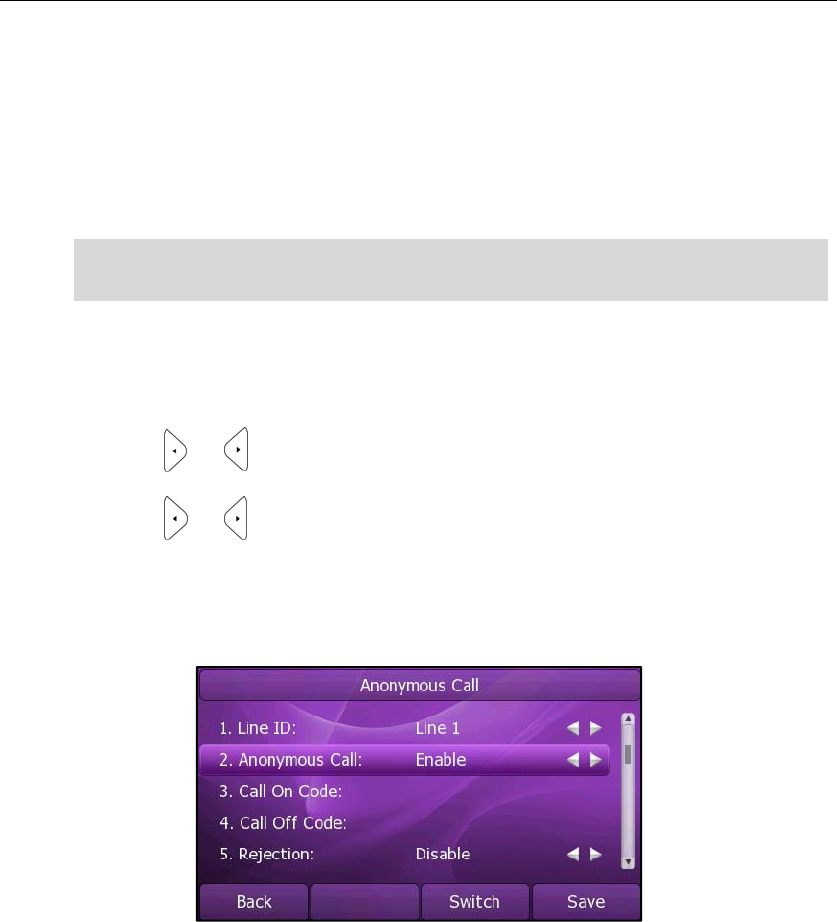
User Guide SIP-T46G IP Phone
90
Anonymous Call
You can use anonymous call feature to block the identity and phone number from
showing up to the called party when you call someone. For example, you want to call
to consult some of the services, but you don’t want to be harassed.
Note
To configure anonymous call via phone user interface:
1. Press Menu->Features->Anonymous Call.
2. Press or , or the Switch soft key to select the desired line from the Line ID
field.
3. Press or , or the Switch soft key to select Enable from the Anonymous Call
field.
4. (Optional.) Enter the anonymous call on code in the Call On Code field.
5. (Optional.) Enter the anonymous call off code in the Call Off Code field.
6. Press the Save soft key to accept the change or the Back soft key to cancel.
You can also configure anonymous call via web user interface at the path
Account->Basic.
To place an anonymous call:
1. Using the specific line on the phone to place a call to phone B.
The anonymous call feature is not available on all servers. Contact your system
administrator for the anonymous call on code and off code.
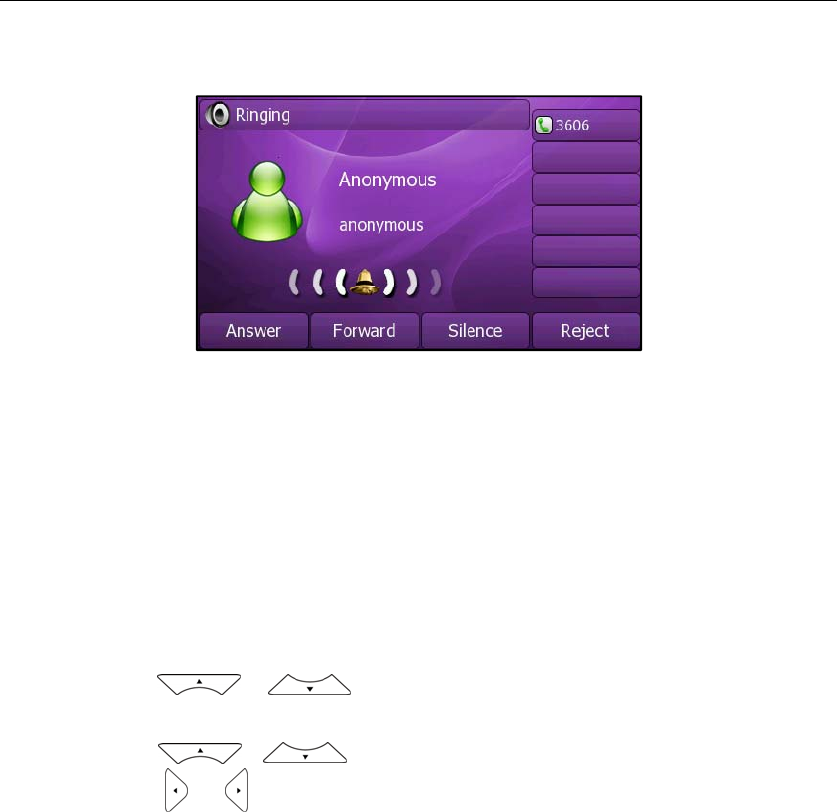
Basic Call Features
91
The LCD screen of phone B prompts an incoming call from anonymity.
Anonymous Call Rejection
You can use anonymous call rejection feature to reject incoming calls from anonymous
callers. Anonymous call rejection automatically rejects incoming calls from callers who
deliberately block their identities and numbers from showing up.
To configure anonymous call rejection via phone user interface:
1. Press Menu->Features->Anonymous Call.
2. Press or , or the Switch soft key to select the desired line from the
Line ID field.
3. Press or to scroll to the Rejection field.
4. Press or , or the Switch soft key to select Enable from the Rejection field.
5. (Optional.) Enter the anonymous call rejection on code in the Reject On Code field.
6. (Optional.) Enter the anonymous call rejection off code in the Reject Off Code field.
7. Press the Save soft key to accept the change or the Back soft key to cancel.
You can also configure anonymous call rejection via web user interface at the path
Account->Basic.

User Guide SIP-T46G IP Phone
92
Advanced Phone Features
This chapter provides operating instructions for the advanced features of the SIP-T46G
IP phone. The topics include:
z Busy Lamp Field (BLF)
z BLF List
z Shared Line
z Call Recording
z Hot Desking
z Intercom
z Automatic Call Distribution (ACD)
z Messages
If you require additional information or assistance with your new phone, contact your
system administrator.
Busy Lamp Field (BLF)
You can use the BLF feature to monitor a specific user for status changes on the phone.
For example, you can configure a BLF key on the phone for monitoring the status of a
friend’s phone (busy or idle). When the friend picks up his phone to make a call, the BLF
key LED illuminates solid red on your phone to indicate that the friend’s phone is in use
and busy. For more BLF key LED indications, refer to LED Instructions on page 5.
You can press a BLF key to dial out the monitored phone number when it is idle. You
can receive a visual alert and an audio alert when the monitored phone is ringing. You
can also pick up a call directly by pressing the BLF key when the monitored phone is
ringing. For more information, contact your system administrator.
To configure a BLF key via phone user interface:
1. Press Menu->Features->DSS Keys.
2. Select the desired DSS key.
3. Press or , or the Switch soft key to select BLF from the Type field.
4. Press or , or the Switch soft key to select the desired line from the Account
ID field.
5. Enter the phone number or extension you want to monitor in the Value field.
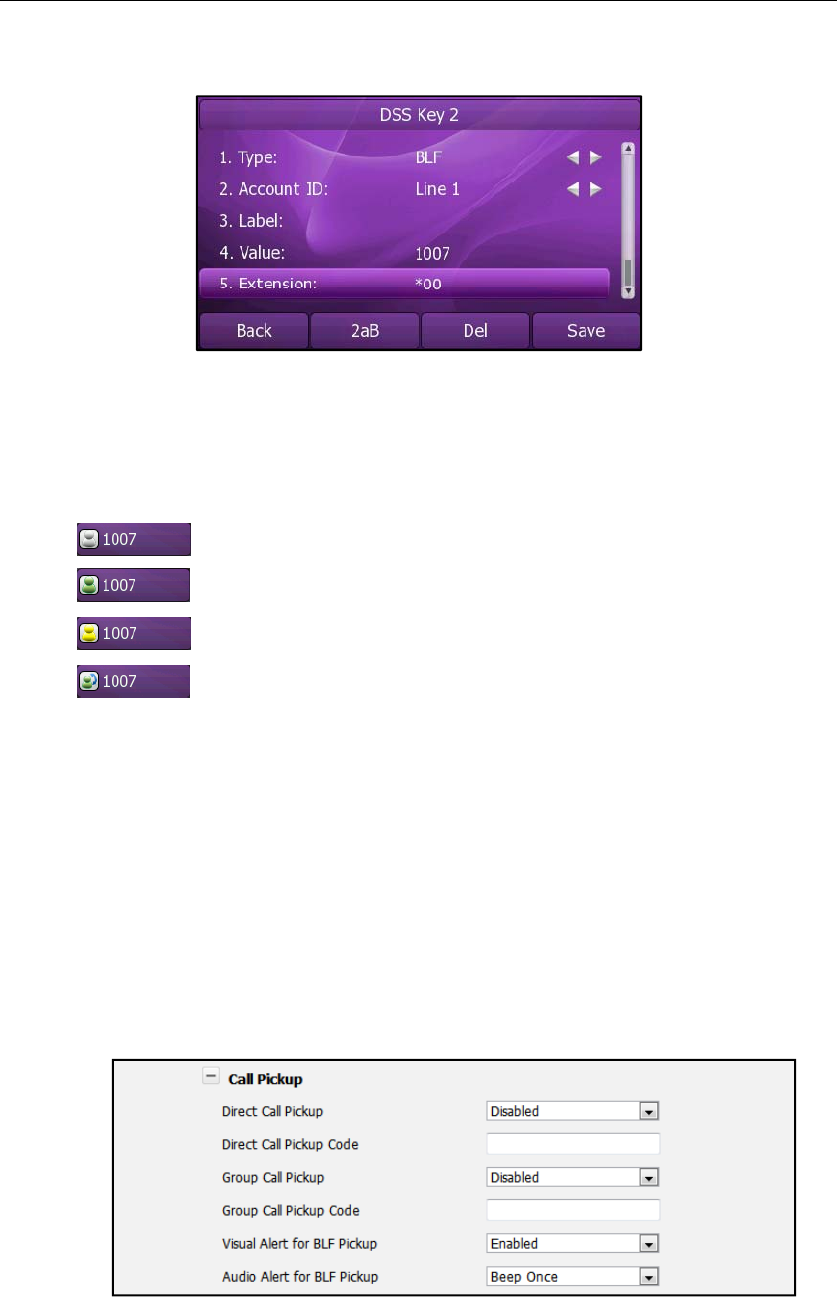
Advanced Phone Features
93
6. (Optional.)Enter the pickup code in the Extension field.
7. Press the Save soft key to accept the change or the Back soft key to cancel.
You can also configure the BLF key via web user interface at the path DSS Key.
The status of the monitored user will be displayed on the BLF key as below:
: The monitored user 1007 does not exist.
: The monitored user 1007 is idle.
: The monitored user 1007 is ringing.
: The monitored user 1007 is during an active call.
When the monitored phone is ringing, you can enable audio alert for BLF pickup
feature to allow the monitoring phone to play a warning tone, you can also enable
visual alert for BLF pickup feature to allow the LCD screen of the monitoring phone to
display the caller ID.
To enable the visual and audio alert feature via web user interface:
1. Click on Phone->Features.
2. Click the “+” sign on the left of the Call Pickup to expand the feature list.
3. Select Enabled from the pull-down list of Visual Alert for BLF Pickup.
4. Select Beep Once from the pull-down list of Audio Alert for BLF Pickup.
5. Click Confirm to accept the change.
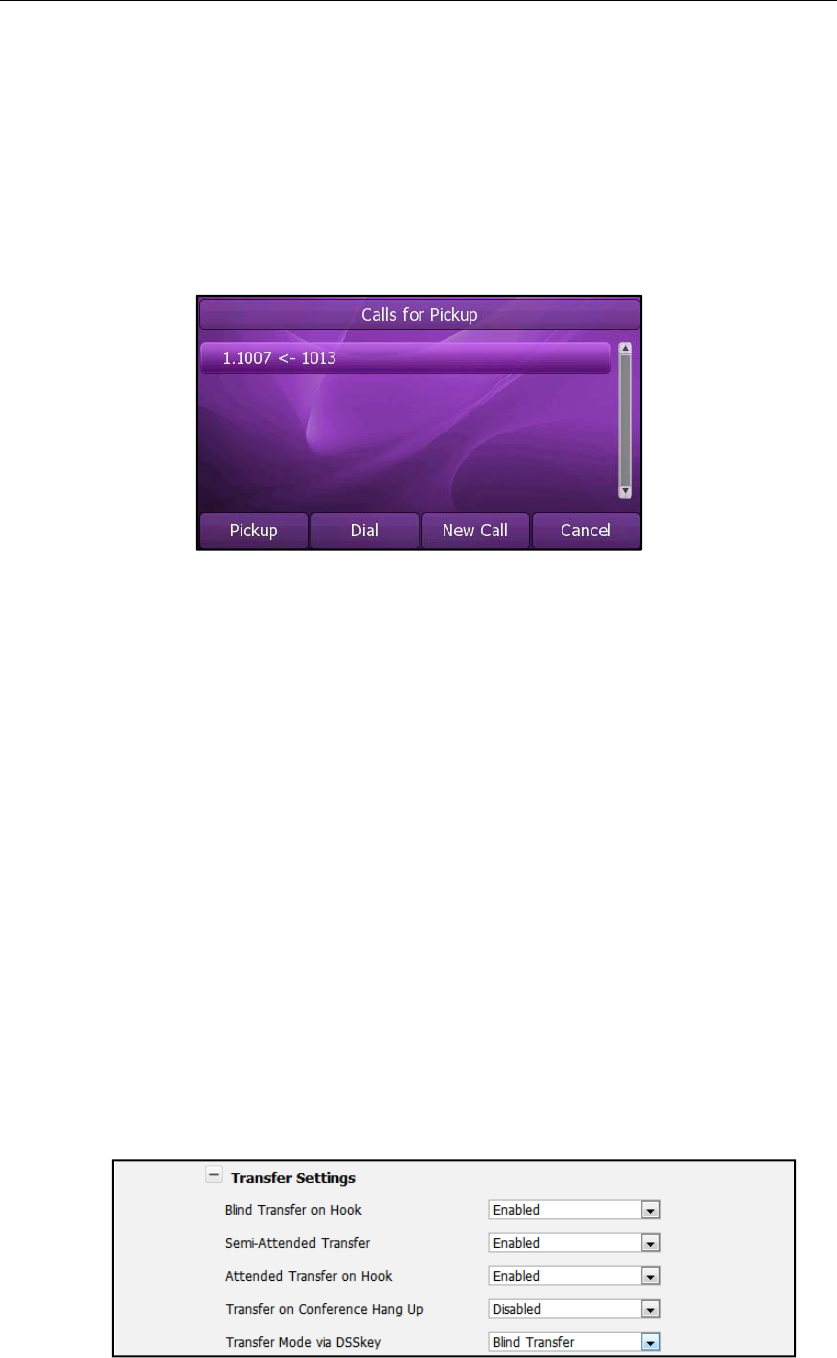
User Guide SIP-T46G IP Phone
94
When the monitored phone is ringing, the following occurs on the monitoring phone:
z The phone plays a warning tone (if enabled).
z The BLF key LED flashes.
z The caller ID appears on the LCD screen (if enabled).
In the following figure, the phone LCD screen shows an incoming call from 1013 on the
monitored user.
When there is a conversation on the IP phone, you can handle the active call
differently depending on the transfer mode on DSS key.
To configure the transfer mode on DSS key via web user interface:
1. Click on Phone->Features.
2. Click the “+” sign on the left of the Transfer Settings to expand the feature list.
3. Select the desired transfer mode from the pull-down list of Transfer Mode via DSS
key. Depending on your selection:
- If you select Blind Transfer, press the BLF key to complete the blind transfer to the
monitored phone number.
- If you select Attended Transfer, press the BLF key to dial out the monitored phone
number and then you can complete the attended or semi-attended transfer.
- If you select New Call, press the BLF key, the monitored phone number displays on
the LCD screen and then you can complete the blind, attended or semi-attended
transfer.
For more information on performing call transfer, refer to Call Transfer on page 81.
4. Click Confirm to accept the change.

Advanced Phone Features
95
BLF List
You can use the BLF List feature to monitor a list of users defined by your system
administrator. For example, your system administrator enables BLF List, and creates a
BLF List URI (e.g., BLFList@example.com) including a list of user1, user2 and user3 on the
server. The BLF List keys on the IP phone can present the status of user1, user2 and user3.
The key LEDs illuminate either flashing or solid depending on the status of those users. For
more BLF List key LED indications, refer to LED Instructions on page 5.
You can use the BLF List keys in the following ways:
z When the monitored user is idle, press the BLF List key to dial out the phone number.
z When the monitored user receives an incoming call, press the BLF List key to pick up
the call directly.
z When there is a conversation on the monitored user, press the BLF List key to barge
in and set up a conference call.
To configure the BLF List settings via web user interface:
1. Click on Account.
2. Select the desired account from the Account field.
3. Click on Advanced.
4. Enter the BLF List URI in the BLF List URI field.
5. (Optional.) Enter the BLF pickup code in the BLF List Pickup Code field.
6. Click Confirm to accept the change.
Note
To assign BLF List keys via phone user interface:
1. Press Menu->Features->DSS Keys.
2. Select the desired DSS key.
3. Press or , or the Switch soft key to select BLF List from the Type field.
For more information about the BLF List pickup, contact you
r
system administrato
r
.
You can configure the BLF List settings via web user interface only.
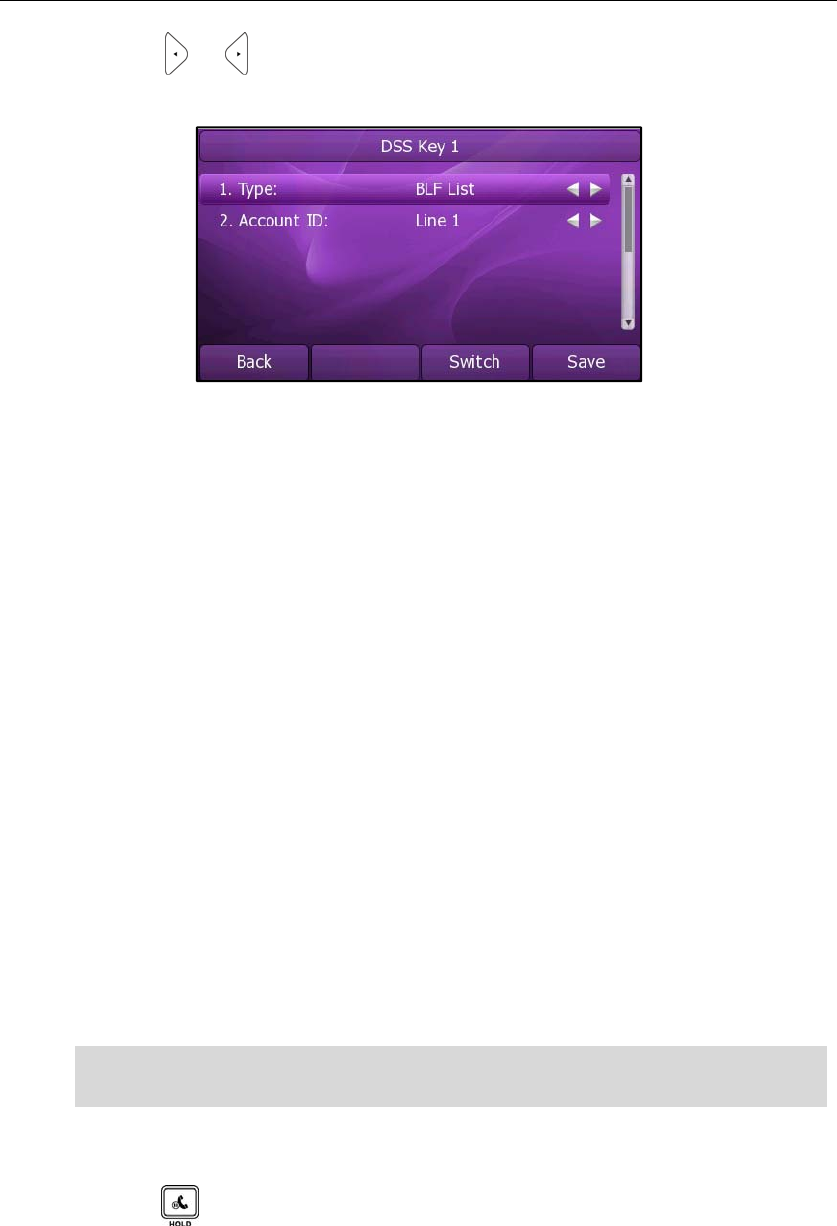
User Guide SIP-T46G IP Phone
96
4. Press or , or the Switch soft key to select the desired line from the Account
ID field.
5. Press the Save soft key to accept the change.
6. Repeat steps 2 to 5 to configure more BLF List keys.
You can also configure the BLF List key via web user interface at the path DSS Key.
After the above configurations, according to the response message from the BLF List
server, the IP phone will automatically assign the phone number of the BLF List users to
the BLF List keys in order.
Shared Line
Shared line is configured by assigning the same extension number to multiple lines. You
can use the shared line feature to share an extension number which is used on two or
more IP phones at the same time. An incoming call to that number will cause all phones
to ring simultaneously. The incoming call can be answered on one of the phones but
not all of them. This feature is very useful in the boss and secretary scenario. For
example, the secretary can share the boss' extension number on her phone. When
there is an incoming call to the extension number of the boss, both the phones of the
boss and the secretary will ring simultaneously. Either the boss or the secretary can
answer the call. Calls on shared line can be placed on hold or barged in.
Note
To place a call on public hold:
1. Press , the shared line key or the Hold soft key when there is an active call on
the shared line.
To retrieve a call placed on public hold:
1. Press the shared line key on any phone when there is a public held call on the
shared line.
The shared Line feature is not available on all servers. For more information, contact your
system administrator.
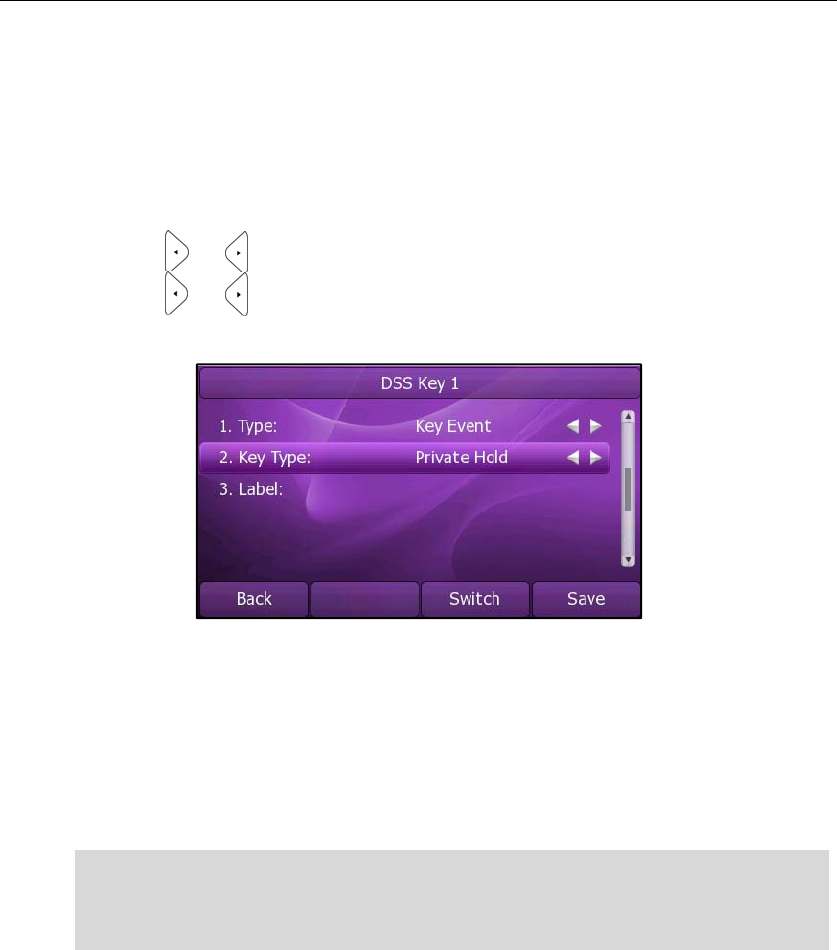
Advanced Phone Features
97
The shared line key LED illuminates flashing when the shared line call is placed on public
hold. For more Shared Line key LED indications, refer to LED Instructions on page 5.
To place the call on private hold, you should configure a private hold key in advance:
1. Press Menu->Features->DSS Keys.
2. Select the desired DSS key.
3. Press or , or the Switch soft key to select Key Event from the Type field.
4. Press or , or the Switch soft key to select Private Hold from the Key Type
field.
5. Press the Save soft key to accept the change.
You can also configure a private hold key via web user interface at the path DSS Key.
To place a call on private hold:
1. Press the private hold key when there is an active call on the shared line.
Note
To barge in a shared line call:
1. Press the shared line key on any other phone when there is an active call on the
shared line.
For more shared line key LED instructions, refer to LED Instructions on page 5.
Call Recording
You can record calls by pressing a record key on the SIP-T46G IP phone. There are 2
different ways of configuring call recording and they even work differently:
z Record: The phone sends SIP INFO message containing a specific header to trigger
a recording.
The private held call can be only retrieved by the hold party.
If the call is placed on private hold, and you attempt to pick up the call by pressing the
shared line key, the retrieve will fail and the LCD screen will prompt “Forbidden”.
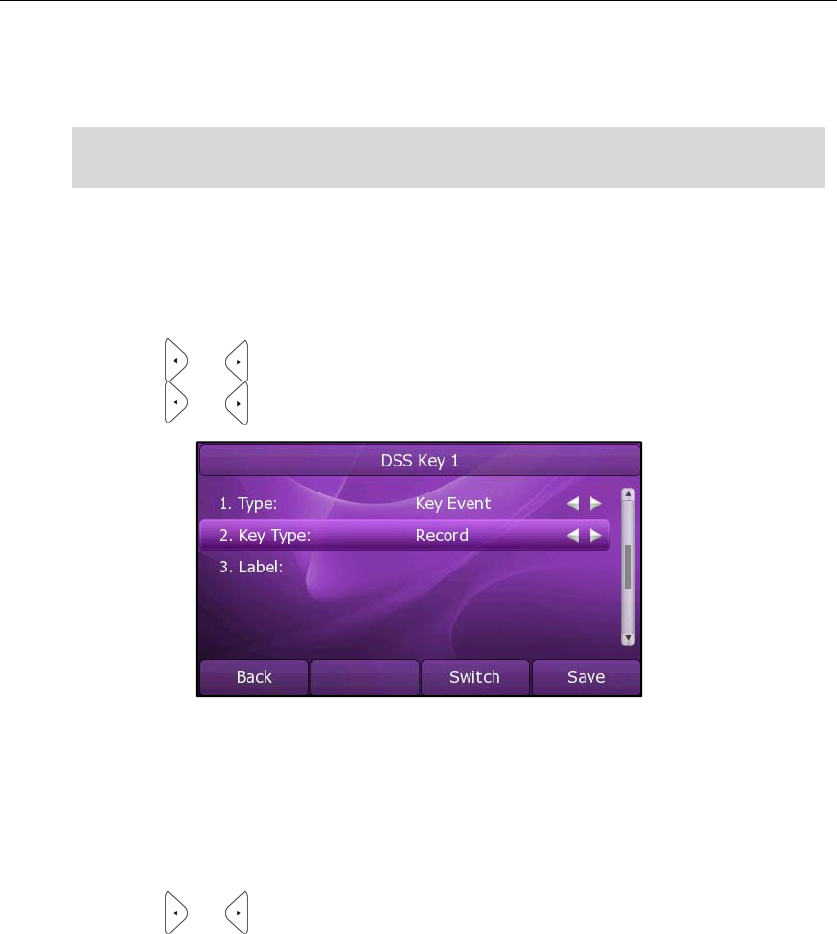
User Guide SIP-T46G IP Phone
98
z URL Record: The phone sends HTTP URL request to trigger a recording. Contact your
system administrator for the predefined URL.
Note
To configure a Record key via phone user interface:
1. Press Menu->Features->DSS Keys.
2. Select the desired DSS key.
3. Press or , or the Switch soft key to select Key Event from the Type field.
4. Press or , or the Switch soft key to select Record from the Key Type field.
5. Press the Save soft key to accept the change or the Back soft key to cancel.
To configure a URL Record key via phone user interface:
1. Press Menu->Features->DSS Keys.
2. Select the desired DSS key.
3. Press or , or the Switch soft key to select URL Record from the Type field.
4. Enter the URL (e.g. http://10.1.2.224/phonerecording.cgi)in the URL Record filed.
5. Press the Save soft key to accept the change or the Back soft key to cancel.
You can also configure the Record or URL Record keys via web user interface at the
path DSS Key.
The Record/URL Record keys control the recording and are available:
z During an active call
z When calls are on hold or mute
z During a blind or attended transfer
z During a conference call
z When the phone prompts you to answer an incoming call
The Record/ URL Record keys are not available:
z When there are no connected calls on your phone
The record feature is not available on all servers. Contact your system administrator for
more information.
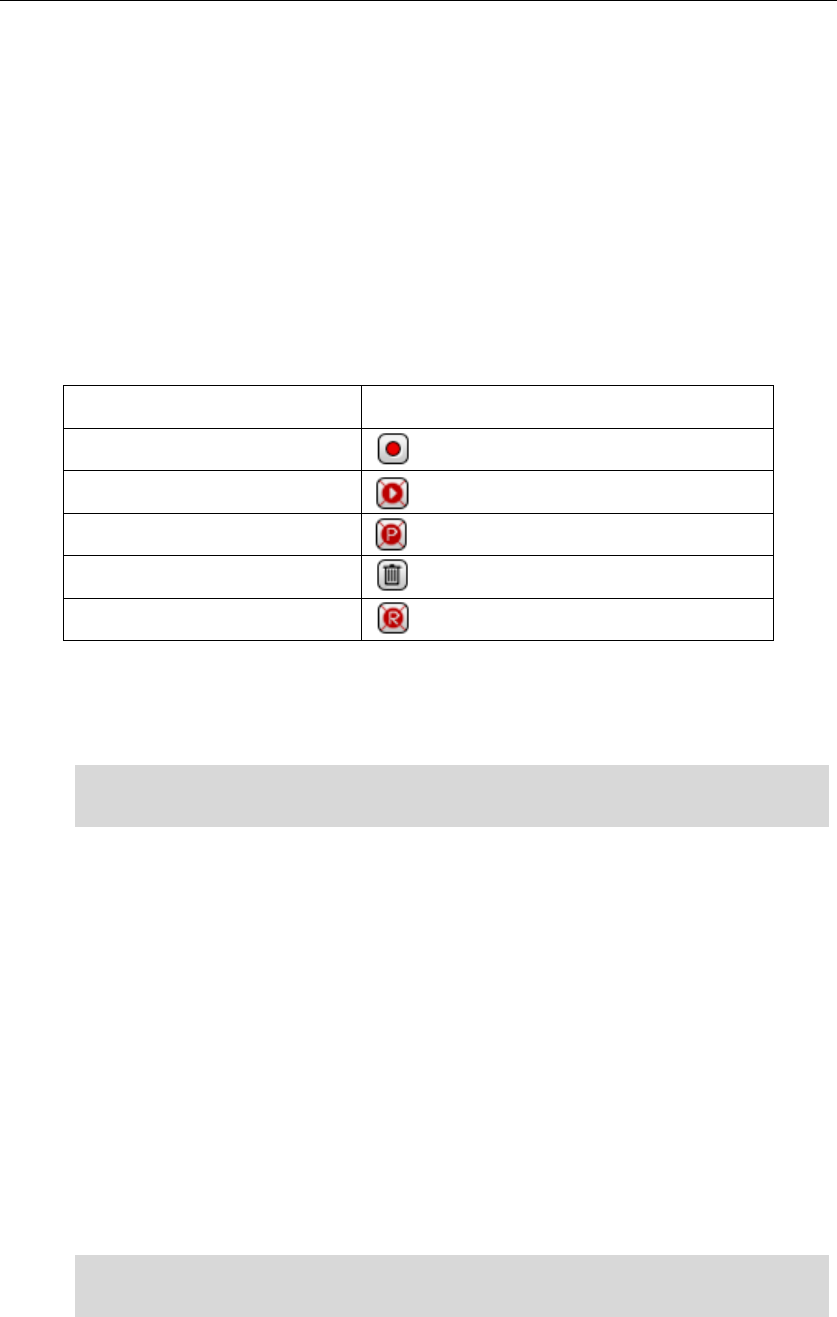
Advanced Phone Features
99
z When you place a new call
To record a call:
1. Press a Record or URL Record key during a call.
If the recording starts successfully, there cording icon appears on the LCD screen
and the Record or URL Record key LED flashes green.
2. Press the Record or URL Record key again to stop recording.
The recording icon disappears from the LCD screen and the Record or URL Record
key LED turns off.
Recording status indications you need to know:
Circumstance Icons on the LCD screen
A recording is started appears on the LCD screen
A recording cannot be started appears for 1 second
A recording cannot be
td
appears for 1 second, then goes back
The recording box is full appears for 1 second
The cannot be recorded appears for 1 second
You can listen to the recordings stored on your server system. For example, you can dial
an access code to listen to the recordings.
Note
Hot Desking
Hot Desking originates from the definition of being the temporary physical occupant of
a work station or surface by a particular employee. A primary motivation for Hot
Desking is cost reduction. This feature is regularly used in places where not all the
employees are in the office at the same time, or not in the office for very long at all,
which means actual personal offices would be often vacant, consuming valuable
space and resources.
You can use Hot Desking on the SIP-T46G IP phone to log out the existing accounts and
then log in a new account, that is, many users can share the phone resource in
different time. To use this feature, you need to configure a Hot Desking key in advance.
Note
The hot desking feature is not available on all servers. Contact your system administrator
for more information.
The way listening to the recordings may be different on different servers. Contact your
system administrator for more information.
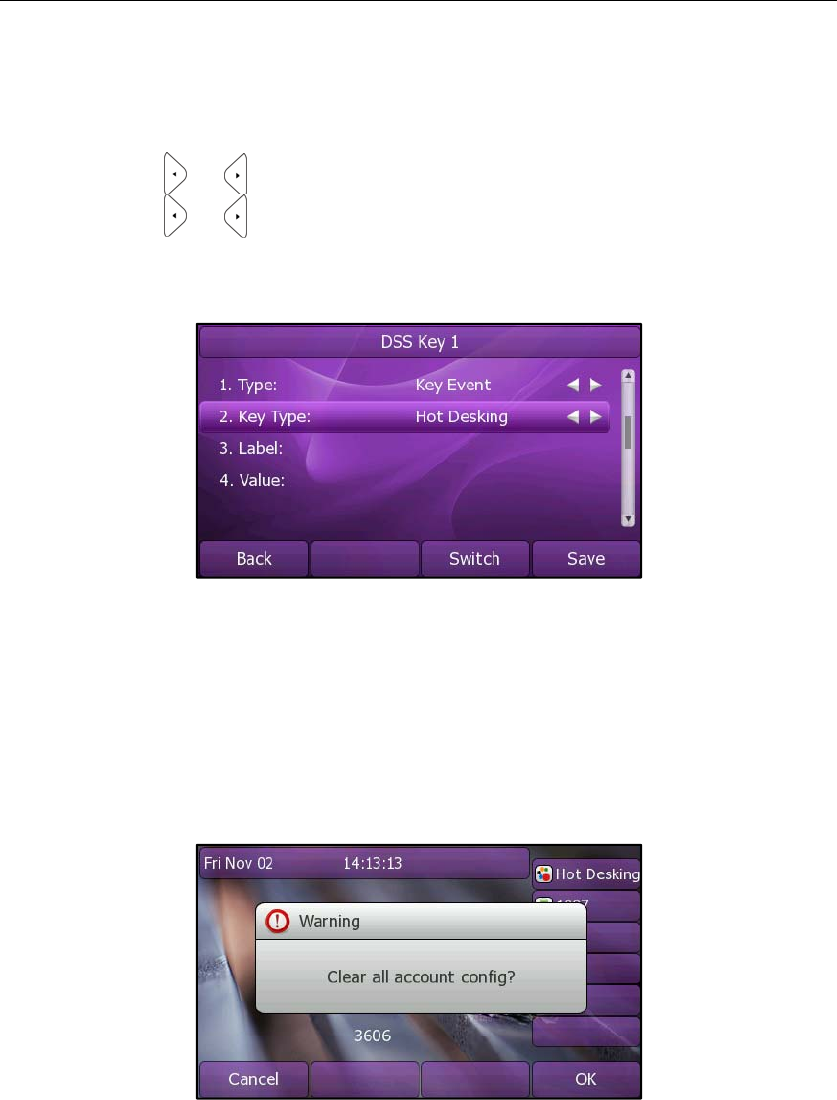
User Guide SIP-T46G IP Phone
100
To configure a hot desking key via phone user interface:
1. Press Menu->Features->DSS Keys.
2. Select the desired DSS key.
3. Press or , or the Switch soft key to select Key Event from the Type field.
4. Press or , or the Switch soft key to select Hot Desking from the Key Type
field.
5. Leave the Value field blank.
6. Press the Save soft key to accept the change or the Back soft key to cancel.
You can also configure a hot desking key via web user interface at the path DSS Key.
To use hot desking:
1. Press the hot desking key when the phone is idle.
The phone prompts the following warning:
2. Press the OK soft key, all currently configured accounts will be unregistered
immediately and their configuration data will be removed from the phone.
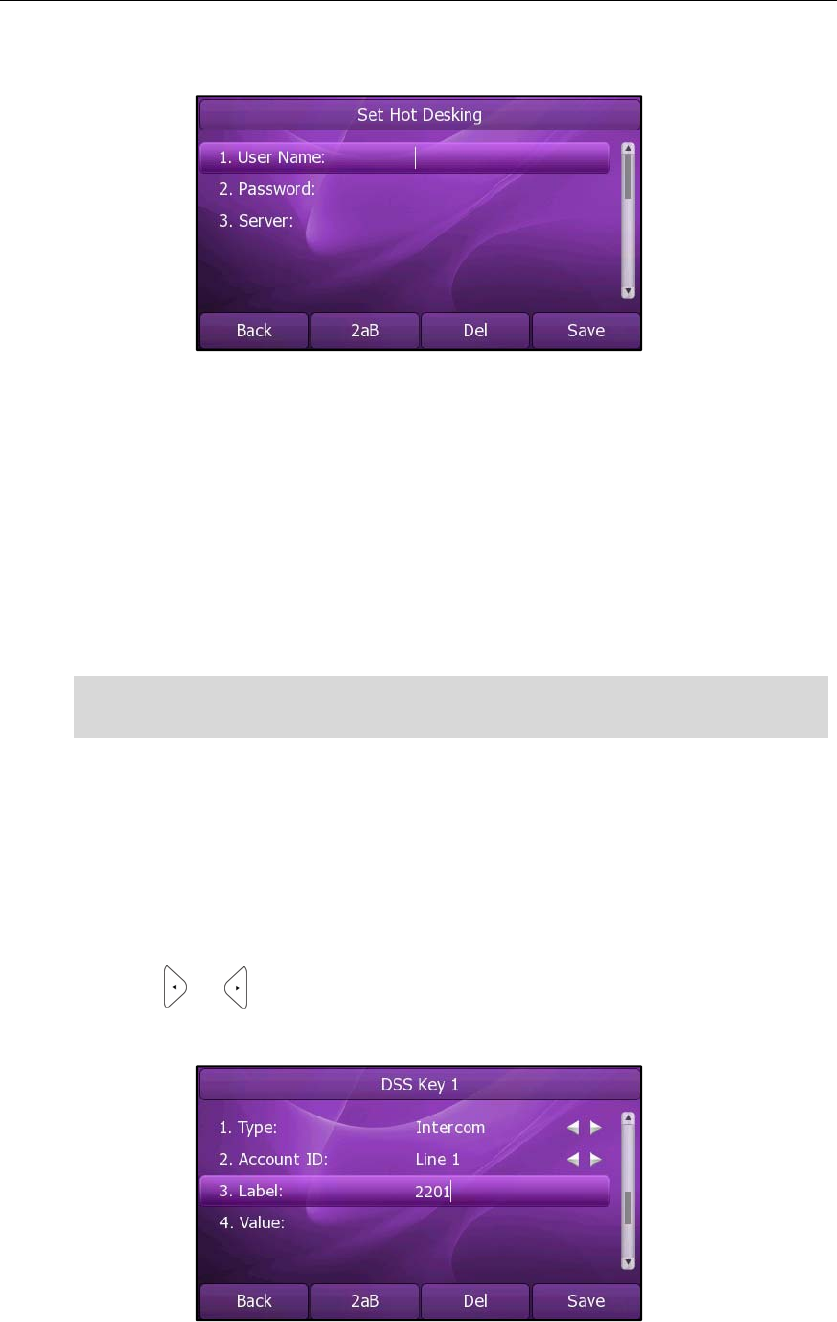
Advanced Phone Features
101
The login wizard will be shown as below:
3. Enter the Login information in each filed.
Intercom
Intercom is a useful feature in an office environment to quickly connect with the
operator or the secretary. You can press the configured intercom key to automatically
connect with a remote extension for outgoing intercom calls, and the remote extension
will automatically answer the incoming intercom calls.
Note
Outgoing Intercom Calls
To configure an intercom key via phone user interface:
1. Press Menu->Features->DSS Keys.
2. Select the desired DSS key.
3. Press or , or the Switch soft key to select Intercom from the Type field.
4. Select the desired line from the Account ID field.
5. Enter the remote extension number in the Value field.
6. Press the Save soft key to accept the change or the Back soft key to cancel.
The intercom feature is not available on all servers. Contact your system administrator for
more information.
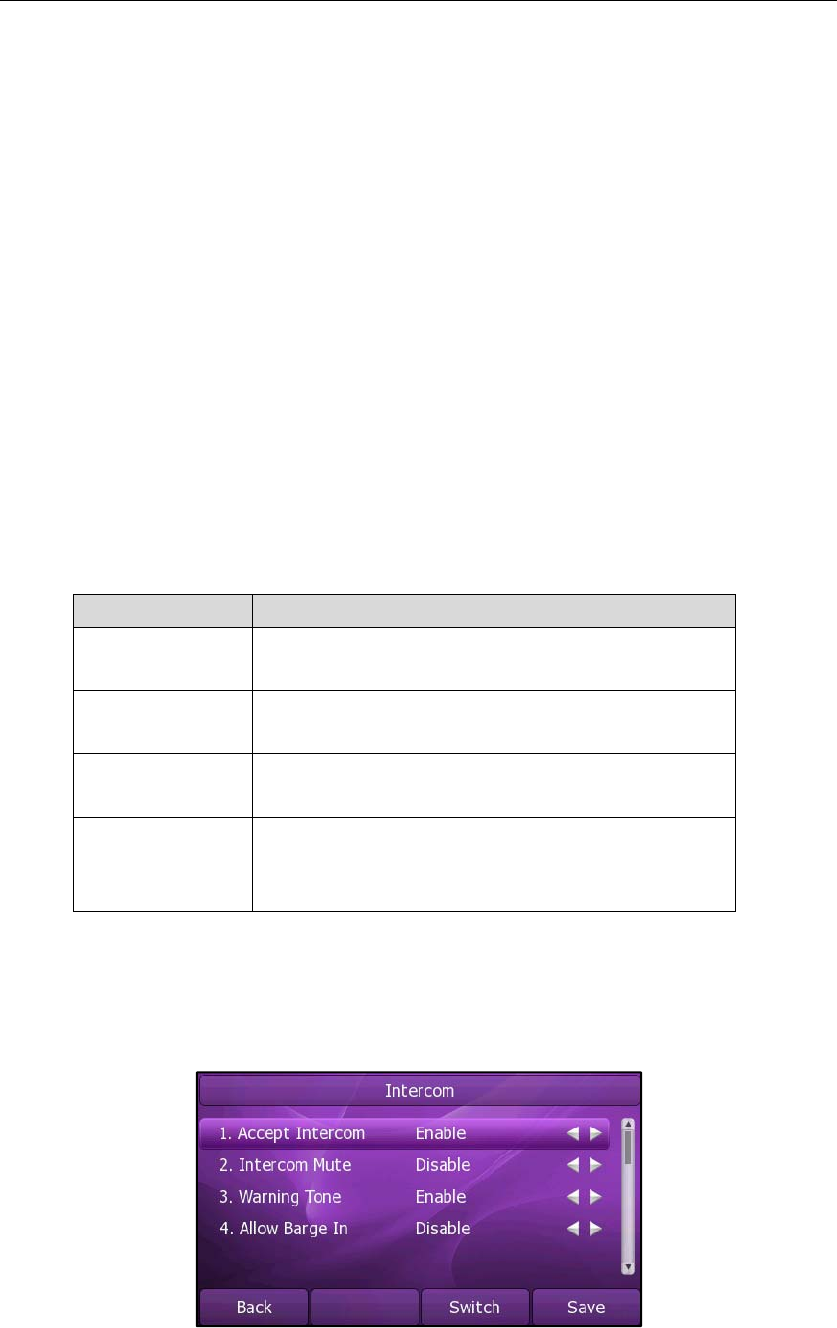
User Guide SIP-T46G IP Phone
102
You can also configure an intercom key via web user interface at the path DSS Key.
To place an intercom call:
1. Press the intercom key when the phone is idle.
The phone is automatically connected to the extension specified in the Value field.
2. Press the intercom key again or the Cancel soft key to end the intercom call.
Incoming Intercom Calls
By default, the SIP-T46G IP phone supports to answer an incoming intercom call
automatically. The phone automatically plays a warning tone when it receives an
incoming intercom call. In addition, you can enable the phone to mute the
microphone when it automatically answers an incoming intercom call. You can also
enable the phone to automatically answer an incoming intercom call while there is
already an active call on the phone, the active call is placed on hold.
Intercom features you need to know:
Intercom features Description
Accept Intercom Allows you to enable or disable the IP phone to
automatically answer an incoming intercom call.
Intercom Mute Allows you to enable or disable the microphone on
the IP phone for Intercom calls.
Warning Tone Allows you to enable or disable a warning tone when
the phone receives an incoming intercom call.
Allow Barge In
Allows you to enable or disable the IP phone to
automatically answer an incoming intercom call
while there is already an active call on the phone.
To configure intercom features via phone user interface:
1. Press Menu->Features->Intercom.
2. Make the desired changes.
3. Press the Save soft key to accept the change or the Back soft key to cancel.
You can also configure these specific parameters via web user interface at the path

Advanced Phone Features
103
Phone->Features->Intercom Settings.
Accept Intercom
You can enable or disable the phone to automatically answer an incoming intercom
call. If Accept Intercom is enabled, the phone automatically answers an incoming
intercom call. If Accept Intercom is disabled, the phone rejects incoming intercom calls
and sends a busy signal to the caller. Accept Intercom is enabled by default.
Note
Intercom Mute
You can mute or un-mute the microphone on the phone for intercom calls
automatically. If Intercom Mute is enabled, the microphone is muted for intercom calls.
If Intercom Mute is disabled, the microphone is un-muted for incoming calls. Intercom
Mute is disabled by default.
Warning Tone
You can enable or disable the phone to play a warning tone when receiving an
intercom call. If Warning Tone is enabled, the phone plays a warning tone to alert you
before answering the intercom call. If Warning Tone is disabled, the phone
automatically answers the intercom call without warning. Warning Tone is enabled by
default.
Allow Barge In
You can enable or disable the phone to automatically answer an incoming intercom
call while there is already an active call on the phone. If Allow Barge In is enabled, the
phone automatically answers the intercom call and places the active call on hold. If
Allow Barge In is disabled, the phone handles an incoming intercom call like a waiting
call. Allow Barge In is disabled by default.
Automatic Call Distribution (ACD)
ACD feature is often used in offices for customer service, such as call center. The ACD
system handles large volumes of incoming calls from callers who have no need to talk
to a specific person but who require assistance from any of multiple persons at the
earliest opportunity. The ACD feature on the SIP-T46G IP phone allows the ACD system
to distribute calls from large volumes of incoming calls to the registered IP phone users.
To use this feature, you should configure an ACD key in advance.
To configure an ACD key via phone user interface:
1. Press Menu->Features->DSS Keys.
2. Select the desired DSS key.
Your administrator can set a time period delay before the phone automatically answers.
Contact your system administrator for more information.
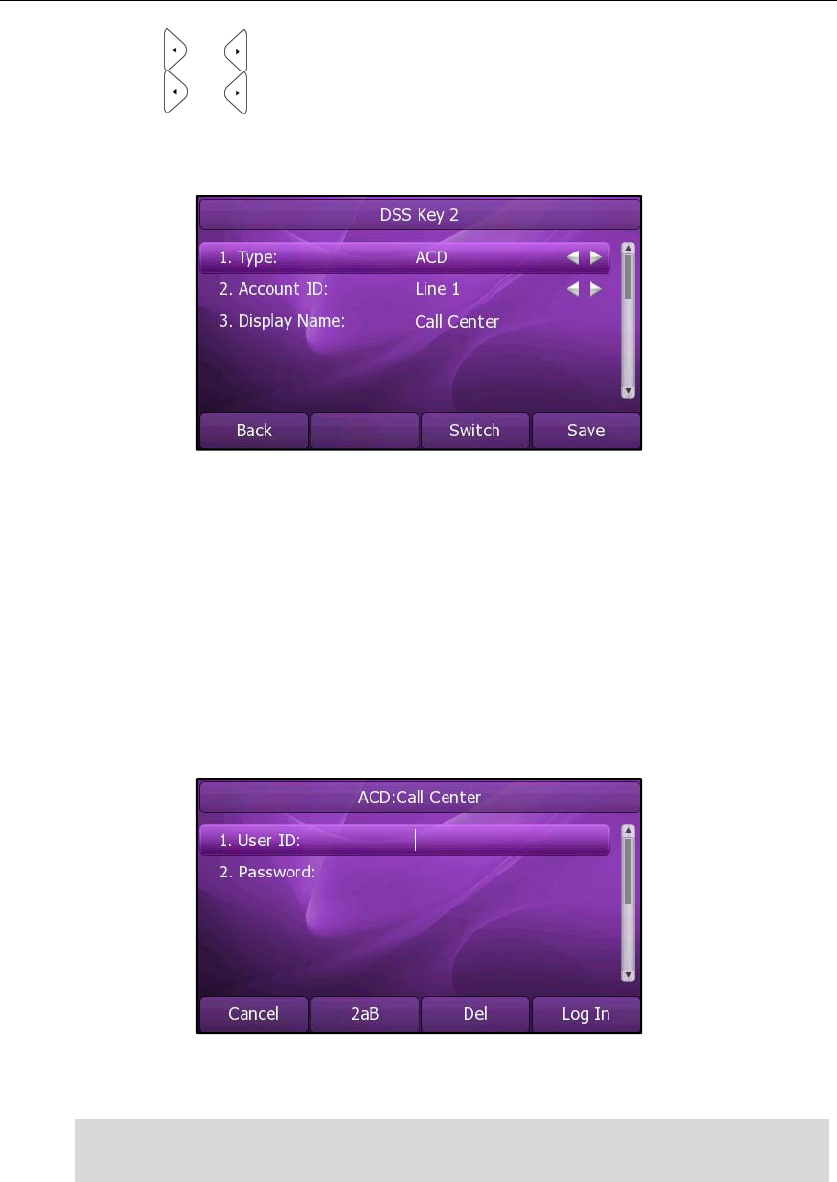
User Guide SIP-T46G IP Phone
104
3. Press or , or the Switch soft key to select ACD from the Type field.
4. Press or , or the Switch soft key to select the desired line from the Account
ID field.
5. (Optional.) Enter the ACD name in the Display Name field.
6. Press the Save soft key to accept the change or the Back soft key to cancel.
You can also configure an ACD key via web user interface at the path DSS Key.
To use the ACD feature:
1. Press the ACD key when the phone is idle.
The phone LCD screen prompts you the following information:
User ID: the phone number used to log in the queue.
Password: the password used to log in the queue.
2. Press the Log In soft key to login.
Note
After configuring an ACD key, you can press the ACD key to log in the ACD system. After
logging in, you are ready to receive calls from the ACD system. You can press the ACD
key to show your current phone status. You can press the Available/Unavailable soft
key to change your phone status. The system server monitors your phone status. When
you set the phone status to available, the ACD key LED illuminates solid green, and then
the server begins distributing calls to your phone. When you set the phone to
Contact your system administrator for the User ID and Password to access the ACD
system.
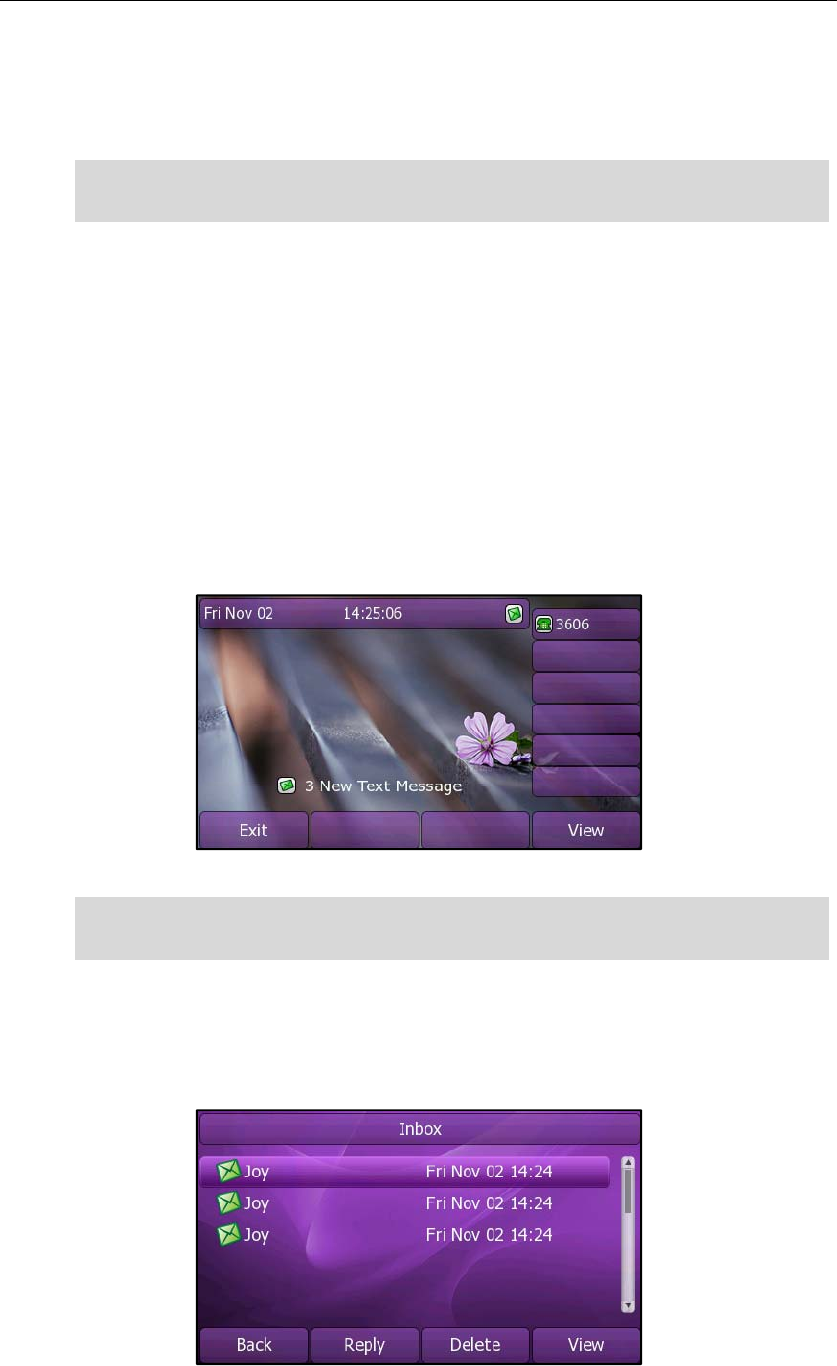
Advanced Phone Features
105
unavailable, the ACD key LED illuminates flashing green, and then the server
temporarily stops distributing calls to your phone. To logout the ACD system, press the
Log Out soft key.
Note
Messages
Short Message Service (SMS)
You can send and receive text messages using the SIP-T46G IP phone. New text
messages can be indicated both acoustically and visually. When receiving a new text
message, the phone LCD screen will prompt receiving new text messages with the
number of waiting messages (example: 3 New Text Message) and a flashing icon.
Note
To read a text message:
1. Press Menu->Messages->Text Message->Inbox.
It is recommended you configure no more than one ACD key per phone. At any time, at
most one ACD key can be in progress on your phone.
The SMS feature is not available on all servers. Contact your system administrator for
more information.
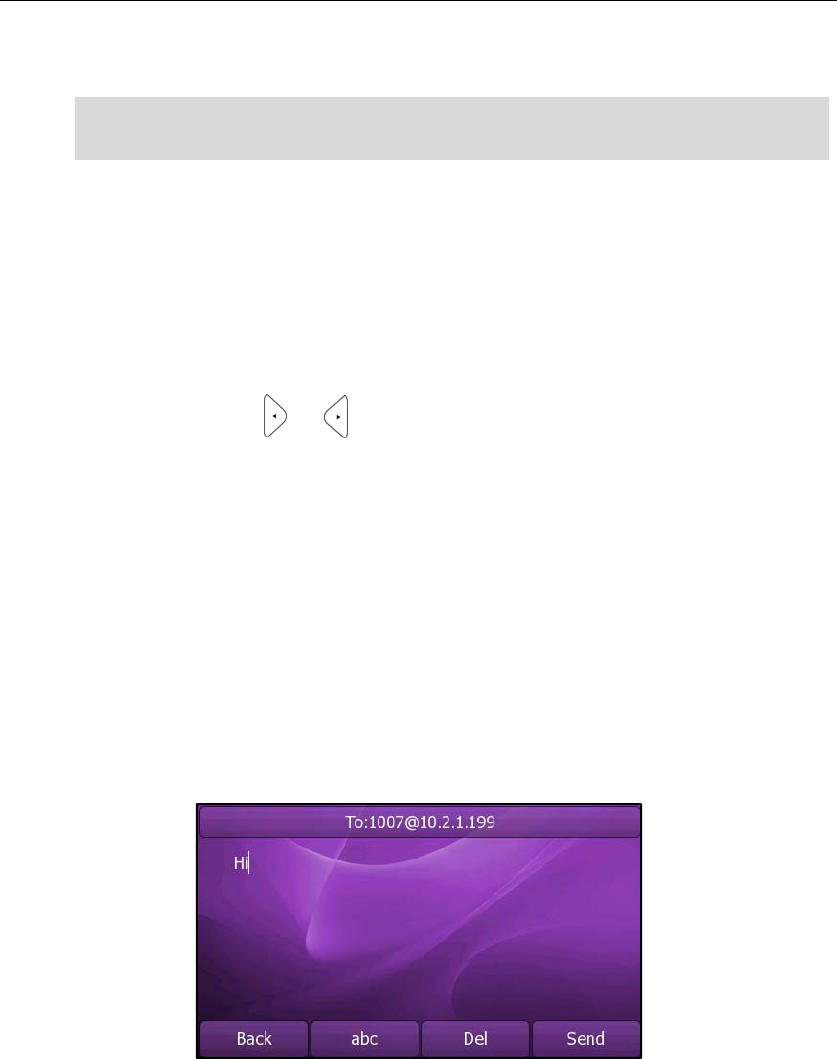
User Guide SIP-T46G IP Phone
106
2. Select the desired message and press the View soft key.
Note
To send a text message:
1. Press Menu->Messages->Text Message->New Message.
2. Compose the new text message. You can press the abc soft key to change the
input mode.
3. Press the Send soft key.
4. (Optional.) Press or , or the Switch soft key to select the desired account
from the From field.
5. Enter the number you want to send the message to in the To field.
6. Press the Send soft key to send the message or the Back soft key to cancel.
You can also send a text message via web user interface at the path Phone->SMS.
To reply a text message:
1. Press Menu->Messages->Text Message->Inbox.
2. Select the desired message and press the Reply soft key.
3. Compose the new text message. You can press the abc soft key to change the
input mode.
4. Press the Send soft key after completing the content.
To delete a text message:
1. Press Menu->Messages->Text Message->Inbox (Sentbox, Outbox or Draftbox).
If the phone prompts receiving new text messages, you can also read the new
messages directly.
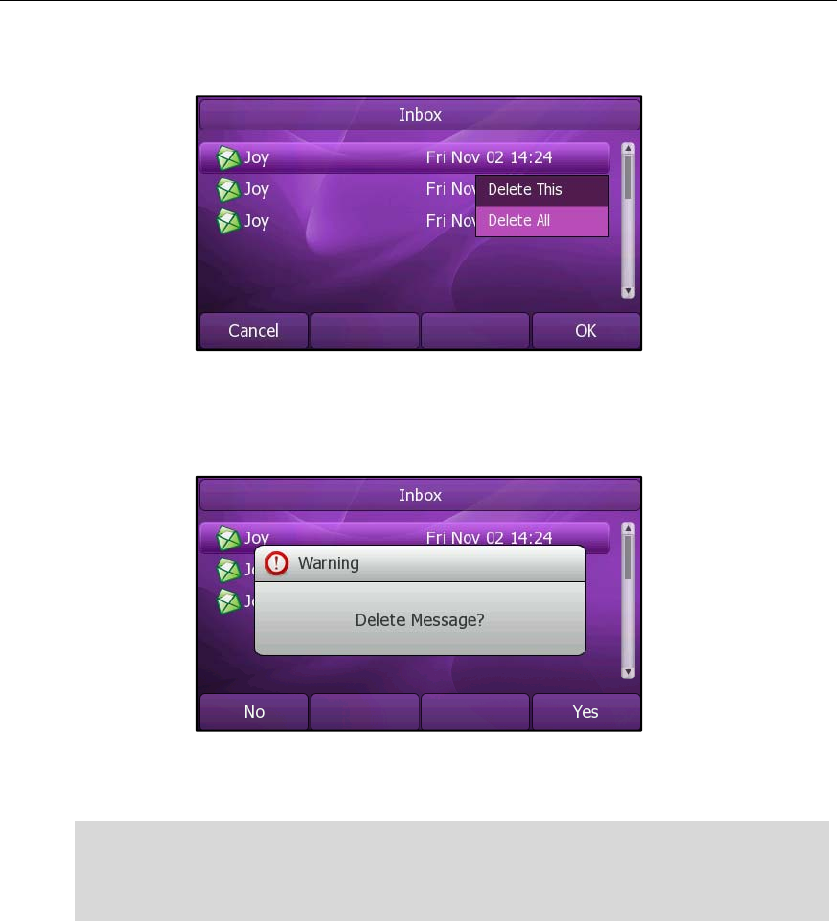
Advanced Phone Features
107
2. Select the desired message and then press the Delete soft key.
3. Select Delete This to delete the desired message.
The LCD screen prompts "Delete Message?".
4. Press the Yes soft key to delete this message or the No soft key to cancel.
Note
Voice Mail
You can leave voice mails for someone else on the SIP-T46G IP phone. You can also
listen to the voice mails stored in a centralized location. When receiving a new voice
mail, the phone will play a warning tone and the MESSAGE key LED will illuminate.
You can also delete all text messages by pressing the Delete soft key and then select
Delete All. You can refer to the above steps.
You can also delete a specific message after retrieving by pressing the Delete soft key.
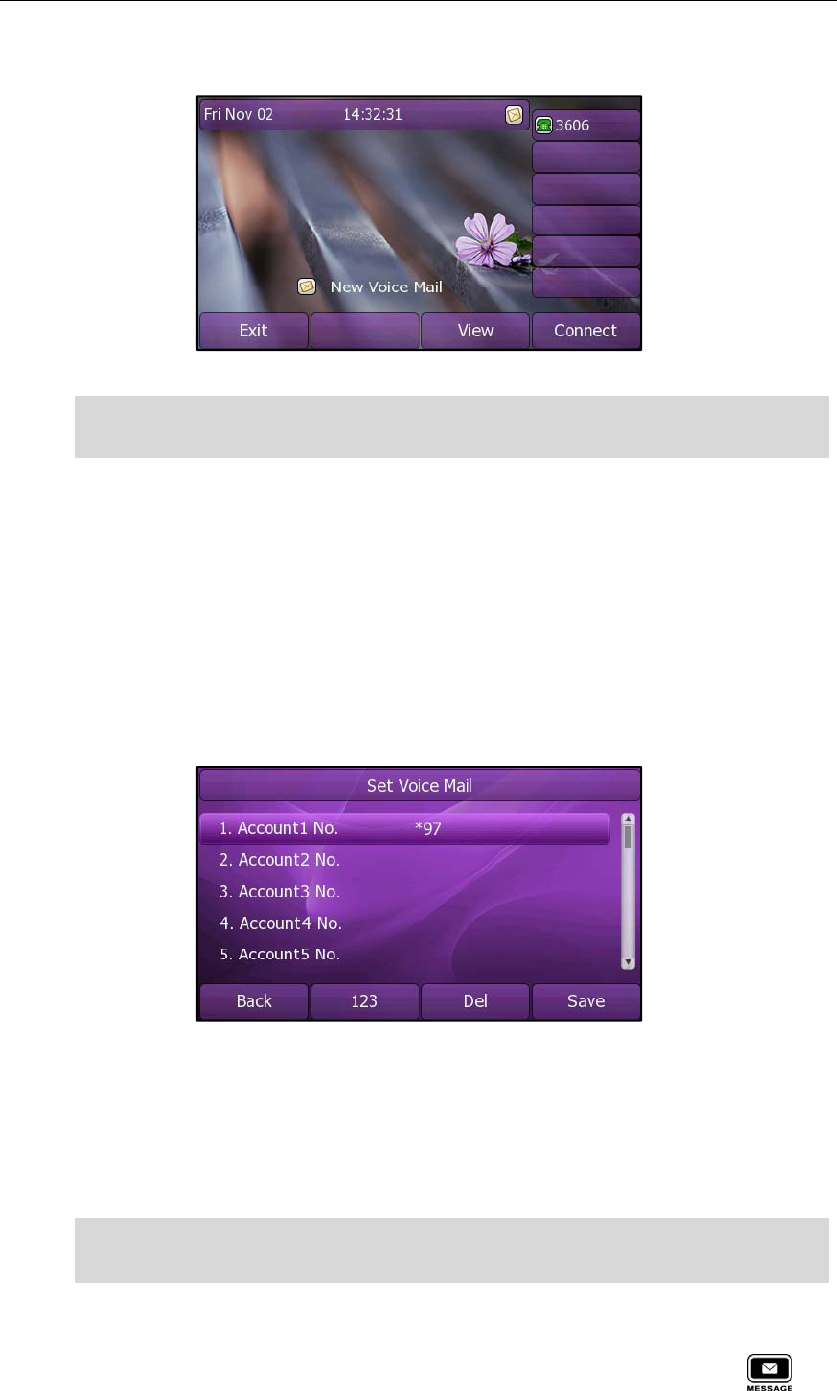
User Guide SIP-T46G IP Phone
108
The phone LCD screen will prompt receiving a new voice mail and a flashing icon.
Note
To leave a voice mail:
You can leave a voice mail for someone else when he/she is busy or inconvenient to
answer the call. Follow the voice prompt from the system server to leave the voice mail,
and then hang up after completing the voice mail.
To configure voice mail access codes via phone user interface:
1. Press Menu->Messages->Voice Mail->Set Voice Mail.
2. Press the navigation keys to highlight the account which you want to set.
3. Press the 123 soft key to select the proper input mode and then enter the voice
mail access code (e.g. *97).
4. Press the Save soft key to accept the change or the Back soft key to cancel.
Note
To listen to the voice mails:
1. When the phone user interface prompts receiving new voice mails, press or
the Connect soft key to dial out the access voice mail code.
Voice Mail feature is not available on all servers, contact your system administrator for
more information.
Voice mail access code must be predefined on the system server. Contact your system
administrator for the more information.
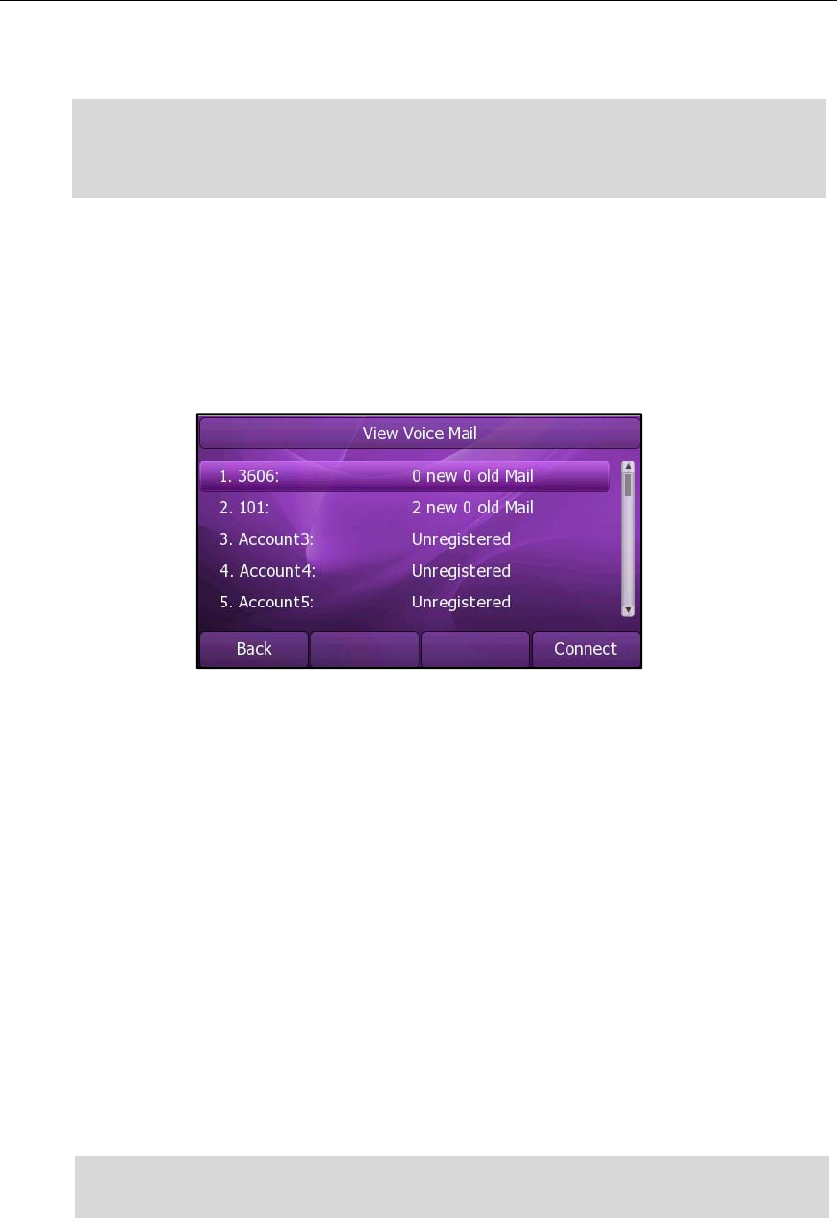
Advanced Phone Features
109
2. Follow the voice prompt to listen to the voice mails.
Note
To view the voicemail via phone user interface:
1. Press Menu->Messages->Voice Mail->View Voice Mail.
The phone LCD screen displays the amount of the voice mails that includes new or
old voice mails.
2. Select an account and then press the Connect soft key to listen to the voice mails.
Message Waiting Indicator (MWI)
The SIP-T46G IP phone supports MWI feature when receiving a new voice message. If
someone leaves you a voicemail, you will receive a message waiting indicator. MWI will
be indicated in three ways: a warning tone, the MESSAGE key LED illuminates solid
green and an indicator message (including a voice mail icon) appears on the LCD
screen. This is cleared only when you retrieve all voicemails or delete them.
For some particular servers, the MWI service is unsolicited. So the SIP-T46G IP phone just
need to handle the MWI messages sent from the server. But for some servers, the MWI
service is solicited. In this case, the SIP-T46G IP phone must enable the MWI Subscription
for MWI messages.
Note
MWI service is not available on all servers. Contact your system administrator for more
information.
Before listening to the voicemails, make sure the voice mail access code has been
configured.
When all new voice mails are retrieved, the MESSAGE key LED will turn off.

User Guide SIP-T46G IP Phone
110
The MWI Subscription parameters you need to know:
Options Description
Subscribe for MWI Enable or disable a subscription for MWI service.
MWI Subscription Period Period of MWI subscription. The IP phone re-sends a
MWI subscription before expiring.
To enable MWI subscription via web user interface:
1. Click on Account->Advanced.
2. Select Enabled from the pull-down list of Subscribe for MWI.
3. Enter the period time (in seconds) in the MWI Subscription Period (Scope: 0~84600)
(seconds) field.
4. Click Confirm to accept the change.

User Guide SIP-T46G IP Phone
112
Troubleshooting
This chapter provides general troubleshooting information to help you solve the
problems you might encounter when using your SIP-T46G IP phone.
If you require additional information or assistance with your new phone, contact your
system administrator.
Why is the phone LCD screen blank?
z Ensure your phone is properly plugged into a functional AC outlet.
z Ensure that the phone isn’t plugged into a plug controlled by a switch that is off.
z If the phone is plugged into a power strip, try plugging it directly into a wall outlet
instead.
z If your phone is powered from PoE, ensure you use a PoE compliant switch or hub,
or contact your system administrator for more information.
Why does the phone display "Network Unavailable"?
z Ensure that the Ethernet cable is plugged into the Internet port on the phone and
the Ethernet cable is not loose.
z Ensure that the switch or hub in your network is operational.
z Contact your system administrator for more information.
Why does the phone display "No Service"?
The phone LCD screen prompts "No Service" message when the SIP accounts do not
register successfully. Contact your system administrator for more information on
account settings.
Why can’t I get a dial tone?
Check for any loose connections and that the phone has been installed properly. For
the installation instructions, refer to Phone Installation on page 13.
Check whether dial tone is present on one of the audio modes.
z Switch between the Handset, Headset (if present) or Hands-Free Speakerphone to
check whether dial tone is present for one of the audio modes.
z If the dial tone exists on another audio mode, connect a different handset or
headset to isolate the problem.

Troubleshooting
113
Why doesn’t the phone ring?
Check the ringer volume on your phone. To adjust the ringer volume setting, press the
Volume key when the phone is on-hook and idle. For more information, refer to Volume
on page 34.
Why can’t I receive calls?
z Check the SIP registration with your system administrator.
z Check DND (Do Not Disturb) mode is turned off on your phone. Refer to Do Not
Disturb (DND) on page 78.
z Check call forward feature is disabled on the phone. Refer to Call Forward on
page 79.
z Check whether the caller number is stored in the blacklist directory. Refer to
Blacklist on page 41.
Why is my handset not working?
Check to ensure that the handset cord is fully connected to both the handset jack on
the phone and handset. Refer to Phone Installation on page 13.
Why is my headset not working?
z Check to ensure that the headset cord is fully connected to the headset jack on
the phone. Refer to Phone Installation on page 13.
z Check to ensure that the headset mode is activated. Refer to Headset Use on
page 49.
z Check to ensure that the headset volume is adjusted to an appropriate level. Refer
to Volume on page 34.
How to change the user password?
You can change the user password via web user interface:
1. Click on Security->Password.
2. Enter the current user password in the Current Password field.
3. Enter the new user password in the New Password field and Confirm Password field.
4. Click Confirm to accept the change.
You can also contact your system administrator for help.
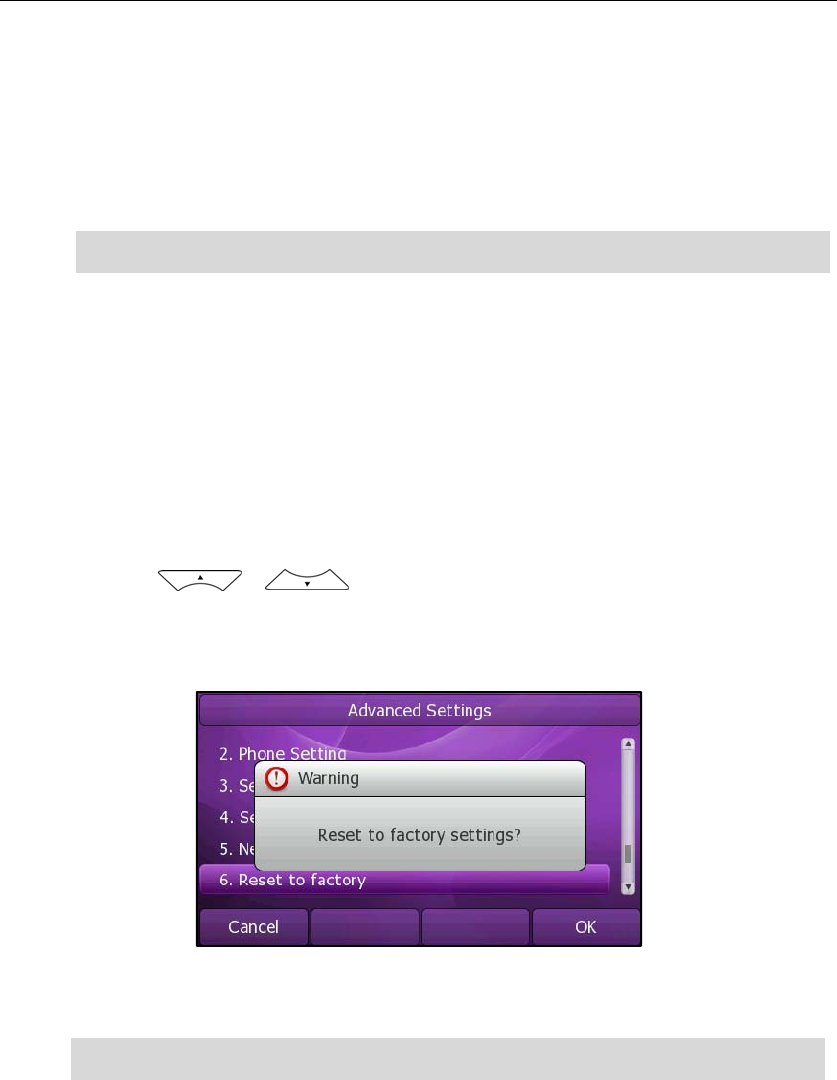
User Guide SIP-T46G IP Phone
114
How to reboot the phone?
To reboot the IP phone via web user interface:
1. Click on Phone->Upgrade.
2. Click Reboot to reboot the IP phone.
Note
How to reset your phone?
Reset your phone when other Troubleshooting suggestions do not correct the problem.
You need to note that all customized settings will be overwritten after resetting. We
recommend asking your system administrator for advice before resetting your phone.
To reset your phone via phone user interface:
1. Press Menu->Setting->Advanced Settings (password: admin).
2. Press or to scroll to Reset to factory, and then press the Enter soft
key.
The LCD screen prompts the following message:
3. Press the OK soft key.
Note
How to Export PCAP Trace?
We may need you to provide a PCAP Trace to help analyze your problem.
To export a PCAP Trace via web user interface:
1. Click on Phone->Upgrade.
2. Click Start to begin recording signal traffic.
3. Recreate the error to be documented in the trace.
4. Click Stop to end recording.
5. Click Export to open file download window, and then save the file to your local
Any reboot of your phone may take a few minutes.
Reset of your phone may take a few minutes.

Troubleshooting
115
system.
How to Export System Log?
We may need you to provide a System Log to help analyze your problem.
To export a System Log via web user interface:
1. Click on Phone->Configuration.
2. Select 6 from the pull-down list of Log Level.
3. Click Confirm to accept the change.
The web user interface prompts “Do you want to restart your machine?”.
4. Click OK to reboot the phone.
After rebooting the phone, you can export a 6 level system log through the
following steps.
5. Mark the Local radio box in the Export System Log field.
6. Click Export to open file download window, and then save the file to your local
system.
You can also export the system log to a Syslog Server, contact your system administrator
for more information.
How to Export/ Import phone configurations?
We may need you to provide your phone configurations to help analyze your problem.
In some instance, you may need to import configurations to your phone.
To export your phone configurations via web user interface:
1. Click on Phone->Configuration.
2. Click Export to open file download window, and then save the file to your local
system.
To Import phone configurations via web user interface:
1. Click on Phone->Configuration.
2. Click Browse to select a configuration file from your local system.
3. Click Import to import the configuration file.
Note
How to make the call using SRTP?
You can enable SRTP to encrypt the audio stream(s) of phone calls. The parties
participating in the call should enable SRTP. You can enable SRTP on per-account basis.
The file format of configuration file must be “.bin”.

User Guide SIP-T46G IP Phone
116
To enable SRTP via web user interface:
1. Click on Account.
2. Select the desired account from the pull-down list of Account.
3. Click on Advanced.
4. Mark the On radio box in the Voice Encryption (SRTP) field.
Note
The SRTP feature is not available on all servers. Contact your system administrator for
more information.

User Guide SIP-T46G IP Phone
118
Regulatory Notices
Service Agreements
Contact your reseller for information about service agreements applicable to your
product.
Limitations of Liability
TO THE FULL EXTENT ALLOWED BY LAW, YEALINK EXCLUDES FOR ITSELFAND ITS SUPPLIERS
ANY LIABILITY, WHETHER BASED IN CONTRACT OR TORT (INCLUDINGNEGLIGENCE), FOR
INCIDENTAL, CONSEQUENTIAL, INDIRECT, SPECIAL, OR PUNITIVE DAMAGES OFANY KIND,
OR FOR LOSS OF REVENUE OR PROFITS, LOSS OF BUSINESS, LOSS OF INFORMATION
ORDATA, OR OTHER FINANCIAL LOSS ARISING OUT OF OR IN CONNECTION WITH THE
SALE,INSTALLATION, MAINTENANCE, USE, PERFORMANCE, FAILURE, OR INTERRUPTION OF
ITS PRODUCTS,EVEN IF YEALINK OR ITS AUTHORIZED RESELLER HAS BEEN ADVISED OF THE
POSSIBILITY OF SUCHAMAGES, AND LIMITS ITS LIABILITY TO REPAIR, REPLACEMENT, OR
REFUND OF THE PURCHASERICE PAID, AT YEALINK’S OPTION. THIS DISCLAIMER OF
LIABILITY FOR DAMAGES WILL NOT BEAFFECTED IF ANY REMEDY PROVIDED HEREIN SHALL
FAIL OF ITS ESSENTIAL PURPOSE.
Safety Instructions
Save these instructions. Read these safety instructions before use!
The following basic safety precautions should always be followed to reduce risk of fire,
electrical shock, and other personal injury.
General Requirements
z Before you install and use the device, read the safety instructions carefully
and observe the situation during operation.
z During the process of storage, transportation, and operation, please always
keep the device dry and clean.
z During the process of storage, transportation, and operation, please avoid
collision and crash of the device.
z Please attempt not to dismantle the device by yourself. In case of any
discrepancy, please contact the appointed maintenance center for repair.
z Without prior written consent, no organization or individual is permitted to
make any change to the structure or the safety design of the device.
Yealink is under no circumstance liable to consequences or legal issues
caused by such changes.
z Please refer to the relevant laws and statutes while using the device. Legal
rights of others should be respected as well.
Environmental Requirements
z Place the device at a well-ventilated place. Do not expose the device
under direct sunlight.
z Keep the device dry and free of dusts.

Regulatory Notices
119
z Place the device on a stable and level platform.
z Please place no heavy objects on the device in case of damageand
deformation caused by the heavy load.
z Keep at least 10 cm between the device and the closest object for heat
dissipation.
z Do not place the device on or near any inflammable or fire-vulnerable
object, such as rubber-made materials.
z Keep the device away from any heat source or bare fire, such as a candle
or an electric heater.
z Keep the device away from any household appliance with strong magnetic
field or electromagnetic field, such as a microwave oven or a refrigerator.
Operating Requirements
z Do not let a child operate the device without guidance.
z Do not let a child play with the device or any accessory in case of
accidental swallowing.
z Please use the accessories provided or authorized by the manufacturer only.
z The power supply of the device shall meet the requirements of the input
voltage of the device. Pleaseuse the provided surge protection power
socket only.
z Before plugging or unplugging any cable, make sure that your hands are
completely dry.
z Do not spill liquid of any kind on the product or use the equipment near
water, for example, near a bathtub, washbowl, kitchen sink, wet basement
or near a swimming pool.
z Do not tread on, pull, or over-bend any cable in case of malfunction of the
device.
z During a thunderstorm, stop using the device and disconnect it from the
power supply. Unplug the power plug and the Asymmetric Digital Subscriber
Line (ADSL) twisted pair (the radio frequency cable) to avoid lightning strike.
z If the device is left unused for a rather long time, disconnect it from the
power supply and unplug the power plug.
z When there is smoke emitted from the device, or some abnormal noise or
smell, disconnect the device from the power supply, and unplug the power
plug immediately. Contact the specified maintenance center for repair.
z Do not insert any object into equipment slots that is not part of the product
or auxiliary product.
z Before connecting a cable, connect the grounding cable of the device first.
Do not disconnect the grounding cable until you disconnect all other
cables.
Cleaning Requirements
z Before cleaning the device, stop using it and disconnect it from the power
supply.
z Use a piece of soft, dry and anti-static cloth to clean the device.
z Keep the power plug clean and dry. Using a dirty or wet power plug may
lead to electric shock or other perils.

User Guide SIP-T46G IP Phone
120
Appendix A - Time Zones
Time Zone Time Zone Name
−11:00 Samoa
−10:00 United States-Hawaii-Aleutian
−10:00 United States-Alaska-Aleutian
−09:00 United States-Alaska Time
−08:00 Canada(Vancouver, Whitehorse)
−08:00 Mexico(Tijuana, Mexicali)
−08:00 United States-Pacific Time
−07:00 Canada(Edmonton, Calgary)
−07:00 Mexico(Mazatlan, Chihuahua)
−07:00 United States-Mountain Time
−07:00 United States-MST no DST
−06:00 Canada-Manitoba(Winnipeg)
−06:00 Chile(Easter Islands)
−06:00 Mexico(Mexico City, Acapulco)
−06:00 United States-Central Time
−05:00 Bahamas(Nassau)
−05:00 Canada(Montreal, Ottawa, Quebec)
−05:00 Cuba(Havana)
−05:00 United States-Eastern Time
−04:30 Venezuela(Caracas)
−04:00 Canada(Halifax, Saint John)
−04:00 Chile(Santiago)
−04:00 Paraguay(Asuncion)
−04:00 United Kingdom-Bermuda(Bermuda)
−04:00 United Kingdom(Falkland Islands)
−04:00 Trinidad&Tobago
−03:30 Canada- New Foundland(St.Johns)
−03:00 Denmark-Greenland(Nuuk)
−03:00 Argentina(Buenos Aires)
−03:00 Brazil(no DST)
−03:00 Brazil(DST)
−02:00 Brazil(no DST)
−01:00 Portugal(Azores)
0 GMT
0 Greenland
0 Denmark-Faroe Islands(Torshaven)
0 Ireland(Dublin)
0 Portugal(Lisboa, Porto, Funchal)
0 Spain-Canary Islands(Las Palmas)
0 United Kingdom(London)
0 Morocco
+01:00 Albania(Tirana)
+01:00 Austria(Vienna)
+01:00 Belgium(Brussels)
+01:00 Caicos
+01:00 Chatam
+01:00 Croatia(Zagreb)
+01:00 Czech Republic(Prague)
+01:00 Denmark(Copenhaven)
+01:00 France(Paris)
+01:00 Germany(Berlin)
Time Zone Time Zone Name
+01:00 Hungary(Budapest)

Appendix A-Time Zones
121
+01:00 Italy(Rome)
+01:00 Luxembourg(Luxembourg)
+01:00 Macedonia(Skopje)
+01:00 Netherlands(Amsterdam)
+01:00 Namibia(Windhoek)
+02:00 Estonia(Tallinn)
+02:00 Finland(Helsinki)
+02:00 Gaza Strip(Gaza)
+02:00 Greece(Athens)
+02:00 Israel(Tel Aviv)
+02:00 Jordan(Amman)
+02:00 Latvia(Riga)
+02:00 Lebanon(Beirut)
+02:00 Moldova(Kishinev)
+02:00 Russia(Kaliningrad)
+02:00 Romania(Bucharest)
+02:00 Syria(Damascus)
+02:00 Turkey(Ankara)
+02:00 Ukraine(Kyiv, Odessa)
+02:00 Syria(Damascus)
+03:00 East Africa Time
+03:00 Iraq(Baghdad)
+03:00 Russia(Moscow)
+03:30 Iran(Teheran)
+04:00 Armenia(Yerevan)
+04:00 Azerbaijan(Baku)
+04:00 Georgia(Tbilisi)
+04:00 Kazakstan(Aqtau)
+04:00 Russia(Samara)
+05:00 Kazakstan(Aqtobe)
+05:00 Kyrgyzstan(Bishkek)
+05:00 Pakistan(Islamabad)
+05:00 Russia(Chelyabinsk)
+05:30 India(Calcutta)
+06:00 Kazakhstan(Astana, Almaty)
+06:00 Russia(Novosibirsk, Omsk)
+07:00 Russia(Krasnoyarsk)
+07:00 Thailand(Bangkok)
+08:00 China(Beijing)
+08:00 Singapore(Singapore)
+08:00 Australia(Perth)
+09:00 Korea(Seoul)
+09:00 Japan(Tokyo)
+09:30 Australia(Adelaide)
+09:30 Australia(Darwin)
+10:00 Australia(Sydney, Melbourne, Canberra)
+10:00 Australia(Brisbane)
+10:00 Australia(Hobart)
+10:00 Russia(Vladivostok)
+10:30 Australia(Lord Howe Islands)
+11:00 New Caledonia(Noumea)
+12:00 New Zeland(Wellington, Auckland)
+12:45 New Zeland(Chatham Islands)
+13:00 Tonga(Nukualofa)

User Guide SIP-T46G IP Phone
122
Index
A
About This Guide i
Account Management 60
Account Registration 60
Adding Contacts 36
Administrator password 29
Anonymous Call 89
Anonymous Call Rejection 91
Answering Calls 70
Area Code 64
Attaching Stand 13
Audio Settings 34
Auto Answer 72
Auto Redial 73
Automatic Call Distribution (ACD) 103
B
Backlight 24
Basic Network Settings 17
Blacklist 41
BLF list 95
Block Out 64
BroadSoft Call Log 46
BroadSoft Phonebook 43
Busy Lamp Field (BLF) 92
C
Call Completion 74
Call Forward 79
Call Mute 76
Call History Management 45
Call Hold/Resume 77
Call Park 85
Call Pickup 86
Call Recording 97
Call Return 76
Call Transfer 81
Call Waiting 82
CE Mark Warning ii
Conference 83
Contact Management 35
Contrast 25
Customizing Your Phone 21
D
Declaration of Conformity ii
Deleting Contacts 38
Dial-now 63
Dial Plan 61
Do Not Disturb (DND) 78
Documentation 9
DSS Keys 49
E
Editing Contacts 37
Emergency Number 65
Ending Calls 71
G
General Settings 21
Getting Started 11
H
Hardware Component Instructions 1
Headset Use 49
Headset Activation/Deactivation 49
Hot Desking 99
Hotline 66
I
Icon Instructions 3
Idle screen 18
Importing/Exporting Contact lists 40
In This Guide i
Incoming intercom call features 102
Intercom 101
K
Key as Send 30
Keypad Lock 30
L
Language 25
LED Instructions 5
Limitation of Liability 118
Line Keys 59
Live Dialpad 65
Local Conference 83
Local Directory 36
M
Message Waiting Indicator 109
Messages 105
Multiple Line Keys per Account 61
N
Network Conference 84
Network Connection 13
No answer Forward 79
P
Packing List 11
Phone Initialization 15
Phone Installation 13
Phone Status 16
Phone User Interface 6
Placing Calls 68
Placing Calls to Contacts 38

Index
123
Programmable Keys 59
O
Outgoing intercom Calls 101
Overview 1
R
Redialing Numbers 72
Registration 18
Regulatory Notices 118
Remote Phonebook 42
Replace Rule 62
Ring Tones 34
S
Safety Instructions 118
Screensaver 22
Searching for Contacts 40
Semi-attended Transfer 81
Service Agreements 118
Shared Lines 96
Short Message Service (SMS) 105
System Customizations 49
T
Theme 23
Time and Date 27
Time Zones 120
Troubleshooting 112
V
Voice Mail 107
Volume 34
W
Wallpaper 21
Web User Interface 6
WEEE Warning ii